
Accessible Version
PAYMENTSERVICES
FederalReserve’s
Competitionwith
OtherProviders
BenefitsCustomers,
butAdditional
ReviewsCould
IncreaseAssuranceof
CostAccuracy
ReporttotheChairman,Committeeon
FinancialServices,Houseof
Representatives
August 2016
GAO-16-614
United States Government Accountability Office

United States Government Accountability Office
Highlights of GAO-16-614, a report to the
Chairman, Committee on Financial Services,
House of Representatives
August 2016
PAYMENT SERVICES
Federal Reserve’s Competition with Other Providers
Benefits Customers, but Additional Reviews Could
Increase Assurance of Cost Accuracy
Why GAO Did This Study
Federal Reserve Banks compete with
private-sector entities to provide
services while Federal Reserve Board
staff also supervise the Reserve Banks
and other service providers and
financial institution users of these
services. The Monetary Control Act
requires the Federal Reserve to
establish fees for its services on the
basis of costs, including certain
imputed private-sector costs. GAO was
asked to review issues regarding the
Federal Reserve’s role in providing
payment services. Among other
objectives, GAO examined (1) how
well the Federal Reserve calculates
and recovers its costs, (2) the effect of
the Federal Reserve on competition in
the market, and (3) market participant
views on the Federal Reserve’s role in
the payments system.
GAO analyzed cost and price data
trends; reviewed laws, regulations, and
guidance related to Federal Reserve
oversight and provision of payment
services; and interviewed Federal
Reserve officials, relevant trade
associations, randomly selected
payment service providers, customer
financial institutions, and other market
participants.
What GAO Recommends
GAO recommends that the Federal
Reserve consider ways to incorporate,
where appropriate, additional costs
faced by private-sector competitors in
its simulated cost recoveries and
periodically obtain an external audit
that tests the accuracy of the methods
it uses to capture and simulate its
costs. The Federal Reserve noted
steps they will take to address GAO’s
recommendations.
What GAO Found
The Federal Reserve Banks are authorized to provide payment services—such
as check clearing and wire transfers—to ensure continuous and equitable access
to all institutions. The Depository Institutions Deregulation and Monetary Control
Act of 1980 (Monetary Control Act) requires the Federal Reserve to establish
prices for its payment services on the basis of the costs incurred in providing the
services and give due regard to competitive factors and the provision of an
adequate level of services nationwide. GAO found the Federal Reserve had a
detailed cost accounting system for capturing these costs that generally aligned
with federal cost accounting standards. Although this system was evaluated and
found effective by a public accounting firm in the 1980s, it has not undergone a
detailed independent evaluation since then. In addition to the actual costs it
incurs in providing services, the Federal Reserve also must include an allocation
of imputed costs which takes into account the taxes that would have been paid
and the return on capital that would have been provided if the services had been
furnished by a private firm. Although its processes for simulating the imputed
costs generally were reasonable, the Federal Reserve did not impute certain
compliance costs private-sector firms can face—such as for planning for
recovery and orderly wind down after financial or other difficulties. Including
additional simulated costs competitors can incur and obtaining periodic external
evaluations of its cost accounting practices would provide greater assurance that
the Federal Reserve fully includes appropriate costs when pricing its services.
Since the mid-2000s, the effects of Federal Reserve participation in the payment
services market have included lower prices for many customers; overall market
share for competitors also increased. Although some competitors raised
concerns about some Federal Reserve pricing practices, customers GAO
interviewed generally were satisfied with its services and prices. The Federal
Reserve also has a process for assessing its pricing and products to help ensure
it is not unfairly leveraging any legal advantages. Since 2005, the Federal
Reserve lowered prices for checks and smaller electronic payments while
increasing prices for wire transfers. During this time, private-sector competitors’
market share expanded overall. But the Federal Reserve’s only competitor in
small electronic payments and wire transfers told GAO that increased regulatory
costs and competitive pressure from the Federal Reserve creates difficulties for
the long-term viability of private-sector operators.
Most market participants GAO interviewed were satisfied with how the Federal
Reserve performed various regulatory and service provider roles in the payments
system. Most of the 24 participants GAO interviewed had no concerns over how
the Federal Reserve separated its supervisory activities from its payment
services activities. The Federal Reserve also has begun collaborating with
market participants to pursue improvements to the safety, speed, and efficiency
of the payment system. Although some competitors said the Federal Reserve
should reduce its payment services role, many participants supported having the
Federal Reserve remain an active provider. Federal Reserve staff indicated that
these activities provide the Federal Reserve with sufficient revenue to enable it to
provide ubiquitous access at affordable prices.
View GAO-16-614. For more information,
contact Lawrance Evans at (202) 512-8678 or

Letter 1
Page i GAO-16-614 Payment System Competition
Background 3
Federal Reserve Has Processes in Place to Comply with Cost
Recovery Requirements 16
While Some Competitors Expressed Concerns about Some
Federal Reserve Payment Service Practices, Users Appeared
to Benefit 34
Market Participants Generally Viewed the Federal Reserve as
Managing Potential Payment Services Conflicts 51
Market Participants Generally Support a Continued Role for the
Federal Reserve in the Payments System 57
Conclusions 64
Recommendations for Executive Action 64
Agency Comments, Third-Party Views, and Our Evaluation 65
Appendix I: Objectives, Scope, and Methodology 67
Appendix II: Federal Reserve Payment Services Cost Accounting 72
Appendix III: Private Sector Adjustment Factor (PSAF) Methodology 75
Appendix IV: Competitive Impact Assessment Process 79
Appendix V: Comments from the Federal Reserve 83
Appendix VI: GAO Contact and Staff Acknowledgments 86
Appendix VII: Accessible Data 87
Agency Comment Letter 87
Data Tables 90
Tables
Table 1: Annual Cost Recovery Percentages for the Federal
Reserve, by Payment Service Type, 2007—2015
(percentage) 30
Table 2: 2014 Federal Reserve Payment Services Direct and
Indirect Costs (in Dollars) 73
Table 3: Component Expenses Calculated by the Federal
Reserve’s Private-Sector Adjustment Factor (PSAF) in
2015 and 2016, dollars in millions 77
Contents

Data Table for Figure 4: U.S. Noncash Payments by Transaction
Type, 2000–2012 90
Data Table for Figure 5: Rolling 10-year Average Cost Recovery
Rates for Federal Reserve Payment Services, 1996-2015
(percentage) 91
Data Table for Figure 6: Federal Reserve Revenues by Payment
Service, 2005–2014 (2015 Dollars in Millions) 91
Data Table for Figure 7: Market Shares (Based on Dollar Volume)
of Federal Reserve and Private-Sector Providers in
Check, Automated Clearing House (ACH), and Wire
Transfer Payments, 2001–2013 91
Figures
Page ii GAO-16-614 Payment System Competition
Figure 1: Steps Involved in a Typical Check Payment in the United
States 6
Figure 2: Steps Involved in a Typical Wire Transfer Payment in the
United States 8
Figure 3: Example of Steps Involved in an Automated Clearing
House Payment from a Business to an Individual in the
United States 10
Figure 4: U.S. Noncash Payments by Transaction Type, 2000–
2012 15
Figure 5: Rolling 10-year Average Cost Recovery Rates for
Federal Reserve Payment Services, 1996-2015
(percentage) 29
Figure 6: Federal Reserve Revenues by Payment Service, 2005–
2014 (2015 Dollars in Millions) 31
Figure 7: Market Shares (Based on Dollar Volume) of Federal
Reserve and Private-Sector Providers in Check,
Automated Clearing House (ACH), and Wire Transfer
Payments, 2001–2013 47

Page iii GAO-16-614 Payment System Competition
Abbreviations
ACH Automated Clearing House
Board Board of Governors of the Federal Reserve System
Check 21 Check Clearing for the 21st Century Act of 2003
CHIPS Clearing House Interbank Payment Service
ECCHO Electronic Check Clearing House Organization
Federal Reserve Federal Reserve System
PACS Planning and Control System
PSAF private-sector adjustment factor
Reserve Banks Federal Reserve Banks
TCH The Clearing House Payments Company L.L.C.
This is a work of the U.S. government and is not subject to copyright protection in the
United States. The published product may be reproduced and distributed in its entirety
without further permission from GAO. However, because this work may contain
copyrighted images or other material, permission from the copyright holder may be
necessary if you wish to reproduce this material separately.
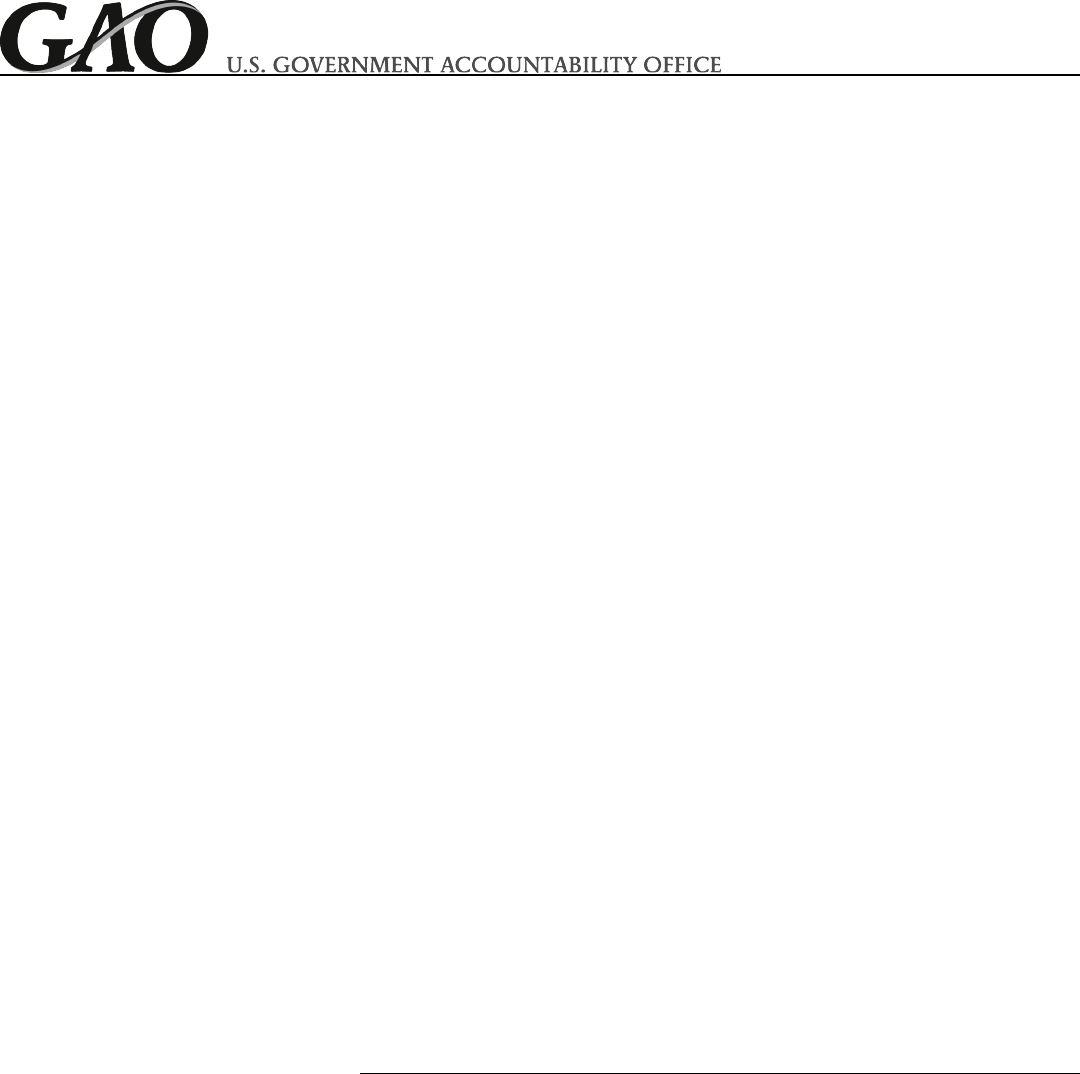
Page 1 GAO-16-614 Payment System Competition
441 G St. N.W.
Washington, DC 20548
August 30, 2016
The Honorable Jeb Hensarling
Chairman
Committee on Financial Services
House of Representatives
Dear Mr. Chairman:
With the value of checks and electronic payment transfers exceeding a
quadrillion dollars in 2015, a reliable and efficient payments system is
essential for the economic stability of the United States. The Board of
Governors (Board) and the 12 Federal Reserve Banks of the Federal
Reserve System (Federal Reserve) play multiple roles in the payments
system, including functioning as the nation’s central bank, supervising
financial institutions, and providing payment services to market
participants. The Reserve Banks offer a range of payment services to
depository institutions and the federal government, including collecting
checks; electronically transferring funds; issuing, transferring, and
redeeming U.S. government securities; distributing and receiving
currency and coin; and maintaining accounts for reserve and clearing
balances.
1
The Board oversees the operations of the Reserve Banks and
serves as a regulator of certain aspects of payment services in the United
States. As part of its oversight, the Board issues regulations that apply to
the payment services activities of the Reserve Banks and the private-
sector entities that compete with them. Where these roles potentially
overlap or conflict, the Federal Reserve faces the challenge of managing
or separating the roles in ways that help ensure it fulfills each role without
exerting undue influence or giving itself an advantage at the expense of
1
As the nation’s central bank, one of the Federal Reserve’s tools for conducting monetary
policy is the setting of reserve requirements that mandate that all depository institutions
hold a percentage of certain types of deposits as reserves in the form of vault cash, as a
deposit in the institution’s account at a Federal Reserve Bank, or as a deposit in a pass-
through account at a correspondent institution (one that provides check clearing and other
services for other institutions). See 12 U.S.C. §§ 248, 461; 12 C.F.R. § 204.5(a), (d). More
than 6,000 U.S. depository institutions maintain a Federal Reserve account at the Reserve
Bank in their district and about 1,900 of these account holders maintain balances for the
purposes of satisfying reserve requirements on behalf of themselves or other depository
institutions, and these accounts also can be used to settle payments.
Letter

the banking industry or its private-sector competitors in providing payment
services.
In 2000, we reviewed the potential conflicts of interest posed by the
Federal Reserve’s operation of a payment system that competes with
private-sector systems operated and owned by institutions that the
Federal Reserve also supervises.
Page 2 GAO-16-614 Payment System Competition
2
We found no evidence to suggest that
the Federal Reserve had not adequately separated its multiple roles in
the payments system. However, the overall U.S. payments system has
evolved since our 2000 report. Technology has dramatically changed
many aspects of the payments process, notably in the transition from the
use and settlement of paper checks to electronic payments. In addition,
the Federal Reserve has begun publicly exploring how the United States
can develop a near real-time payment system to facilitate payments
between individuals and businesses as several other countries are
moving to. When Congress mandated that the Reserve Banks offer
payment services to nonmember depository institutions on terms
comparable to those for member banks, it also required that the Banks
publish prices for these services that were established over the long run
on the basis of all the direct and indirect costs actually incurred in
providing the services, including certain imputed costs that would have
been incurred if the services had been furnished by a private firm.
You asked us to update our 2000 report and in particular, review the
Federal Reserve’s management of its potential conflicts of interest in the
U.S. payments system, including issues relating to the costs and pricing
of its services. This report examines (1) how effectively the Federal
Reserve captures and recovers its payment services costs; (2) the effect
of the Federal Reserve’s practices on competition in the payment
services market; (3) how the Federal Reserve mitigates the inherent
conflicts posed by its various roles in the payments system; and (4)
market participant viewpoints on the future role of the Federal Reserve in
the payments system. This report focuses on three payment system
products offered by the Federal Reserve—check clearing, electronic
payments known as Automated Clearing House (ACH) payments, and
wire transfer payments—because these are the services in which the
Federal Reserve primarily competes with private-sector entities.
2
GAO, Federal Reserve System: Mandated Report on Potential Conflicts of Interest,
GAO-01-160 (Washington, D.C.: Nov. 13, 2000).

To address these objectives, we analyzed data on the reported costs and
revenues of Federal Reserve payment services from 1996 to 2015 and
how pricing and fee structures for the services had changed over this
period. We took steps to assess the reliability of these data and
determined they were sufficiently reliable for our analysis. Although we
analyzed the processes by which the Federal Reserve accounts for its
reported costs and revenues, we did not include detailed testing of the
Federal Reserve’s cost accounting controls related to its priced services
activities. We reviewed relevant legislation and Federal Reserve policies,
regulations, and guidance relevant to payment services activities. We
reviewed audits that external and internal audit organizations performed
of Federal Reserve payment system costs and activities. We also
reviewed the Federal Reserve’s policies that outline the criteria it would
consider before offering a new payment service. We interviewed Board
and Reserve Bank staff and 34 market participants, including financial
trade associations whose members participate in payment systems and
issue rules governing payment system activities; payment services
providers, including those that compete with the Federal Reserve; and
banks and credit unions that were end users of payments systems
services from other private-sector providers and the Federal Reserve.
The sample of banks and the sample of credit unions we interviewed
were both composed of a nonprobability stratified sample based on tiers
by asset size, including interviewing the five largest banks and randomly
selecting a number of banks from the large, mid-sized, and smaller tiered
banks. For credit unions we randomly selected institutions from larger and
from smaller credit unions. We also interviewed both financial institution
and nonbank entities that provided competing payments services
randomly selected within type of institution. We also interviewed staff from
the Department of Justice about competition issues. For more information
on our methodology, see appendix I.
We conducted this performance audit from November 2014 to August
2016 in accordance with generally accepted government auditing
standards. Those standards require that we plan and perform the audit to
obtain sufficient, appropriate evidence to provide a reasonable basis for
our findings and conclusions based on our audit objectives. We believe
that the evidence obtained provides a reasonable basis for our findings
and conclusions based on our audit objectives.
The Federal Reserve has long had a role in the U.S. payments system.
One of the major impetuses for the creation of the Federal Reserve was
to reduce the potential for disruptions in payments that periodically
Page 3 GAO-16-614 Payment System Competition
Background

occurred in the United States. During a financial crisis in 1907 stemming
from losses arising from the San Francisco fire and the failure of the
Knickerbocker Trust in New York City, payments were largely suspended
throughout the country because many banks and clearinghouses, which
served as centralized locations for banks to exchange checks for clearing,
refused to clear checks drawn on certain banks. These refusals led to
liquidity problems in the banking sector and the failure of otherwise
solvent banks, which exacerbated the impact of the crisis on businesses
and individuals.
With the passage of the Federal Reserve Act, Congress established the
Federal Reserve in 1913 in part as a response to these events.
Page 4 GAO-16-614 Payment System Competition
3
The
Federal Reserve Act also directed the Federal Reserve to supply
currency in the quantities demanded by the public and gave it the
authority to establish a national check-clearing system. Previously, some
paying banks (on which checks had been drawn) had refused to pay the
full amount of checks (nonpar collection) and some had been charging
other fees to the banks presenting checks to be paid. To avoid paying
these presentment fees, many presenting banks routed checks to banks
that were not charged presentment fees by paying banks. This circuitous
routing resulted in extensive delays and inefficiencies in the check-
collection system. In 1917, Congress amended the Federal Reserve Act
to prohibit banks from charging the Reserve Banks presentment fees and
to authorize nonmember banks as well as member banks to collect
checks through the Federal Reserve System.
4
As the nation’s central bank, the Federal Reserve manages U.S.
monetary policy, supervises certain participants in the banking system,
and serves as the lender of last resort. The Federal Reserve System
consists of the Board of Governors in Washington, D.C., and 12 Reserve
Banks with 24 branches located in 12 districts across the nation. The
Board is a federal agency, and the Reserve Banks are federally chartered
and organized like private corporations each with a board of directors and
with their shares owned by their member banks. The Board is responsible
for maintaining the stability of financial markets, supervising banks that
are members of the Federal Reserve and bank and savings and loan
holding companies, and overseeing the operations of the Reserve Banks.
3
Federal Reserve Act, Pub. L. No. 63-43, 38 Stat. 251 (1913).
4
Pub. L. No. 65-25, 40 Stat. 232 (1917).

The Board has delegated some of these responsibilities to the Reserve
Banks, which also provide payment services to depository institutions and
government agencies. As a result, the Federal Reserve has dual roles as
both payment systems operator and as a regulator of payment system
participants.
The role of the Federal Reserve Banks as a provider of several payment
services in the United States contrasts with that of the central banks of
other countries. According to a study by the Bank for International
Settlements, which provides services to other central banks, of the 13
foreign jurisdictions examined, central banks in 11 operated large value
payment transfer systems—as the Reserve Banks do—but only 2 central
banks (those in Belgium and Germany)—also operated check-clearing
and electronic retail payment networks.
Page 5 GAO-16-614 Payment System Competition
5
To improve the functioning of check services, Congress instituted a par-
value (face value) check collection service to simplify the check-clearing
process in the Federal Reserve Act, and gave the Federal Reserve
operational (through the Reserve Banks) and regulatory (through the
Board) roles in check collection. Interbank checks are cleared and settled
through a check-collection process that includes presentment and final
settlement.
6
Presentment occurs when checks are delivered by the bank
that received them—which currently almost exclusively involves
transmission of electronic images—to paying banks for payment. The
checks may be sent either directly to the paying bank or through another
entity—either another bank, a check clearinghouse, or a correspondent
bank—that would ultimately deliver them to the paying banks (see fig. 1).
The paying banks then decide to honor or return the checks. Settlement
ultimately occurs when collecting banks are credited and paying banks
debited, usually through accounts held at a Reserve Bank or at
correspondent banks that provide check clearing and other services for
other institutions. As part of its role in regulating check collection, the
5
See Bank for International Settlements, Committee on Payment and Settlement Systems
of the Group of Ten Countries, Payment and Settlement Systems in Selected Countries,
(Basel, Switzerland, April 2003). The 13 foreign jurisdictions reviewed were those in
Belgium, Canada, the Euro area, France, Germany, Hong Kong, Italy, Japan,
Netherlands, Singapore, Sweden, Switzerland, and the United Kingdom.
6
Interbank checks are those in which the bank of first deposit and the paying bank are
different. “On-us” checks are deposited or cashed at the same bank on which they are
drawn.

Federal Reserve Board promulgated regulations that govern various
aspects of these processes, including Regulation CC (which covers how
quickly banks must make funds from checks and other deposits available
for withdrawal and governs aspects of interbank check collection and
return), and Regulation J (which covers how institutions can collect and
return checks and other items through the Reserve Banks).
Page 6 GAO-16-614 Payment System Competition
7
Figure 1: Steps Involved in a Typical Check Payment in the United States
7
For Regulation CC, see 12 C.F.R. pt. 229. Section 1086 of the Dodd-Frank Wall Street
Reform and Consumer Protection Act amended the Expedited Funds Availability Act to
make the Board’s authority for the EFA Act’s provisions implemented in Subpart B of
Regulation CC joint with the Consumer Financial Protection Bureau. Pub. L. No. 111-203,
§ 1086, 124 Stat. 1376, 2085 (2010). For Regulation J, see 12 C.F.R. pt. 210.

To facilitate electronic check processing, some banks can create an
electronic image of a paper check at their branches, while others
transport the paper to centralized locations where the paper is imaged.
Page 7 GAO-16-614 Payment System Competition
8
After imaging, an image cash letter is assembled and sent directly to a
paying bank, an intermediary bank, or to a collecting bank (such as a
Reserve Bank or a correspondent bank) or to an image exchange
processor for eventual presentment to the paying bank. The Reserve
Banks offer imaged check products—FedForward, FedReceipt, and
FedReturn—for a fee to banks that use its check collection services to
present checks for payment at other institutions.
9
Similarly, other entities
that offer check-clearing services charge fees or use other mechanisms
to obtain compensation for such services, or institutions may not charge
each other when directly exchanging images.
The Fedwire Funds Service (Fedwire), the Federal Reserve’s wire
payments service, began in 1918 as a funds transfer service and initially
used Western Union’s telegraph lines to transmit payments.
10
The current
Fedwire network provides a real-time gross settlement system in which
about 6,000 participants can initiate electronic funds transfers that are
immediate, final, and irrevocable. Depository institutions and others that
maintain an account with a Reserve Bank can use the service to send
payments directly to, or receive payments from, other participants.
Depository institutions also can use a correspondent relationship with a
8
Some check images are created by bank customers through a process called remote
deposit capture.
9
According to Federal Reserve staff, FedForward is a Reserve Bank service in which
checks are deposited with a Reserve Bank and presented for collection either as
substitute checks or electronically using image cash letters. (A cash letter is a group of
checks packaged and sent by one bank to another bank, clearinghouse, or a Reserve
Bank office. A cash letter is accompanied by a list containing the dollar amount of each
check, the total amount of the checks, and the number of checks sent with the cash letter.)
FedReceipt is a Reserve Bank service in which a paying bank agrees to permit the
Reserve Banks to present checks to it electronically. FedReturn is a Reserve Bank service
that permits paying banks to return checks to depository banks by sending image cash
letters to the Reserve Banks, which will return the checks in image cash letters or as
substitute checks to the depository banks.
10
In addition to the Fedwire Funds service, the Reserve Banks also provide the Fedwire
Securities Service, a securities settlement system that enables participants to hold,
maintain, and transfer eligible securities, including those issued by the U.S. Department of
the Treasury, other federal agencies, government-sponsored enterprises, and certain
international organizations, such as the World Bank. Securities are held and transferred in
book-entry form. This report will refer to the Fedwire Funds service as Fedwire.
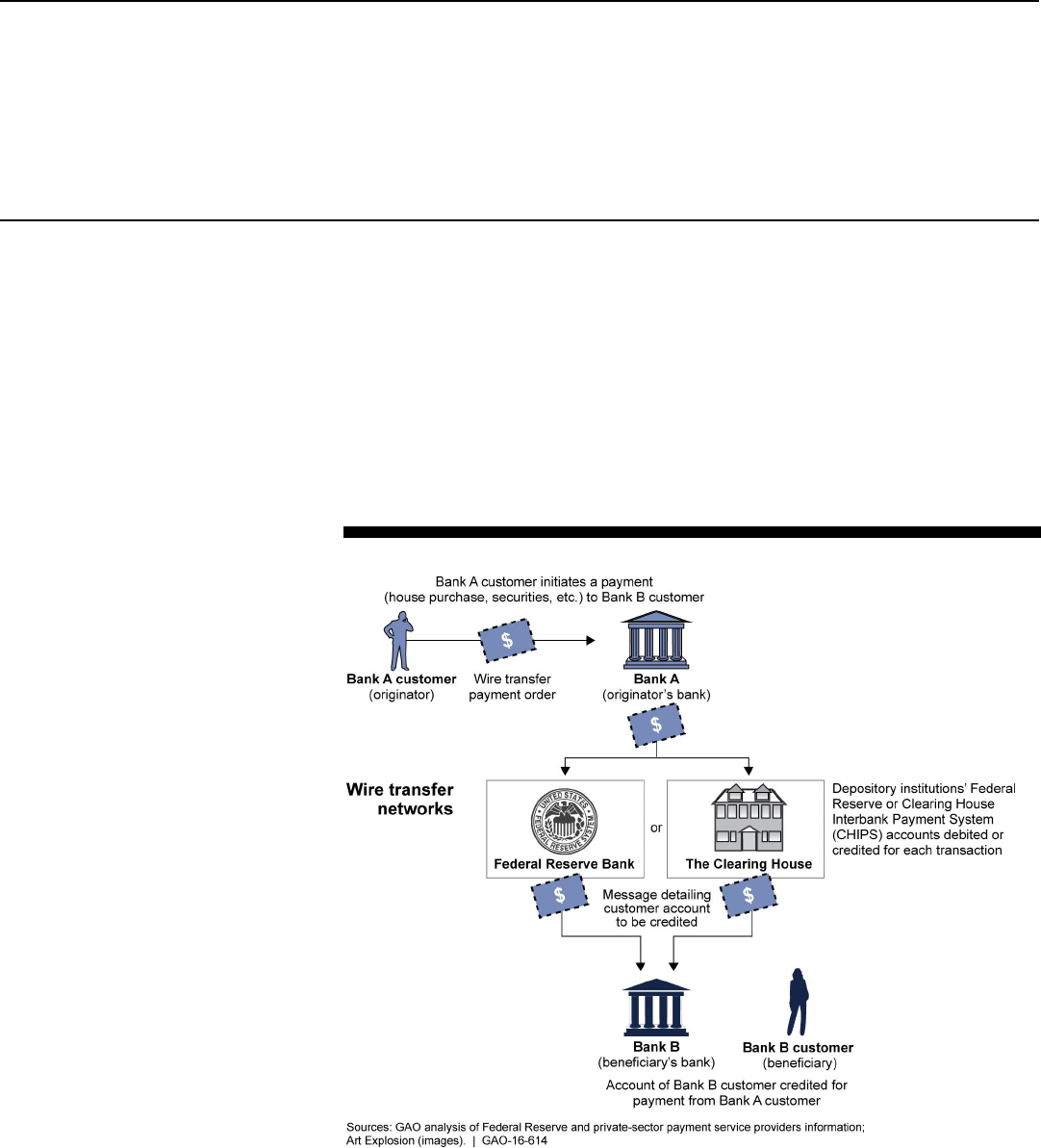
Fedwire participant to make or receive transfers indirectly through the
system. Participants use Fedwire to handle time-critical payments (such
as settlement of interbank purchases, sales of federal funds, securities
transactions, real estate transactions, or disbursement or repayment of
large loans). The U.S. Department of the Treasury, other federal
agencies, and government-sponsored enterprises also use Fedwire to
disburse and collect funds. A private-sector entity, The Clearing House
Payments Company L.L.C. (TCH), operates a competing wire transfer
service—the Clearing House Interbank Payment System (CHIPS)—that is
used for similar purposes as Fedwire. Figure 2 shows how a typical wire
transfer payment occurs.
Figure 2: Steps Involved in a Typical Wire Transfer Payment in the United States
Page 8 GAO-16-614 Payment System Competition
In response to concerns over high volumes of paper checks in the
payments system, the Federal Reserve worked with the private sector in
the 1970s to develop an electronic system to exchange payments known
as Automated Clearing House (ACH). These payments are often used for
small or recurring transactions, such as direct deposit of payrolls or

payment of utility, mortgage, or other bills. The Reserve Banks’ Retail
Payments Office operates an ACH payment network (called FedACH). By
agreement (in the form of an operating circular), ACH transactions are
conducted under rules and operating guidelines developed by a nonprofit
banking trade association, NACHA (formerly the National Automated
Clearing House Association). With limited exceptions, Federal Reserve
staff indicated that the Reserve Banks incorporate the association’s rules
by reference in their ACH operating circulars, which represents the
agreement between a Reserve Bank and its customers on the terms and
conditions of the FedACH services. TCH also operates its own ACH
network—the Electronic Payments Network—through which its members
can transmit and receive ACH payments to or from the customers of their
institutions. The Federal Reserve and TCH exchange ACH payments
originated by their customer institutions that are bound for institutions
using the other’s ACH network. Both the sending and the receiving
institutions typically are charged fees for ACH transactions. Figure 3
illustrates a typical ACH payment.
Page 9 GAO-16-614 Payment System Competition
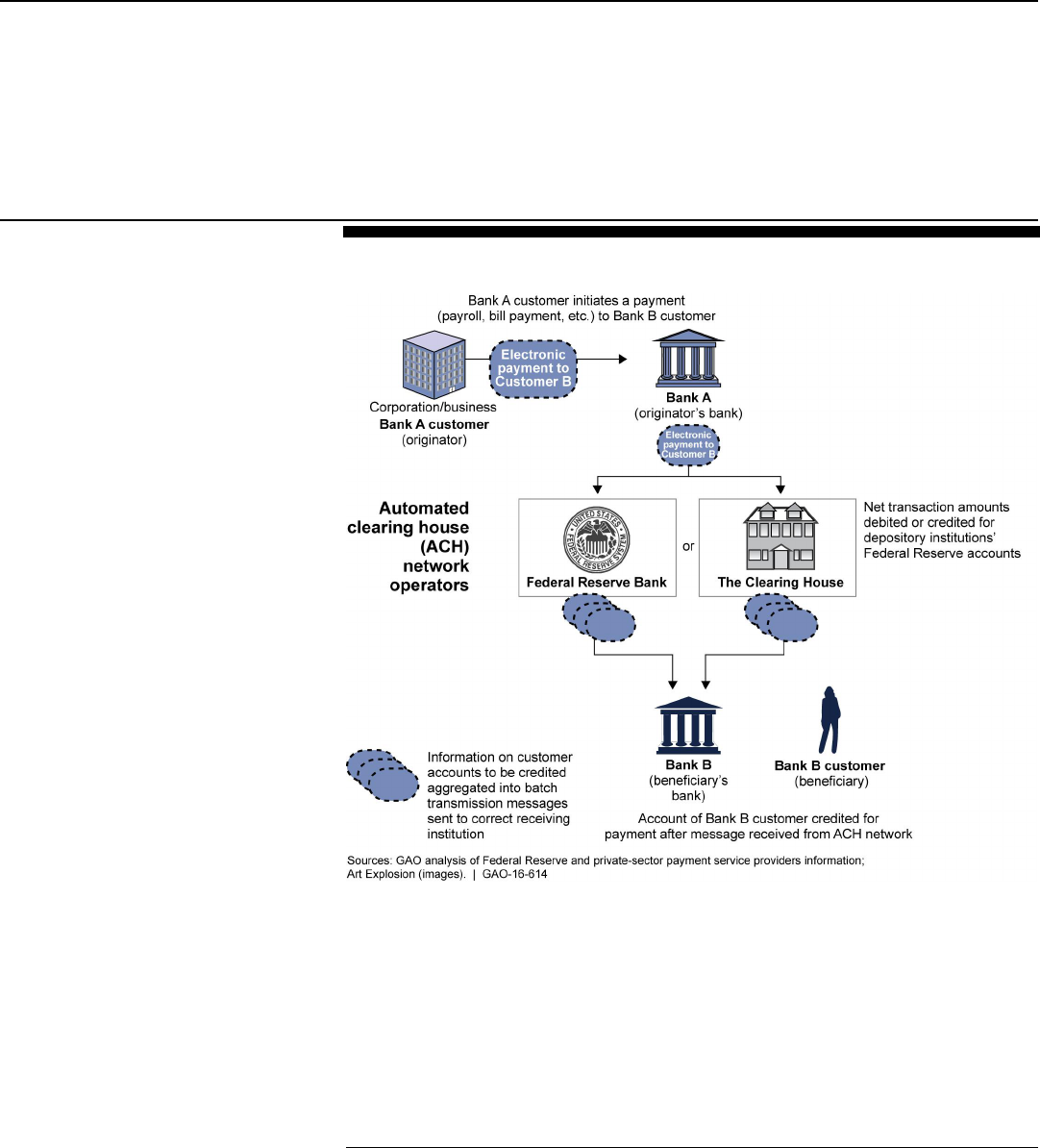
Figure 3: Example of Steps Involved in an Automated Clearing House Payment from
Page 10 GAO-16-614 Payment System Competition
a Business to an Individual in the United States
In 1980, Congress enacted changes that expanded the role of the
Federal Reserve in the payments system. The Monetary Control Act of
1980 (Monetary Control Act) extended the Federal Reserve’s reserve
requirements to all depository institutions, not just member banks of the
Federal Reserve.
11
The act also allowed the Reserve Banks to offer
payment services to all depository institutions that had previously been
available at no cost to their members. Part of the legislative history of the
11
Pub. L. No. 96-221, Tit. I, 94 Stat. 132, 132 (1980). Requiring that depository institutions
hold a percentage of certain types of deposits as reserves in the form of vault cash or as
deposits at accounts at a Federal Reserve Bank or a correspondent institution is one of
the tools the Federal Reserve uses for conducting monetary policy. This act’s extension of
these reserve requirements to all institutions was to increase their effectiveness in
achieving desired changes in the money supply.

Monetary Control Act indicates that since the act required nonmember
institutions to meet reserve requirements, it was reasonable to also
provide such institutions with access to Reserve Bank payment
services.
Page 11 GAO-16-614 Payment System Competition
12
At this time, the act required the Federal Reserve to begin
charging all institutions for such services.
Because this change placed the Reserve Banks and private-sector
providers of payment services in competition with each other, the act
included certain requirements to encourage competition between the
Reserve Banks and private-sector providers to ensure provision of
payment services at an adequate level nationwide. The Monetary Control
Act required the Board to establish a fee schedule for Reserve Bank
payment services, under which all services are required to be priced
explicitly. The act also required that over the long run, fees be established
on the basis of all direct and indirect costs actually incurred in providing
the priced services, including imputed costs that would have been
incurred by a private-sector provider, giving due regard to competitive
factors and the provision of an adequate level of such services
nationwide.
13
In describing the policies adopted to implement the
12
126 CONG. REC. 6897 (1980) (statement of Sen. Proxmire).
13
12 U.S.C. § 248a. The Monetary Control Act requires that the Federal Reserve Board
establish the schedule of fees for the following services: (1) currency and coin services;
(2) check clearing and collection services; (3) wire transfer services; (4) automated
clearing house services; (5) settlement services; (6) securities safekeeping services; (7)
Federal Reserve float; and (8) any new services that the Federal Reserve System offers,
including but not limited to payment services to effectuate the electronic transfer of funds.
The act also directed the Board to publish (for public comment) a set of pricing principles
and a proposed schedule of fees based on those principles and then to put into effect the
fee schedule which is based on those principles. The schedule of fees prescribed must be
based on enumerated principles: (1) All Federal Reserve Bank services covered by the
fee schedule shall be priced explicitly. (2) All Federal Reserve Bank services covered by
the fee schedule shall be available to nonmember depository institutions and such
services shall be priced at the same fee schedule applicable to member banks, except
that nonmembers shall be subject to any other terms, including a requirement of balances
sufficient for clearing purposes, that the Board may determine are applicable to member
banks. (3) Over the long run, fees shall be established on the basis of all direct and
indirect costs actually incurred in providing the Federal Reserve priced services, including
interest on items credited prior to actual collection, overhead, and an allocation of imputed
costs, which takes into account the taxes that would have been paid and the return on
capital that would have been provided had the services been furnished by a private
business firm, except that the pricing principles shall give due regard to competitive
factors and the provision of an adequate level of such services nationwide. (4) Interest on
items credited prior to collection shall be charged at the current rate applicable in the
market for federal funds.

requirements of the Monetary Control Act, the Board stated that the act’s
legislative history indicated Congress sought to encourage competition to
ensure that these services would be adequately available nationwide and
at the lowest cost to society. According to these Board policies, the
Reserve Banks provide payment services to promote the integrity and
efficiency of the payments mechanism and ensure that payment services
are provided to all depository institutions on an equitable basis and in an
environment of competitive fairness.
Page 12 GAO-16-614 Payment System Competition
14
In participating in the payments system, the Federal Reserve has taken
various actions to make the system more efficient. For example, in the
1950s the Federal Reserve contributed to the adoption of magnetic ink
character recognition, which allowed routing and other processing
information to be printed in machine-readable ink on the bottom of the
check’s face, which helped automate check processing. As discussed
earlier, the Federal Reserve worked with the private sector to develop the
ACH system in the 1970s. Initially, ACH volumes were low with most
volume growth attributed to government-initiated transactions, because
high startup costs made private-sector banks reluctant to invest in and
use the network. For a few years following the implementation of the
Monetary Control Act, the Federal Reserve subsidized the ACH network,
which helped the network obtain sufficient volume to become successful.
To improve the clearing of checks, Congress passed the Check Clearing
for the 21st Century Act (Check 21), which became effective October 28,
2004, which was legislation supported by the Federal Reserve.
15
Check
21 facilitates check truncation, which is the substitution of the original
physical check with a legal equivalent (called a substitute check).
16
According to the trade association that establishes rules for exchanging
check images, checks are generally processed as images.
14
Federal Reserve System, Policies: The Federal Reserve in the Payments System,
Issued 1984, revised in 1990.
15
Pub. L. No. 108-100, 117 Stat. 1177 (2003).
16
According to Federal Reserve staff, banks are required to present paper checks unless
they have the agreement of the paying bank to accept electronic presentment. By creating
the concept of a substitute check, this act allowed banks earlier in the collection chain to
transmit electronically because the presenting bank has a means of creating the legal
equivalent of the paper check for presentment if need be (and likewise paying banks that
have some legal obligation to provide “original” checks were able to provide a substitute
check).

In 1998, a committee of senior Federal Reserve executives examined
whether the Federal Reserve’s participation in the payments system
remained justified in light of changes occurring in the financial services
and technology sectors at the time. This committee’s report addressed
the results of its review of the role the Federal Reserve played in the use
of checks and ACH payments in the retail payments system, including
considering whether any changes in its role could affect the integrity,
efficiency, and accessibility of this system.
Page 13 GAO-16-614 Payment System Competition
17
After examining check-
clearing activities, the committee concluded that Reserve Banks’
withdrawal from the check collection market would disrupt the system in
the short-run, with little promise of substantial benefit over the longer run.
The committee noted that withdrawing from check clearing could increase
check collection prices to small and remote depository institutions and
could disrupt the migration from paper to electronic payments. Similarly,
the report concluded that having the Reserve Banks remain in the ACH
market would be more conducive to the future efficiency and migration to
electronic payments, including joint efforts with industry participants to
spur innovation in products and increase ACH usage.
In addition to the Reserve Banks, other entities offer payment system
services to financial institutions. To process check payments, financial
institutions can set up direct, individual connections with other financial
institutions with which they can exchange check images for clearing of
checks drawn on the accounts of their respective customers. Institutions
also can submit their checks to clearinghouses that process and transmit
check image files for clearing to the respective clearinghouse members
on which the checks are drawn. For example, in addition to operating the
only other ACH and wire transfer networks that compete with the offerings
of the Federal Reserve, TCH also acts as a clearinghouse for check
images. Other competitors that provide checking services include
correspondent banks, bankers’ banks, and corporate credit unions. The
financial institution customers of these entities will send or receive their
checks, ACH payments, or wire transfers using these entities’ systems,
17
See Committee on the Federal Reserve in the Payments Mechanism, Federal Reserve
System, The Federal Reserve in the Payments Mechanism, (January 1998). This study
excluded cash processing, a service normally expected of a central bank, as well as credit
and debit card processing in which the Reserve Banks play no direct operational role. The
study also excluded other “wholesale” payment services of the Reserve Banks, such as
large-value funds and Fedwire securities transfers.
OtherEntitiesInvolvedin
thePaymentsSystem

which may pass them to other entities, including individual institutions,
TCH, or the Reserve Banks, for processing. Some financial institutions
also use nonfinancial third-party data processors that aggregate
payments for these services and route them to other entities, including
the Reserve Banks or their competitors, for processing.
From 2000 through 2012, total noncash payments grew, and check
volumes declined, as the use of other payments types increased.
According to data the Federal Reserve reported in 2013, noncash
payments—including those made with debit cards, credit cards, ACH, and
prepaid cards (but excluding wire transfers)—grew almost 69 percent
from 2000 to 2012.
Page 14 GAO-16-614 Payment System Competition
18
The fastest growing payment method was debit
cards, whose use grew by more than 466 percent over this period. The
number of ACH payments also grew by more than 255 percent, while the
number of check payments declined by more than 56 percent. Figure 4
shows how the use of payment types changed in this period.
18
Board of Governors of the Federal Reserve System, The 2013 Federal Reserve
Payments Study: Recent and Long-Term Trends in the United States: 2000–2012,
detailed report and updated data release (Washington, D.C.: July 2014). This is the
Federal Reserve’s most recent triennial study of payment market trends, which publishes
payment statistics for a single point in time every 3 years.
CheckVolumesDeclineas
UseofOtherPayment
TypesRises
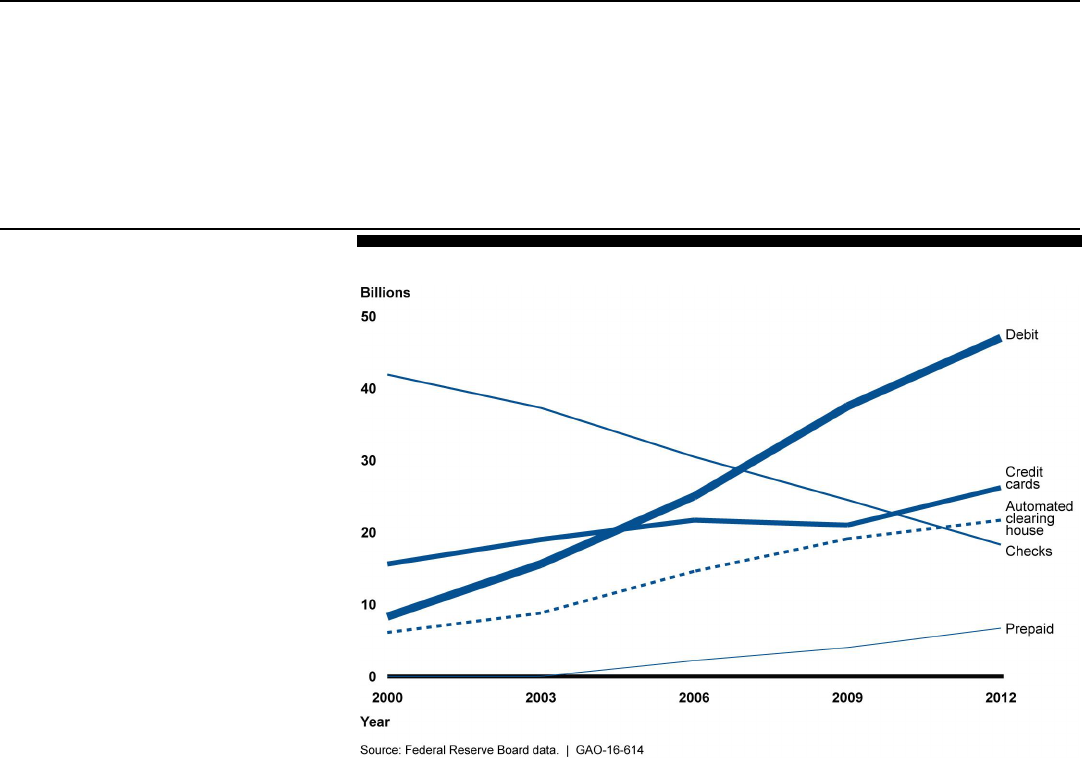
Figure 4: U.S. Noncash Payments by Transaction Type, 2000–2012
Page 15 GAO-16-614 Payment System Competition
The changes in the relative use of the various payment methods largely
reflect consumers switching from check use to card-based or other
payment methods. According to the Federal Reserve’s analysis,
consumers wrote about 8 billion fewer checks to businesses in 2012 than
they had in 2006, and businesses wrote 4 billion fewer checks in 2012 to
consumers or other businesses than they had in 2006. Federal Reserve
staff noted that although check volumes have declined, the dollar value of
payments made by checks—estimated by the checking industry
association to exceed $20 trillion in 2013—indicates that checks are still
an important payment method in the United States because businesses
continue to use them to make payments to other businesses.
The growth in ACH payments encompassed its increased use for making
various types of payments, including for payroll deposits and automatic
bill payments, as well as increased use by consumers to make one-time
payments over the Internet. Although it had not obtained the volume of
wire transfers as part of past triennial reports, the Federal Reserve
analysis estimated that more than 287 million wire transfers occurred in
2012, with a combined value of about $1,116 trillion. Consumer senders
accounted for just 6 percent of total wire transfers in 2012.

The Federal Reserve Banks incur various costs as part of their provision
of payment services. To fully account for these costs, the Federal
Reserve uses a detailed accounting system for accumulating and
reporting cost, revenue, and volume data for the payment and other
services Reserve Banks conduct. The Federal Reserve’s cost-accounting
practices generally align with those used in the private sector and with
cost-accounting standards for federal entities. As part of setting fees for
its payment services, the Federal Reserve is required to also impute
some additional costs that it would have incurred if it were a private entity.
Although various options could be used to calculate these imputed costs,
each with their own trade-offs or methodological challenges, the current
methodology the Federal Reserve uses appears reasonable. However,
the Federal Reserve is not currently including certain costs that its
private-sector competitors may incur, including costs related to integrated
planning for recovery and orderly wind down of operations. According to
Federal Reserve data from 1996 through 2015, the Federal Reserve
Banks generally recovered the identified costs of providing payment
services, as required by the act. Although the Federal Reserve has
various internal controls to help ensure it accurately captures its payment
services costs, it has not obtained a detailed, independent evaluation of
the reliability of these processes in over three decades.
The Federal Reserve Banks use a detailed cost accounting system that
helps them meet several requirements relating to how to set the fees
charged for payment services and account for and recover the costs
incurred in providing them. The Monetary Control Act requires that over
the long run the Federal Reserve’s fees be established on the basis of all
direct and indirect costs incurred in providing payment services, and an
allocation of imputed costs that would have been incurred by a private-
sector provider. Because the Board must set fees based on the total of
these costs, failure to account for all of its actual costs could result in the
Federal Reserve underpricing its services and competing unfairly with
private-sector providers.
According to data provided to us by the Federal Reserve, the Federal
Reserve Banks incurred over $410 million in actual costs as part of
providing payment services in 2014. These costs include personnel costs,
such as salaries and benefits of employees who perform payment
services activities, as well as those associated with equipment, materials,
supplies, shipping, and other costs for payment services activities.
Additionally, costs associated with overhead and support services
(activities benefitting multiple Reserve Banks, but performed under a
Page 16 GAO-16-614 Payment System Competition
FederalReserveHas
ProcessesinPlaceto
ComplywithCost
Recovery
Requirements
FederalReserveUsesa
DetailedSystemfor
AccountingfortheFull
CostsAssociatedwithIts
PaymentServices

centralized function) are allocated to the payment services. For example,
expenses associated with functions such as sales and accounting are
categories of support costs for payment services activities. The majority
of the actual costs the Federal Reserve incurs in providing payment
services—78 percent in 2014—are support costs related to activities such
as developing software applications, implementing information security,
and providing help desk services.
The Planning and Control System (PACS) Manual for the Federal
Reserve Banks establishes cost-accounting policies and provides a
uniform reporting structure for accumulating and reporting cost, revenue,
and volume data for the payment and other services conducted by the
Reserve Banks.
Page 17 GAO-16-614 Payment System Competition
19
This system establishes a set of rules and procedures
used to determine the full cost of these services. Costs are accounted for
at the individual Reserve Bank level and subsequently aggregated to
reflect costs for all payment services throughout the Federal Reserve
System.
Federal Reserve staff told us that the cost-accounting practices in the
PACS manual generally align with practices used in the private sector.
Additionally, based on our analysis, these practices align with cost-
accounting standards developed for federal entities. While generally
accepted accounting standards exist for the preparation of financial
statements, no single set of authoritative or uniform standards have been
developed that apply to the cost accounting practices used in the private
sector. In the private sector, systems like PACS typically are used to
provide management with internal information for making decisions on
cost efficiency and capability.
Although no single or uniform set of standards apply to cost accounting
practices in the private sector, Federal Reserve staff acknowledged that
information from PACS helps them manage their operations similar to the
way in which other organizations use cost accounting information.
19
Cost accounting is the accounting process that aims to capture an entity’s costs of
production by assessing the costs associated with the various inputs and steps of
production as well as fixed costs such as depreciation of capital equipment. While cost
accounting is often used within an entity to aid in decision making, financial accounting
information is what is presented to those outside the organization. Financial accounting is
a different representation of costs and financial performance that includes the entity’s
assets and liabilities.
FederalReserveBanks’
CostAccountingPractices
AlignwithPrivate-Sector
PracticesandFederal
Standards

However, they noted that their cost accounting system is detailed and
granular to ensure that they account for all costs when pricing their
payment services as required. The Board engaged an independent public
accounting firm to conduct an evaluation of its payment services pricing
methodology in 1984. This accounting firm’s evaluation included testing
whether costs incurred by the Reserve Banks were adequately captured
and whether support and overhead costs were appropriately allocated.
This auditor’s report concluded that the Federal Reserve’s accounting
and reporting systems that captured its payment services revenues and
costs were operating effectively. In addition, the accounting firm noted
that its testing confirmed that PACS had adequate controls that were
being followed and ensured that costs were being accurately captured.
Furthermore, representatives of the independent public accounting firm
that conducted the 2014 financial audit of the financial statements of the
Federal Reserve System told us that the Reserve Banks have thorough
and redundant internal controls for financial reporting even in comparison
to many commercial organizations. The representatives of this firm told us
that their audits of the expense categories that appear in the Federal
Reserve’s financial statements had not identified significant problems.
They noted that this likely reflected the Federal Reserve’s thorough
system of controls. However, the representatives of this firm told us that
they had not audited the expenses allocated to the payment services
specifically.
In addition, our analysis indicated that the Federal Reserve’s cost
accounting practices aligned with broad cost accounting standards for
federal entities. The Federal Accounting Standards Advisory Board
developed the Statement of Federal Financial Accounting Standards 4:
Managerial Cost Accounting Standards and Concepts (SFFAS 4) to help
federal entities provide reliable and timely information on the full cost of
federal programs. Reserve Banks are not required to comply with these
accounting standards because they are not a government agency but
rather federally chartered corporations. However, to provide one measure
of the quality of the Federal Reserve’s practices, we compared PACS
with the requirements of the cost accounting standard for federal entities.
SFFAS 4 directs government entities to meet five standards for their cost
accounting, and our analysis indicated that the Federal Reserve’s PACS
Page 18 GAO-16-614 Payment System Competition

addressed each of these.
Page 19 GAO-16-614 Payment System Competition
20
For example, as prescribed in SFFAS 4,
PACS defines specific responsibility segments and provides the Reserve
Bank a process for accounting for the full costs of their services. Based
on this analysis, we concluded that the design of the Federal Reserve’s
system generally aligned with the elements recommended by the
standard. See appendix II for further details on the Reserve Banks’ cost
accounting practices.
Based on our analysis and discussions with market participants and
financial experts, the methodology the Federal Reserve uses to calculate
imputed payment services costs appears reasonable, but some market
participants noted that alternate methodologies might be more
appropriate. As previously discussed, the Monetary Control Act requires
the Federal Reserve to establish fees on the basis of direct and indirect
costs, including an allocation of imputed costs which takes into account
the taxes that would have been paid and the return on capital that would
have been provided if a private firm had provided the services. The total
of the imputed costs and return on capital is referred to as the private-
sector adjustment factor (PSAF). The Board approves the PSAF annually
as part of its annual process for approving fees for the Reserve Banks’
priced services. The PSAF methodology calculates four additional costs
that a typical private-sector payment services provider would incur: debt
financing costs, equity financing costs (or return on equity), taxes, and
payment services’ share of Federal Reserve Board expenses.
21
See
appendix III for further details on the PSAF methodology.
Over the years, the PSAF has declined significantly, following similar
trends in declining transactions, revenues, and assets associated with the
Federal Reserve Banks’ payment service activities. Following declining
payment services revenues and assets, as well as changes in practices
20
The five standards are (1) accumulating and reporting costs of activities on a regular
basis for management information purposes, (2) establishing responsibility segments to
match costs with outputs, (3) reporting full costs of goods and services, (4) recognizing the
costs of goods and services provided from federal entities, and (5) using appropriate
costing methodologies to accumulate and assign costs to outputs.
21
Federal Reserve officials said that the Board Expenses included in the PSAF are real
expenses that represent the costs associated with the Board’s supervision of the Reserve
Banks’ payment services. They noted that Board expenses are included in the PSAF
because they are not captured in PACS, as that cost accounting system only captures real
costs incurred by the Reserve Banks.
FederalReserve’sCurrent
ProcessforSimulating
Private-SectorCosts
AppearsReasonable,but
DoesNotCurrently
AccountforCertainCosts

among payment services customers, the total imputed costs arising from
the Federal Reserve’s PSAF calculations declined from $150 million in
2002 (or an inflation-adjusted basis of nearly $194 million using 2015
dollars) to $13 million in 2016. However, as a percentage of total payment
services assets, the PSAF increased slightly from 1.3 percent to 1.5
percent during this period. Federal Reserve staff said that they use
publicly available information to calculate the imputed elements of their
PSAF methodology and publish the methodology and its results annually
in the Federal Register. Additionally, all proposed and finalized changes
to the PSAF methodology, as well as a summary of the public comments
on these changes, are published in the Federal Register and posted to
the Federal Reserve’s website. Federal Reserve staff indicated that they
follow this approach to help ensure that the PSAF methodology is
transparent and that its results can be more easily verified by the private
sector.
As part of its attempts to improve its accuracy and conform the PSAF to
changes in the payment system market, Federal Reserve staff noted that
the Board has made numerous changes to the methodology over the
years. The Federal Reserve staff said that they consider changes to the
PSAF methodology when conditions in the marketplace or industry
suggest that practices in the markets or other changes have occurred that
should be considered in the methodology for imputing costs. They said
that in those situations they evaluate different options to improve the
methodology and request public comments on the strongest options
before adopting a new approach. We reviewed the changes made
between 1980 and 2014 and found that the Federal Reserve had publicly
sought comment on significant changes to its PSAF methodology 10
times during this period. These include changes to how the return on
equity is calculated and to the peer group used to approximate the levels
of debt and equity in the model. See appendix III for further details on
changes to the PSAF methodology over time.
Private-sector market participants have criticized the Federal Reserve for
not accounting for or imputing into the PSAF certain regulatory
compliance costs that private-sector providers incur. These costs include
those associated with federal antimoney-laundering requirements,
increased audit and risk management, overseeing the risks posed by
service vendors, and integrated planning for recovery and wind down of
operations. The Federal Reserve has said that it accounts for some of
these costs as actual expenses incurred by the Reserve Banks, and that
it has been considering how the other costs might be incorporated into
the PSAF.
Page 20 GAO-16-614 Payment System Competition
Concerns over Whether All
Relevant Costs Are Included in
the PSAF

In May 2015, the Electronic Check Clearing House Organization
(ECCHO) submitted a letter to the Board expressing concerns over the
Federal Reserve’s failure to account for certain costs being borne by
private-sector check services providers and urged it to conduct a
complete (de novo) competitive impact analysis of the Reserve Banks’
check image services. ECCHO specifically noted that many of its
members that provide check processing services to other institutions
incur costs associated with compliance with federal antimoney-laundering
requirements. In a written response sent in December 2015, the Chair of
the Federal Reserve Board’s Committee on Federal Reserve Bank Affairs
said that if private-sector banks incur material antimoney-laundering
compliance costs related to their check collection services that the
Reserve Banks do not, it might be appropriate for Reserve Banks to
impute such costs as part of the PSAF. However, Federal Reserve staff
said that correspondent banks have informed them that determining the
proportion of antimoney-laundering costs that relate to check services
specifically would be difficult, because they do not allocate compliance
costs directly to this service. Federal Reserve officials said in their
response to ECCHO that, while they did not see the need for the
complete competitive impact analysis that ECCHO requested, they
continue to consider how they could identify ways to incorporate these
costs into the PSAF methodology if they are material. However, until the
Federal Reserve determines and implements such costs into the PSAF,
the imputed costs will not reflect these actual expenses incurred by many
of the Federal Reserve’s competitors.
Additionally, enhanced regulatory standards, including those that apply to
entities designated as systemically important financial market utilities,
have raised regulatory compliance costs for the Federal Reserve’s key
competitor.
Page 21 GAO-16-614 Payment System Competition
22
Under the Dodd-Frank Wall Street Reform and Consumer
Protection Act, entities engaged in payment, clearing, or settlement
activity must be designated as systemically important by the Financial
Stability Oversight Council if the Council determines that the failure of or a
disruption to the functioning of the entity could create, or increase, the risk
of significant liquidity or credit problems spreading among financial
institutions or markets and thereby threaten the stability of the U.S.
22
Financial market utilities are any persons that manage multilateral systems for the
purpose of transferring, clearing, or settling payments, securities, or other financial
transactions among financial institutions or between financial institutions and the persons,
subject to certain exclusions. 12 U.S.C. § 5462(6).

financial system.
Page 22 GAO-16-614 Payment System Competition
23
Such entities then become subject to heightened
prudential and supervisory provisions intended to promote robust risk
management and safety and soundness. The act required the Federal
Reserve to issue rules to prescribe risk-management standards for those
financial market utilities designated as systemically significant for which
the Board is the supervisory agency. In November 2014, the Board
issued amendments to Regulation HH, based on the international risk-
management standards for payment services that are systemically
important developed by the Committee on Payment and Settlement
Systems (CPSS) and the Technical Committee of the International
Organization of Securities Commissions (IOSCO).
24
Regulation HH
requires designated financial market utilities to implement rules,
procedures, or operations designed to ensure that the financial market
utility meets or exceeds various standards, including, among others,
those relating to its governance, risk management and credit risk.
25
For
example, the entity must have an integrated plan for its recovery and
orderly wind down, maintain unencumbered liquid financial assets
sufficient to cover the greater of the cost to implement its recovery and
orderly wind-down plans and 6 months of current operating expenses,
and hold equity greater than or equal to the amount of unencumbered
liquid financial assets required.
Representatives from TCH told us that complying with these standards
has increased their regulatory compliance costs and that they question
the extent to which the Federal Reserve has appropriately incorporated
these costs into the PSAF.
26
TCH estimated that their efforts to comply
with these requirements have increased their operating costs by 10
percent, including additional costs associated with their Risk Office that
conducts activities related to information technology security, risk
management, liquidity risk and orderly recovery and wind-down planning,
23
Pub. L. No. 111-203, Tit. VIII, 124 Stat. 1376, 1802 (2010).
24
79 Fed. Reg. 65,543, 65,557 (Nov. 5, 2014) (codified at 12 C.F.R. pt. 234). The
international standards on which the revised Regulation HH was based were the
Principles for Financial Market Infrastructures (PFMI) developed by CPSS and IOSCO in
2012. Effective September 2014, the CPSS changed its name to the Committee on
Payments and Market Infrastructures.
25
12 C.F.R. § 234.3.
26
The Financial Stability Oversight Council designated TCH as a systemically important
financial market utility on the basis of its role as the operator of CHIPS.

among other things. They also said that they incur greater costs
associated with responding to their customers’ due diligence reviews
regarding vendor management, an element of the federal bank
examination process in which federal bank examiners evaluate a financial
institution’s third-party relationships as a component of their overall risk-
management processes.
The Federal Reserve has incorporated some, but not all, of these
expenses into the imputed costs it calculates as part of the PSAF.
Federal Reserve staff have said that although the Reserve Banks’
payment services are not always subject to the same regulatory regime
as similar services provided by the private sector, the Reserve Banks are
subject to Board supervision and that these oversight costs are already
included in the PSAF as Board expenses and are being recovered
through revenue from the services. Additionally, Federal Reserve staff
told us that the Reserve Banks have devoted increased resources to
audit and risk management functions and that costs associated with these
functions—including additional personnel—are captured in PACS as
internal audit costs at the product line level. Federal Reserve staff said
that the amount of these costs had increased in recent years as they
hired additional staff to perform expanded oversight activities.
Additionally, in order to foster competition with private-sector financial
market utilities that are required to hold liquid net assets funded by equity
to manage general business risk, the Federal Reserve Board requires the
Fedwire Funds service to impute equity held as liquid financial assets
equal to 6 months of estimated current operating expenses. To meet this
requirement the Fedwire Funds service imputed an additional $2.7 million
in equity above the $51.1 million it imputed to meet other capital
requirements.
Page 23 GAO-16-614 Payment System Competition
27
This additional imputed equity, at the equity financing rate
in the 2016 PSAF, resulted in the Federal Reserve having to recover
additional imputed financing costs of $265,000. Federal Reserve staff
also clarified that, as a service provider of last resort, the Fedwire Funds
Service is subject to unique requirements that do not apply to CHIPS. For
example, the staff noted, Reserve Banks have incurred (and continue to
incur) substantial expenses in recent years to develop, implement, and
test manual procedures for settling systemically important transactions in
27
For its imputed PSAF capital structure, the Federal Reserve seeks to have its level of
equity meet the requirements for a well-capitalized institution, which includes the
standards that total capital to risk-weighted assets ratio of at least 10 percent and a
leverage ratio (tier 1 capital to total assets) of at least 5 percent.

the unlikely event that the Fedwire Funds Service automated systems are
not available. Additionally, Federal Reserve staff told us that they also
receive inquiries from customers conducting vendor management due
diligence. Federal bank examiners told us that they have not noticed any
differences in how either the Reserve Banks or TCH respond to questions
from financial institutions on their vendor relationship and that in the
course of an examination they would look at an institution’s relationship
with the Federal Reserve the same way as they would view an
institution’s relationship with TCH.
However, the Federal Reserve has not incurred or imputed costs related
to a plan for recovery and orderly wind down that is required of CHIPS. In
a 2014 request for comment on revisions to its Policy on Payment System
Risk, the Board noted that Fedwire services do not face business risk that
would cause the service to wind down in a disorderly manner and disrupt
the stability of the financial system because the Federal Reserve, as the
central bank, would support a recovery or orderly wind down of the
service, as appropriate, to meet public policy objectives.
Page 24 GAO-16-614 Payment System Competition
28
As a result,
Federal Reserve staff said, the Board currently does not require the
Fedwire service to develop recovery or orderly wind-down plans or to
estimate or impute the costs of developing those plans. However,
estimating what these costs would be for its own operations if it were a
private firm and including them in its PSAF methodology would enable the
Federal Reserve to more completely impute costs that it would have
incurred as a private firm in order to meet its cost recovery goals.
As previously noted, the Monetary Control Act states that the Federal
Reserve must impute certain costs for its payment services that would
have been incurred if a private firm had provided them. Additionally, the
28
79 Fed. Reg. 2838, 2842 (Jan. 16, 2014). The Federal Reserve’s Policy on Payment
System Risk sets out standards on management of risks of financial market utilities that
are subject to the Federal Reserve’s supervisory authority but are not designated financial
market utilities, including those operated by the Federal Reserve Banks. The policy
applies to public and private-sector systems expected to settle a daily aggregate gross
value of U.S. dollar-denominated transactions exceeding $5 billion on any day during the
next 12 months. These payment systems are required to identify, monitor, and manage
general business risk and hold sufficient liquid net assets funded by equity to cover
general business losses so that it can continue operations and services as a going
concern if those losses materialize. Further, liquid net assets should at all times be
sufficient to ensure a recovery or orderly wind down of critical operations. Designated
financial market utilities subject to the Board’s Regulation HH are not subject to the risk-
management standards set out in the policy.
Reasonableness of
Methodology

act states that the Federal Reserve’s pricing principles shall give due
regard to competitive factors and the provision of an adequate level of
services nationwide. However, the act does not specify exactly how the
Federal Reserve should impute these costs and various ways could
reasonably exist to do so. The Federal Reserve has stated that there is
no perfect private-sector proxy for imputing these costs and that the
PSAF methodology represents a reasonable approximation of the costs,
though some market participants have criticized the methodology.
Nevertheless, some market participants have questioned the
appropriateness of the Federal Reserve’s current PSAF methodology.
Representatives from TCH said that the PSAF should be calculated using
a peer group comprising payments-processing companies. They noted
that in 2015 their company’s equity capital was materially larger than the
imputed equity levels calculated by the Federal Reserve. However,
neither the Board’s rule on risk management standards for systemically
important financial market utilities that it regulates nor the international
framework for addressing risks of financial market utilities on which it was
based dictates any specific equity requirements other than to hold at least
6 months of current operating expenses funded by equity for liquidity
reasons and equity greater than or equal to the amount of liquid net
assets required.
Some have argued that the Federal Reserve’s current approach for
imputing debt and equity into the PSAF—in which it uses financial data
from all U.S. publicly traded firms in Standard and Poor’s Compustat
database—does not sufficiently reflect the financial activities that its
payment services represent. Furthermore, the U.S. publicly traded firm
market includes many firms that are engaged in industries outside of
payment services that may be even less similar to the Federal Reserve
than is TCH. However, Federal Reserve staff said that basing the imputed
debt and equity levels on a peer group consisting of firms providing
payment services, such as large bank holding companies, is not optimal
because such firms engage in many different lines of business and have
risk profiles dissimilar to the payment services provided by the Reserve
Banks. Additionally, the Federal Reserve has noted that a methodology
based on all publicly traded firms decreases the risk of price volatility that
could result from changes in the characteristics or financial results of a
limited peer group. If the Federal Reserve’s product pricing had to vary
widely each year because of large variability in the PSAF, such volatility
could be disruptive to its customers and the payment systems market.
Page 25 GAO-16-614 Payment System Competition

Furthermore, the PSAF methodology uses data in the public domain to
help ensure that the PSAF calculation is replicable and transparent.
Federal Reserve staff noted that the Monetary Control Act states that all
Reserve Bank services shall be priced explicitly, which the Board
interprets as being fully transparent in their pricing. Many private-sector
payment services providers, including TCH, are not publicly traded and
do not provide publicly available financial information, which, if used to
calculate the PSAF, could hamper the Federal Reserve’s goal of
maintaining the transparency and replicability of its methodology.
Transparency can be an important goal, and our 2000 report included
recommendations that the Federal Reserve implemented to increase the
transparency and involvement of market participants in its pricing
activities.
Page 26 GAO-16-614 Payment System Competition
29
As noted, the Federal Reserve has attempted to use different
methodologies for calculating the PSAF, including previously using the
financial data from a peer group of bank holding companies to calculate
the PSAF’s target return on equity. Although the Federal Reserve no
longer bases the PSAF methodology’s peer group on the top 50 bank
holding companies, the resulting equity financing rates have remained
similar. We reviewed the return on equities for the top 50 bank holding
companies from 2006 through 2015, and found that the average pre-tax
return on equity was 10.5 percent for these bank holding companies,
which is similar to the 10.1 percent pre-tax return on equity used in the
Federal Reserve’s 2015 PSAF calculation.
Because the PSAF is a proxy for private-sector costs and profit
dependent on a range of variables, and because of the Reserve Banks’
unique structure and operation and the lack of perfectly comparable
private-sector competitors, the calculation of the PSAF amount involves
trade-offs and assumptions that could be reasonably debated. For
example, assumptions on how to impute the return on equity in the
methodology can dramatically affect the overall figure. However, as
previously noted, changing the way the equity is imputed to include
nonpublic financial information might come at the cost of transparency
and replicability of the methodology.
29
See GAO, Federal Reserve System: Mandated Report on Potential Conflicts of Interest
GAO-01-160 (Washington, D.C.: July 19, 2001).

While the Federal Reserve’s approach seems reasonable, any single
PSAF figure calculation could be reasonably criticized based on the
assumptions made and trade-offs chosen. Likewise, different trade-offs
and assumptions could result in higher or lower PSAF figures. We asked
three finance experts to review the Federal Reserve’s PSAF
methodology.
Page 27 GAO-16-614 Payment System Competition
30
All three experts said that the methodology and the
assumptions used to make the calculations seemed reasonable. One
finance professor said that specific assumptions on rates that the Federal
Reserve uses were standard assumptions to use, though there may be
some disagreement within each one, which could be expected. Another
finance professor said that the Federal Reserve’s approach appears to be
reasonable without being unnecessarily complex, and added that any
alternative models might add more complexity for little benefit.
We also reviewed the methodology and the changes made from 2005
through 2014 and determined that many of the assumptions used rely on
professional judgments and involve trade-offs between precision and
ease of calculation. For example, the Federal Reserve simplified its
calculation for computing the methodology’s equity financing rate in 2005.
Previously, the methodology averaged the results of three separate
financing models based on (1) the return on equity investors would
demand based on the risk in the market, (2) the average 5-year ratio of
net income-to-book value of equity among a peer group of bank holding
companies, and (3) a forward-looking approach estimating the discounted
present value of all future cash flows. Ultimately, the Board changed the
methodology to use only the model based on the expected rate of return
on equity that investors would demand based on the risk in the market,
because they considered this approach to be a well-known, generally
accepted, and theoretically sound model that is simpler and more
transparent than other approaches. In 2005, this change reduced the
PSAF from the $161 million it would have been under the three-model
approach, to $90.8 million under the simplified one-model approach.
However, annual fluctuations in peer group earnings or in projected cash
flows could have made the PSAF lower under the three-model approach
than under the one-model approach in a given year.
30
The finance experts were business school professors selected based on their
background or expertise in finance and were interviewed about their opinions of how the
PSAF methodology imputed debt and equity financing costs.

According to Federal Reserve reporting on cost recovery rates from 1996
through 2015, the Reserve Banks have recovered or come close to
recovering all actual and imputed costs for all of their payment services.
As noted previously, the Monetary Control Act requires fees to be
established, over the long run, on the basis of the costs actually incurred,
and an allocation of the imputed costs that would have been incurred by a
private-sector provider. To meet this mandate, the Board has developed
an internal goal of recovering 100 percent of its costs for all its explicitly
priced payment services over a 10-year period. Federal Reserve staff told
us that the Monetary Control Act did not provide a specific definition of
“over the long run,” but they used 10 years for their targeted recovery
time frame.
The Federal Reserve annually reports how well it has met its 100 percent
recovery goal over 10-year periods. As shown in figure 5, in the rolling 10-
year periods that cover 1996-2015, the Federal Reserve achieved at least
a 97.9 percent recovery for every 10-year period during this span.
However, a relatively low-cost recovery rate of 85.1 percent in 2003
lowered the 10-year rates for eight of the periods.
Page 28 GAO-16-614 Payment System Competition
31
In 2003, the Federal
Reserve’s check services had a net loss of more than $65 million that the
Federal Reserve attributed to significant one-time costs related to
consolidation activities, a decline in volumes, and greater use of products
with lower margins. The significant loss in that one year resulted in the
Federal Reserve falling short in achieving its 100-percent cost recovery
goal in each of the ten periods that included 2003 in the calculations. The
Federal Reserve’s cost recovery rates in the three most recent periods—
none of which include the 2003 cost recovery figures—exceeded 100
percent.
31
In 2003, the Federal Reserve’s check services had a net income loss of more than $65
million. According to the Federal Reserve, the net income loss that year largely resulted
from higher-than-planned pension costs, lower-than-forecasted volume, customers’
moving to lower-margin products, and check restructuring costs for staff separation and
writing down legacy paper equipment. The significant loss in that one year resulted in the
Federal Reserve falling short in achieving its 100-percent cost recovery goal in the eight
periods that included 2003 in the calculations.
FederalReserve
GenerallyHasAchieved
ItsCostRecoveryGoals
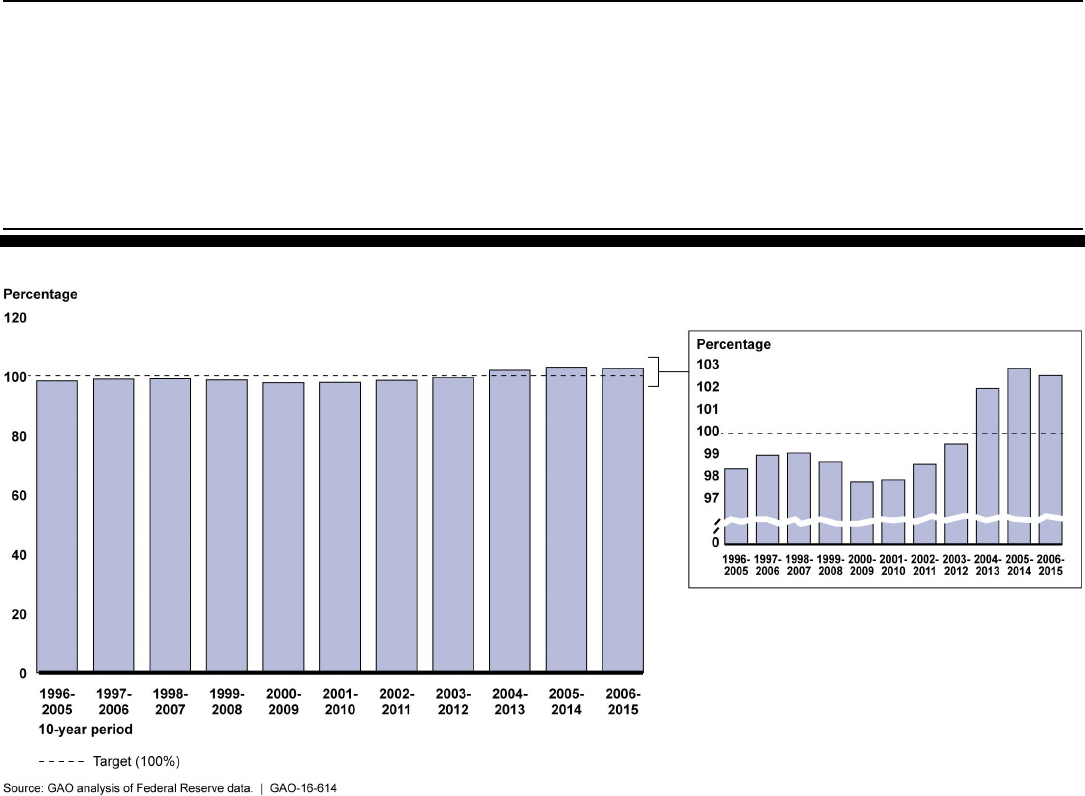
Figure 5: Rolling 10-year Average Cost Recovery Rates for Federal Reserve Payment Services, 1996-2015 (percentage)
Page 29 GAO-16-614 Payment System Competition
Although the Federal Reserve Banks generally have come close to
recovering all of their actual and imputed costs for their payment services
in aggregate, the extent to which individual payment services recovered
their costs varied more widely from year to year (see table 1). Cost
recovery variations between products in a given year may be due to
circumstances specific to those products. For example, in 2014, the
Federal Reserve Banks’ ACH service recovered 86.7 percent of its costs.
The lower rate was due to a nearly $32 million charge incurred that year
associated with a multiyear technology initiative that was to have
modernized a processing platform but had been suspended that year. In
contrast, in the same year, greater-than-expected check volume resulted
in cost recoveries of more than 115 percent for that product line, which
helped the Federal Reserve Banks achieve their overall cost recovery
goals for that year and in the 10-year periods that included 2013 and
2014.

Table 1: Annual Cost Recovery Percentages for the Federal Reserve, by Payment Service Type, 2007—2015 (percentage)
Page 30 GAO-16-614 Payment System Competition
2007
2008
2009
2010
2011
2012
2013
2014
2015
Check
100.7
97.8
92.8
107.1
105.4
108.8
115.4
115.6
113.0
ACH
107.6
101.5
93.4
103.4
100.8
101
101.2
86.7
100.7
Fedwire
a
107.3
100.4
92.1
100.6
103
98.8
98.6
103.2
103.9
Source: FederalReserve.│GAO-16-614
a
Fedwire cost recovery figures include revenues and expenses associated with the National
Settlement Service, a multilateral settlement system that provides financial institutions involved in
private-sector settlement arrangements a means to settle the obligations that arise under that
arrangement using accounts held at their Reserve Bank.
From 2005 to 2014, annual revenues and expenses across the Federal
Reserve Banks’ payment service products varied. Since 2005, the total
revenue the Federal Reserve Banks earned from providing check, ACH,
and wire transfer services declined by nearly 54 percent, from about $881
million in 2005 to $409 million in 2014 (a decline of nearly $1.1 billion to
$414 million, almost 61 percent in 2015 dollars). This decline was largely
due to a steep reduction in the expenses and imputed costs related to the
Federal Reserve Banks’ check services, which corresponded with the
transition to digital check images and the decline in commercial check
transactions. From 2005 to 2014, the number of checks the Federal
Reserve Banks processed fell from 12.2 billion to 5.7 billion. The decline
in expenses correspondingly reduced the need for the Federal Reserve
Banks to obtain as much revenue from this product line (that is, to
achieve cost recovery). Check service revenue fell from over $740 million
in 2005 to almost $175 million in 2014, which was a decline from $888
million to nearly $177 million in 2015 dollars (see fig. 6). In contrast, total
revenues for ACH and Fedwire increased from a combined total of about
$140 million in 2005 to over $234 million in 2014. In inflation-adjusted
2015 dollars, this equals an increase of almost $69 million.
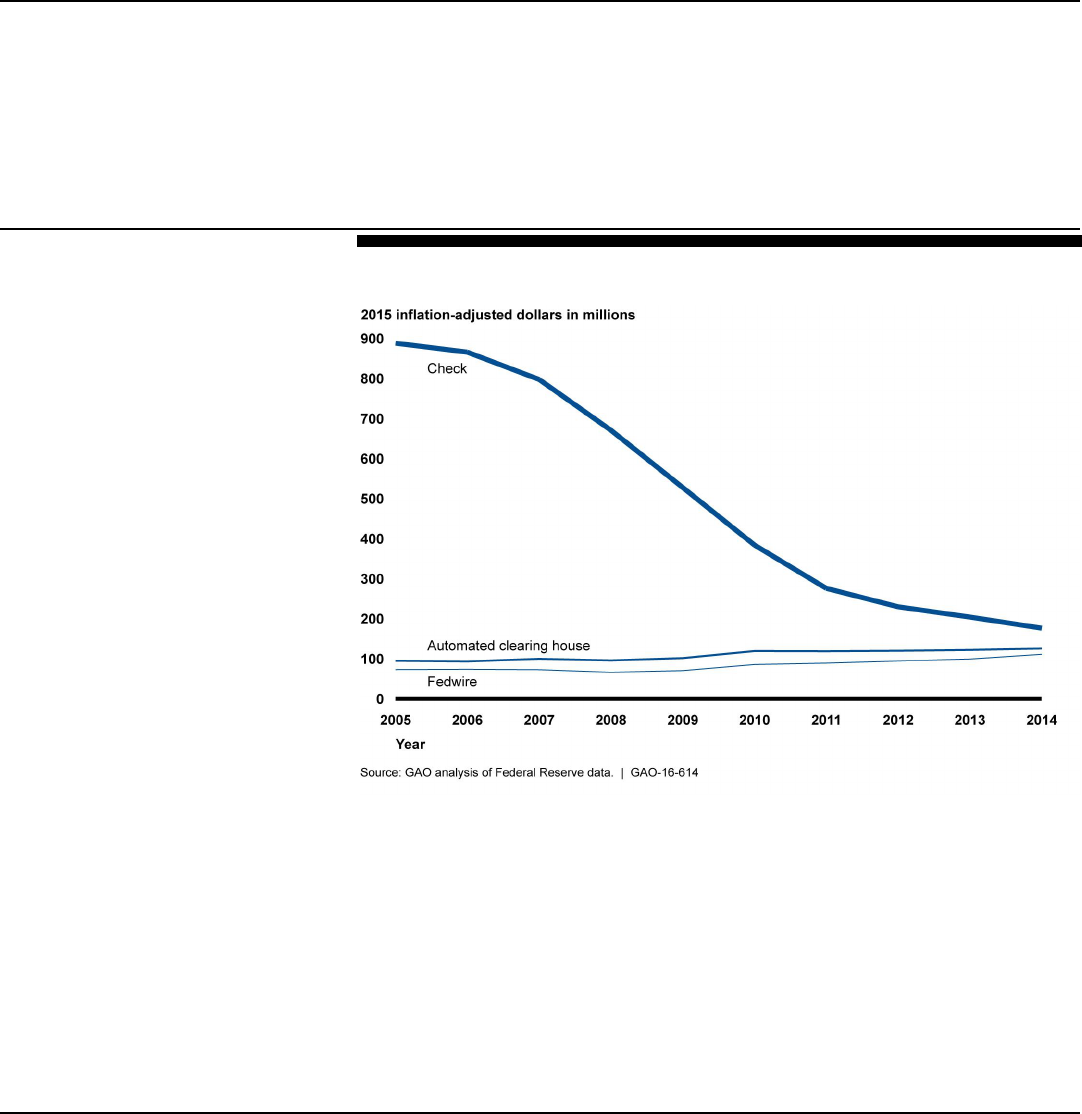
Figure 6: Federal Reserve Revenues by Payment Service, 2005–2014 (2015 Dollars
Page 31 GAO-16-614 Payment System Competition
in Millions)
Federal Reserve staff said that the cost structures for each of the check,
ACH, and wire payment services have significant differences. For
example, check clearing is more labor-intensive than the other services
and consequently incurs more personnel costs as a share of its
expenses. In 2015, personnel costs for check services represented more
than 15 percent of that service’s operational costs, while personnel costs
represented less than 3 percent of operational costs for Fedwire. Federal
Reserve staff identified personnel, information technology services, and
software application development as key cost drivers for the payment
services.
Although the Federal Reserve appears to have a sound system for
capturing its payment services costs, it has not obtained an independent
review involving detailed testing of the accuracy of its cost accounting
process in more than 30 years. As previously noted, in 1984, shortly after
it was mandated to capture and recover these costs, the Board had an
external review by an independent public accounting firm of its pricing
methodology, including evaluations of its cost accounting PACS process
and the PSAF. At that time, the accounting firm’s report concluded that
the processes the Federal Reserve had implemented to capture its costs
FederalReserve’s
ProcessforCapturingIts
PaymentServicesCosts
HasNotBeenExternally
ReviewedinDecades

were sound and that the overall PSAF methodology was logical and
complied with the Monetary Control Act.
The Federal Reserve obtains some assurance that cost accounting
practices for its payment services continue to be adequate from a unit
within the staff of the Board that conducts rotating reviews of the Reserve
Banks’ operations. Federal Reserve staff said that this unit reviews all the
Reserve Banks on a triennial basis (4 of the 12 banks each year) to
evaluate each bank’s effectiveness in producing reliable expense
information in compliance with PACS manual requirements. These
reviews examine the processes and controls relating to the cost-allocation
processes (including how expenses related to centrally provided
information technology activities are allocated) and internal support
charges. In these reviews, this internal unit identifies deficiencies and
control weaknesses and makes recommendations for improvement. In
addition, we reviewed the reviews the internal unit performed of the 12
Reserve Banks and of the Federal Reserve Information Technology
group between 2012 and 2015. Although some of these reviews noted
deficiencies with how the Reserve Banks were complying with the cost
accounting practices prescribed in the PACS manual, these issues were
characterized as “minor” or “less-significant” by the reviewers and,
according to Federal Reserve staff, did not result in any material cost
distortion. In addition, we reviewed a sample of nine audits that Reserve
Banks’ internal auditors had completed since 2011. Of these nine audits,
eight included reviews of controls relating to cost accounting practices. All
of the reviews concluded that overall management controls were
“effective” and one which provided a “generally effective” assessment.
External audits of the financial statements of the Federal Reserve System
overall and of the individual Reserve Banks are conducted annually.
However, these audits do not include detailed testing of the accuracy of
the processes used to capture or allocate costs associated with the
payment services, and thus the Federal Reserve does not obtain specific
assurance about the accuracy of these practices. Although staff from the
independent public accounting firm that conducted the Federal Reserve’s
financial audit in 2014 told us that the Federal Reserve Banks have
thorough processes, their audits did not include steps to review payment
services costs and revenues because these costs were not in the scope
of the audit.
The Committee of Sponsoring Organizations of the Treadway
Commission’s (COSO) Internal Control-Integrated Framework—a leading
framework for designing, implementing, and conducting internal control
Page 32 GAO-16-614 Payment System Competition

and assessing the effectiveness of internal control—states that
compliance with applicable laws and regulations is a key objective for an
organization establishing internal controls. Under this framework, a key
means of providing such assurance can be the performance of monitoring
activities, which includes the use of an independent third party to perform
specific evaluations of whether aspects of an organization’s internal
controls are present and functioning. The annual financial audit does not
address the Federal Reserve’s payment services, representatives from
the accounting firm told us, because they do not meet the materiality
threshold. However, the Federal Reserve Banks must accurately capture
their costs to ensure the Board is meeting the mandate in the Monetary
Control Act for the Board to set fees on the basis of all direct and indirect
costs.
The Federal Reserve believes that the internal controls of the Reserve
Banks, internal audits by the Reserve Bank audit departments, and the
review process and examinations by the Board of Governors staff are
adequate for reasonably ensuring the accuracy of its accounting of costs
associated with payment services. Although we analyzed the processes
by which the Federal Reserve accounts for actual and imputed costs, we
did not include detailed testing of the Federal Reserve’s calculations or
cost accounting controls related to its priced services activities. By
obtaining periodic independent reviews to determine if the practices used
to capture all costs directly incurred by payment service activities and the
methods used to identify costs arising in other areas that should be
allocated to payment services are sound and that staff are adequately
complying with these practices, the Federal Reserve could attain greater
assurance that it is complying with its requirements under the Monetary
Control Act to set fees on the basis of all direct and indirect costs.
Page 33 GAO-16-614 Payment System Competition

The Reserve Banks have added new services and fee structures
(including volume-based pricing) for customers to help ensure that they
retain adequate revenues to maintain their presence in the market.
Financial institution customers we interviewed generally were satisfied
with the Reserve Banks’ services and fees; however, some competitors
questioned the fairness of some Reserve Bank pricing practices such as
bundling discounts and volume-based pricing. To help ensure that the
Reserve Banks compete fairly, the Board has established pricing policies
and processes for assessing the competitive effects of changes to the
Reserve Banks’ payment fees and services. Although the Reserve Banks’
actions may be affecting some competitors’ profitability, our analysis of
the Reserve Banks’ fee and volume trends suggests that their actions to
compete appear to have reduced payments services costs for some
users to date.
In response to changes in the product market for payments, and in an
effort to generate sufficient revenues to achieve full cost recovery, the
Federal Reserve has added new products and pricing structures.
According to Federal Reserve documents, the Reserve Banks have
introduced new services and pricing structures to retain existing
customers and attract volume from both existing and new customers. As
noted earlier, the Reserve Banks provide payment services both to
promote the efficiency of the payments mechanism and to ensure that
payment services are provided to all depository institutions on an
equitable basis. To achieve this, the Reserve Banks expanded the use of
pricing structures that provide discounts to customers that send them
higher volumes of transactions to process. In 1993, the Board approved
volume-based fees for the Reserve Banks’ noncash collection service
and several check products. One of the objectives of adopting volume-
based fees at that time was to encourage more efficient use of payment
services (by addressing differences in demand through fees). In
approving these fees, the Board asked its staff to recommend guidelines
on the use of volume-based fees, which were then adopted in 1997 and
published in the Federal Register.
Page 34 GAO-16-614 Payment System Competition
32
At that time the Board also approved
specific volume-based fees for the ACH origination service. In 2010, the
Reserve Banks expanded this practice by introducing several volume-
32
62 Fed. Reg. 14,146 (Mar. 25, 1997).
WhileSome
Competitors
ExpressedConcerns
aboutSomeFederal
ReservePayment
ServicePractices,
UsersAppearedto
Benefit
AsProductMarkets
Changed,theFederal
ReserveAddedNew
ServicesandPriceTiers
forSomeCustomersto
EnsureItEarnsSufficient
Revenue

based pricing tiers for customers receiving ACH transactions.
Page 35 GAO-16-614 Payment System Competition
33
The new
pricing tiers charge customers lower per-item fees as transaction volumes
with the Federal Reserve increase.
The Reserve Banks also introduced fixed monthly fees to retain or
increase their payment services revenues. In 2009, the Board approved a
new monthly participation fee for the Reserve Banks’ Fedwire service in
addition to the per-item charges. Originally set at $60 per month, by 2014
this fee had increased to $90. For the ACH service, the Board approved a
new monthly minimum fee in 2010, which was $25 for customers that
originated payments and $15 for customers that received payments. By
2015, these fees had risen to $35 and $25, respectively. Because fixed
expenses constitute much of the costs of providing these services,
Federal Reserve staff said that adding fixed fees was their way of better
matching pricing structures to corresponding cost structures.
In addition to pricing changes, the Reserve Banks have introduced
discounts to benefit customers that use them to process transactions for
multiple payment products. For example, customers that transact at least
90 percent of their ACH payments a month through the Reserve Banks
and enable electronic receipt of checks from the Reserve Banks for all of
their routing numbers can receive a per-item fee discount on certain
check-clearing transactions. According to Federal Reserve staff, this
allows them to reward customers that use multiple services with a
discount in one of those services, which increases the likelihood that
these customers will continue to use the Federal Reserve.
Reserve Bank customers with whom we spoke generally were satisfied
with the services and pricing they received, but some competitors raised
concerns about the fairness of a number of pricing practices.
Representatives of Reserve Bank customers—12 banks and credit
unions that were selected, in part, using random selection across three
asset size groupings—with whom we spoke generally were satisfied with
the Reserve Banks’ service offerings and prices.
33
ACH services include origination and receipt services. Also, ACH transactions can be
either debits or credits. For example, an institution can use an ACH origination service to
send either a debit or credit to a receiving institution.
CustomersGenerally
WereSatisfiedwith
FederalReserveServices,
butSomeCompetitors
QuestionedtheFairness
ofSomePractices

· Representatives of seven institutions said that they thought the
Reserve Banks’ pricing of payment services was reasonable and
competitive. For example, representatives from one large credit union
said that the Federal Reserve’s prices are low and that they also
provided a good service.
· Representatives from two other institutions said that they valued the
Reserve Banks above private-sector providers for other reasons. For
example, the representative of one small community bank said that,
while private-sector payment service pricing generally may be lower
or even significantly cheaper, the bank will continue to use the
Reserve Banks’ services because doing so allows it to remain
independent and provide top-quality service to its customers without
depending on a private-sector provider. A representative of a large
credit union said that, while the credit union might be able to get more
favorable pricing from private-sector providers, the difference would
not be enough to warrant switching from the Reserve Banks. The
representative added that the credit union had confidence in the
Reserve Banks’ services and felt that the Reserve Banks were looking
out for its interests.
· For the remaining three institutions, representatives from two said
that, while they did not have much insight into the pricing of providers
they do not use, they generally believe that pricing was comparable or
competitive between the Federal Reserve and the private sector. A
representative of one of the three institutions told us that the institution
switched to the Federal Reserve in 2007 because of unhappiness with
the fees and service of its private-sector provider. Representatives
from one institution said that the Federal Reserve and private-sector
pricing was similar for checks and wire payments, but not for ACH
payments, where they said the Federal Reserve had better prices.
However, some private-sector competitors with whom we met expressed
concerns with the fairness of some of the Federal Reserve’s pricing
practices, specifically in the following areas: bundling discounts, volume-
based pricing, the competitive environment for check clearing, the ACH
interoperator fee, cost effectiveness, and the Federal Reserve’s ability to
innovate.
TCH—the Reserve Banks’ largest competitor in general and their sole
competitor in ACH and wire payment services—stated that a bundling
discount offered by Reserve Banks to customers that use multiple
payment services unfairly take advantage of the Federal Reserve’s
unique market position. Specifically, TCH staff said that the Federal
Page 36 GAO-16-614 Payment System Competition
Bundling Discounts

Reserve’s Retail Payments Premium Receiver product, which rewards
banks that transact a higher volume of ACH transactions with the
Reserve Banks by offering a discount for certain check forward payments,
represents an unfair bundling of services. According to TCH
representatives, this discount represents a cross-subsidy between
services, which they allege violates the intent of the Monetary Control Act.
Federal Reserve staff noted that this product offers attractive pricing
discounts to smaller financial institutions, unlike many of its other
discounts that focus on larger financial institutions, and is intended to
serve as a customer retention tool. Specifically, they said that the lower
price allowed them to retain customer volume, which is needed to achieve
economies of scale. According to its policy on the provision of financial
services, the Federal Reserve maintains an operational presence in the
payment system to contribute to economic efficiency. Additionally, the
Federal Reserve has said that the Retail Payments Premium Receiver
product is consistent with the letter and spirit of the Monetary Control Act
and the Board’s pricing principles, noting that revenues from either check
or ACH services do not contribute toward recovering costs for the other
service and therefore do not represent a cross-subsidy. Furthermore, staff
said that the Reserve Banks are not in a unique position in relation to
providing “relationship pricing,” as private-sector institutions also use such
pricing structures. Officials at the Department of Justice told us that
product bundling is not necessarily anticompetitive and is practiced in a
wide range of industries.
Some private-sector competitors expressed concerns that the Reserve
Banks charged customers more in markets in which the Reserve Banks
face less competition to enable lower pricing in markets in which they
face more competition. Competitor concerns included the following:
· One large bank provider with large corporate customers explained
that, because the Reserve Banks have access to some smaller or
more remote financial institutions, they charge other institutions a
higher rate to collect checks drawn on these smaller institutions,
taking advantage of their access and relatively exclusive relationships.
The price for sending a check to another institution is determined, in
part, by the pricing tier in which that institution is included.
· TCH staff said that the Reserve Banks offer steep discounts to large
financial institutions in markets where they compete for business and
offset these discounts by charging higher fees to smaller financial
institutions that have no alternatives to the Federal Reserve. They
considered this to be an anticompetitive pricing practice. They noted
Page 37 GAO-16-614 Payment System Competition
Volume-Based Pricing

that TCH faces difficulty obtaining smaller financial institutions as
customers because the costs in switching providers may outweigh the
pricing benefits for these institutions.
Federal Reserve staff said that volume-based pricing is a common
practice they believe helps maintain the efficiency of payment services.
Federal Reserve staff said that they follow volume-based pricing
principles when establishing pricing tiers and do not price their services
below marginal cost. They added that they assign items drawn on a
financial institution to a tier based on the number of checks the Reserve
Banks present to that financial institution, with those institutions with more
volume assigned to a lower-priced tier. They also noted that the private
sector similarly establishes tiers based on volume. Because private-
sector competitors have similar price structures, and because any higher
prices paid by lower-volume customers likely do not increase their overall
costs significantly (as discussed later), this practice also appears to
benefit the payment services market overall.
Some private-sector competitors raised concerns that certain protections
that helped ensure fair competition for processing paper checks have not
been carried over into the electronic environment. The Federal Reserve
has been examining this issue. Staff from TCH and ECCHO noted that,
until a regulatory change in 1994, the Reserve Banks had a statutory
advantage over private-sector competitors when presenting paper checks
to paying banks. According to the Federal Reserve Act and Federal
Reserve regulations, the Federal Reserve can obtain a same-day
payment from a paying bank by debiting the paying bank’s account at a
Reserve Bank without being charged a presentment fee. To address this
advantage the Board adopted Regulation CC’s same-day settlement rule
in 1992, effective beginning in 1994.
Page 38 GAO-16-614 Payment System Competition
34
The same-day settlement rule
allowed any bank to present paper checks to any other bank by 8:00 a.m.
for settlement that same day without presentment fees. According to
Federal Reserve staff, this regulatory change reduced the Federal
Reserve’s competitive advantage and allowed banks to compete more
effectively.
35
34
57 Fed. Reg. 46,956 (Oct. 14, 1992) (codified at 12 C.F.R. § 229.36(f)).
35
The Board originally requested comments on a proposal to provide for a later 2:00 p.m.
deadline, but stated that the overwhelming proportion of commenters opposed this
deadline.
Competitive Environment for
Check Clearing

However, according to ECCHO staff, the transition to the exchange of
check images has removed the effect of the competition-enhancing
change because Regulation CC does not apply to electronic images.
They explained that check image exchange, unlike the presentment of
paper checks, requires institutions to have legal agreements for and
electronic connections between both parties, both of which can be costly
to establish. The Board attempted to address this advantage by twice
requesting comment, in 2011 and in 2014, on whether to modify
Regulation CC to include similar presentment provisions for the exchange
of check images. Although the Board has not yet taken final action on
these proposals, they did not receive significant support from
commenters, with payments trade groups noting both policy and
operational issues.
Page 39 GAO-16-614 Payment System Competition
36
Additionally, commenters did not provide any
alternative approaches that could be used to address the perceived
competitive disadvantage. In a December 2015 letter (in response to a
May 2015 letter from ECCHO raising these issues), the Chair of the
Federal Reserve’s Committee on Federal Reserve Bank Affairs said that
Federal Reserve staff have been asked to review certain pricing practices
related to electronic checks to determine whether any changes to Federal
Reserve policies, procedures, products, or fee structures were warranted.
This letter states that the Federal Reserve will continue to engage in
dialogue with ECCHO and industry stakeholders on steps to improve the
competition and efficiency of the check system, and Federal Reserve staff
told us in that they continue to consider ways to address these concerns.
TCH, as the only private-sector operator of ACH payments, told us that it
is concerned that the Reserve Banks have been taking advantage of their
market position to charge an artificially high fee for processing
transactions that TCH sends to them. Representatives of TCH explained
that, for ACH payments, both institutions involved have to process a
transaction, regardless of which one originates or receives the payment.
ACH payments generated by customers of TCH or the Federal Reserve
but bound for customers of the other provider must pass between both
operators, thus creating an interoperator transaction. In such cases, the
party that receives the item charges the other party “interoperator fees.”
However, TCH sends more items to the Reserve Banks because its large
bank customers typically generate large volumes of payments on behalf
36
For the two proposed rules, see 79 Fed. Reg. 6674 (Feb. 4, 2014); 76 Fed. Reg. 16,862
(Mar. 25, 2011).
ACH Interoperator Fee

of their business customers—many of which are sent to institutions that
use the Reserve Banks for ACH receipt. As a result, according to TCH
representatives, the interoperator fee benefits the Reserve Banks at the
expense of TCH. TCH representatives believe no costs exist that would
justify charging any price for these transactions.
However, Federal Reserve staff said that the Reserve Banks incur the
same costs when processing ACH files from a depository institution or
private-sector operator. If the Federal Reserve and TCH lowered or
eliminated the interoperator fee, the Federal Reserve likely would have to
increase prices for ACH payments made entirely within its network to
recover the lost revenue. This could effectively raise prices for its
customers while lowering them for TCH’s customers. Federal Reserve
staff said they established the interoperator fee below the average 2013
per-transaction cost to originate a FedACH item, not including electronic
connection costs. This average origination cost is based on operating
costs and imputed costs and has been fairly stable since the
determination of the fee.
While differences exist in cost structures between the Federal Reserve
and the private sector, these differences largely reflect differences in
customer bases. For example, TCH staff raised concerns over the cost-
effectiveness of the services provided by the Federal Reserve, noting that
they operate much more cost effectively on a per-item basis than the
Reserve Banks. Specifically, TCH said that its average cost per
transaction for check, ACH, and wire items was approximately 16 percent
to 29 percent of the average cost per transaction for the three products
offered by the Reserve Banks.
Page 40 GAO-16-614 Payment System Competition
37
However, TCH told us that they primarily
serve large financial institutions. The other competitors of the Reserve
Banks, including large commercial banks, a bankers’ bank, corporate
credit unions, and a nonbank service provider, also tended to serve
narrower ranges of customers. For example, representatives of some
large banks with whom we spoke said that they tended to provide
payment services mostly to larger entities. Staff from a large bank told us
that they mainly provide check processing services targeted to smaller
institutions in areas where their bank has support staff.
37
Although we reviewed Federal Reserve pricing schedules, we did not review TCH’s
pricing information.
Cost Effectiveness

In contrast, our analysis of Federal Reserve data indicated that the
Reserve Banks provide payment services to thousands of institutions
across a range of asset sizes, including large numbers of smaller
institutions. For example, about 86 percent of the Reserve Banks’ 3,665
forward check customers and about 94 percent of their ACH receipt
customers had less than $1 billion in assets. Federal Reserve staff told us
that providing payment services to many of these customers is more
costly because low-volume users are the largest users of customer
support services, resulting in higher per-item costs for these customers.
The account setup and maintenance costs also result in higher per-item
costs for low-volume customers. The Federal Reserve staff also noted
that they incur other expenses not borne by their private-sector
competitors, such as those related to processing transactions manually in
the event of a disruption. If TCH had a similar customer base and costs
as the Reserve Banks, its costs would likely be higher on a per item basis
and would be more similar to that of the Reserve Banks. Similarly, if the
Reserve Banks left the market for payment services, and TCH and the
other providers took on these customers, their costs per transaction
would likely increase due to the higher costs of serving the customers
currently served by the Reserve Banks, thus reducing or eliminating any
cost-effectiveness advantage. Correspondingly, if the Reserve Banks
provided services only to the larger customers that process larger
volumes, their costs per item would similarly be lower and their cost
effectiveness would appear higher.
The Federal Reserve noted that some of the differences in cost structures
provide competitive advantages to competitors of the Reserve Banks.
However, these cost differences may not be significant enough incentive
for current Federal Reserve customers to turn to other providers. For
example, staff from TCH said they have difficulty encouraging smaller
institutions to use TCH for payment services because many of these
institutions have payment volumes that are too low to produce savings
significant enough to justify a switch from the Federal Reserve.
TCH representatives expressed concerns that the Federal Reserve’s
pricing and other behaviors have limited competitors’ ability to promote
innovation in the payments system. Representatives from TCH said that
the Federal Reserve’s pricing strategies have left little room for
profitability in providing payment services, leading to an overall reduction
in investment in research and development necessary for continued
innovation in the payments industry. They also added that any
innovations developed by TCH need to be accepted by the Federal
Reserve, which can present a challenge. For example, TCH
Page 41 GAO-16-614 Payment System Competition
Ability to Remain Profitable
and Innovate

representatives said that they developed a universal payments identifier
to increase privacy protections and reduce fraud in electronic payments,
but the Federal Reserve did not adopt this innovation. Representatives
from the Federal Reserve noted that they partnered with TCH to deploy
this capability so that TCH customers wishing to use these identifiers for
ACH payments could do so without concern that such payments would be
rejected if they were routed across ACH networks. However, the Reserve
Banks said that there was little market demand for this capability by their
customers and determined not to offer the service directly.
In contrast, Federal Reserve staff said that the Federal Reserve’s
involvement in the payments market has contributed to the development
of new products and more efficient processes over time. Federal Reserve
staff and some market participants cited the Federal Reserve’s role in
multiple market innovations. For example, Federal Reserve staff indicated
that the remote capture of check deposits using smartphones and online
service access were an outcome of the check image improvements that
grew out of the Check 21 Act, which the Board helped to develop and the
Reserve Banks helped to implement. In addition, a representative from a
payment service provider said that the Federal Reserve was essential in
transitioning the check-clearing industry to image exchange after Check
21 became effective in 2004. The representative added that the Federal
Reserve has been helping to facilitate international ACH payments by
creating connections to other countries. Other market participants said
that the Federal Reserve has been leading the way on faster payment
initiatives such as same-day ACH (payments can clear and settle on the
same day they are submitted). The Reserve Banks began offering an opt-
in same-day ACH settlement service for certain debit transactions in
2010, and expanded this service to include support for credit transactions
in 2013. Federal Reserve staff said that their push toward instituting a
same-day ACH service, along with NACHA’s rule amendment in 2015
allowing for same-day ACH payments, will help their customers develop
new products, such as direct deposit for hourly payroll, which benefits
users as well. With customers increasingly demanding faster, ubiquitous,
safe, and inexpensive payment solutions, at least 18 other countries have
Page 42 GAO-16-614 Payment System Competition

developed real-time retail payments systems, according to a 2015 white
paper from an international payments network.
Page 43 GAO-16-614 Payment System Competition
38
Representatives from TCH said that increased regulatory costs along with
what they see as the unfair way that the Federal Reserve is competing in
payment services is creating difficulties for the long-term viability of
private-sector operators. TCH staff said that appropriate competition in
the market for payment services, including higher prices, would facilitate
continued research and development by the private sector, leading to
ongoing private-sector innovation in the payments system.
While the Monetary Control Act requires the Federal Reserve to give due
regard to competitive factors and the provision of an adequate level of
such services nationwide when pricing its payment services, the act does
not address the preferred type or extent of private-sector competition in
the payments industry. Federal Reserve staff said that there are clear
benefits to vigorous competition with the private sector, such as the
additional resilience provided to large bank customers due to the
presence of two wire payment operators. In addition, they said that the
competition between the two is helpful in ensuring both entities are as
responsive as possible to customer needs. However, they also noted that
the overall costs to the market of having two ACH operators are higher
because of the loss of some economies of scale. Federal Reserve staff
added that, while it is not their intent to drive TCH out of business, they
also are not convinced it is necessary to have two operators, as many
other countries only have one provider for such services. Because the
effect of changing any Federal Reserve pricing likely would allow TCH to
raise its own prices, the benefits of such actions for the overall
marketplace and end-users is not clear. Conversely, if the Federal
Reserve withdrew from the market, the costs to the overall payments
system could decrease, but since TCH would likely have to expand its
infrastructure and market reach, its costs would increase, and the effect
on overall prices also would be unclear.
38
SWIFT, The Global Adoption of Real-Time Retail Payments Systems (RT-RPS) (La
Hulpe, Belgium: 2015), accessed on June 6, 2016, this white paper can be downloaded
at: https://www.swift.com/your-needs/real-time-payments

To help ensure that they compete fairly with private-sector payment
services providers and set fair pricing, the Reserve Banks must adhere to
various pricing principles and Board policies. As discussed previously, the
policies include the pricing principles established in the Monetary Control
Act, which required Federal Reserve payment services to be priced at the
same fee schedule for Federal Reserve members and nonmembers and
that such fees be established on the basis of all direct and indirect costs,
giving due regard to competitive factors and the provision of an adequate
level of such services nationwide. The Board has adopted several
additional pricing principles to help ensure that the Reserve Banks
compete fairly.
· Generally, the Reserve Banks must set prices for each payment
service so that revenues match costs over the long run. However, the
Board’s pricing principles acknowledge that the Reserve Banks may
set below-cost prices for a service if it is in the interest of providing
adequate service nationwide. But such a decision would require a
Board announcement.
· The Reserve Banks also must ensure that their services and pricing
are responsive to the changing needs of particular markets and
provide advance notice for changes in fees and significant changes in
service arrangements to permit orderly adjustments by users and
providers of similar services.
To help ensure that Reserve Bank pricing determinations give adequate
regard to competitive factors, Federal Reserve staff told us that they
follow industry standards and best practices for pricing their services.
They said that the factors they consider are similar to those that other
service providers such as correspondent banks would consider. These
factors include
· the costs associated with the service;
· the cost structure, such as the extent to which costs are fixed or
variable;
· payment volumes;
· industry trends;
· the price sensitivity of customers; and
· the extent to which the market for the product or service is
competitive.
Page 44 GAO-16-614 Payment System Competition
FederalReserveHas
ProcessesandPoliciesto
HelpEnsurePricing
Fairness

They explained that price sensitivity—the extent to which a customer is
likely to react to a pricing change—for a product is particularly important
when determining whether to use volume pricing. For example, they said
that higher-volume customers are fairly price sensitive; that is, they are
more likely to send more or less business to the Reserve Banks
depending on the prices charged. With the cost to provide services to
higher-volume customers being lower than for other customers, staff said
that using volume pricing to set lower prices for higher-volume customers
was reasonable. Federal Reserve staff also said that they sometimes use
pricing to influence consumer demand. For example, for a legacy product
such as the access fee for using a dial-up connection to the Reserve
Banks, they might increase the price to discourage its use. The Federal
Reserve considers the various competitive factors for each pricing or
service change proposal (typically during its annual pricing process).
Each pricing or service change proposal during the process must
consider customer, competitive, and policy implications before the
Reserve Banks bring a formal proposal to the Board. At the beginning of
this process, Federal Reserve staff consider market feedback from the
prior year’s pricing changes and analyze market trends and projections as
they develop new pricing proposals.
The Board also has policies to prevent the Reserve Banks from engaging
in anticompetitive or predatory pricing. According to the Department of
Justice, predatory pricing occurs when a firm charges prices that are
temporarily set below its incremental costs in an attempt to harm
competitors. Department of Justice staff involved in antitrust and
anticompetitive legal cases told us that a firm can be deemed to be
competing unfairly if it is engaged in predatory pricing, bundling its
products anticompetitively, or engaged in anticompetitive tying—requiring
the purchase of additional products as part of another purchase. Federal
Reserve staff told us that they used volume-based pricing in accordance
with principles the Board published in the Federal Register in 1997, which
are intended to avoid the risk of predatory pricing. These principles note
that volume-based fees “promote the efficient use of payment services by
allowing Reserve Banks to set variable fees closer to the incremental
costs of providing services.”
Page 45 GAO-16-614 Payment System Competition
39
Federal Reserve staff said that they take
into account competitive factors when establishing volume-based pricing
because the need to attract sufficient revenue from large-volume
39
62 Fed. Reg. 14,146, 14,147 (Mar. 25, 1997).

customers better ensures that prices charged to low-volume customers
do not get too expensive. However, these principles also state that the
Reserve Banks will not price a particular service below its marginal cost,
or the cost of clearing one more item. According to these principles, this
type of pricing constraint is well established in antitrust law and is
intended to prevent predatory pricing.
In addition to these principles, the Federal Reserve conducts a
competitive impact analysis for all proposed changes to products and
prices and for all new products and prices. The analyses help ensure that
the Reserve Banks are not unfairly leveraging any legal advantages they
have over private-sector competitors—such as differing legal authority or
their dominant market position deriving from such legal differences.
According to a policy statement outlining its practices, the Federal
Reserve will conduct a competitive impact analysis on all proposed
operational or legal changes determined to have a substantial effect on
market participants, even if the competitive effects are not apparent on
the face of the proposal.
Page 46 GAO-16-614 Payment System Competition
40
In practice, Federal Reserve staff noted that
they also conduct competitive impact analyses for routine proposals
(those that only moderately affect existing product offerings). See
appendix IV for more information about how the Board conducts and
reviews competitive impact analyses.
Based on Federal Reserve data and estimates and our analysis and
interviews, the presence of the Reserve Banks in the payments services
market appears to have reduced payments services costs for some
customers to date. For instance, from 2001 through 2013 private-sector
providers increased their market share for check, ACH, and wire
services—an indication that the Reserve Banks have not necessarily
negatively affected competition in these markets (see fig. 7). In 2001, the
Reserve Banks had about 57 percent of the share of the market for check
payments, about 64 percent of the market for wire payments, and more
than 85 percent of the market for ACH transactions. By 2013 (the most
recent data available at the time of this review), the Reserve Banks’
market share had declined in each of these payment services, with the
largest declines occurring in the ACH market. Their share of payments
40
Federal Reserve System, Policies: The Federal Reserve in the Payments System,
issued in1984, revised in 1990, accessed on June 2, 2015,
http://www.federalreserve.gov/paymentsystems/pfs_frpaysys.htm
TheFederalReserve’s
PresenceAppearstoHave
GenerallyBenefitted
PaymentServiceUsers

originated declined from 86 percent to 49 percent and their share of
payments received from 87 percent to 63 percent.
Figure 7: Market Shares (Based on Dollar Volume) of Federal Reserve and Private-Sector Providers in Check, Automated
Page 47 GAO-16-614 Payment System Competition
Clearing House (ACH), and Wire Transfer Payments, 2001–2013
Although the Federal Reserve’s most recent triennial payments study
included market share data through 2013, some more recent data also
exist.
· ECCHO staff, using a different methodology, in 2014 and 2015
estimated that the Federal Reserve had between 42 percent and 44
percent of the check-clearing market.
· For ACH, the Federal Reserve had around 55 percent of the market
share for ACH originations and about 62 percent of the market for
ACH receipts in 2014 and 2015, according to our analysis of Federal
Reserve and NACHA data provided by the Federal Reserve.
· For wire payments, the Federal Reserve had about 55 percent of
market share in 2014 and 51 percent in 2015, according to our
analysis of Federal Reserve and TCH data provided by the Federal
Reserve.

These data suggest that the Reserve Banks’ market share for both check
and wire payments has continued to decline since 2013, although their
share of the ACH market has stabilized in the last few years.
The effect of the Reserve Banks’ competition in the markets for payment
services can vary across customers, but generally has resulted in lower
prices for payment transactions, according to Federal Reserve and TCH
staff. Federal Reserve staff told us that by competing actively to gain
more volume and new customers through their pricing and product
offerings, they have exerted downward pressure on prices for payment
services. TCH staff told us that the prices they charge their customers are
largely based on the cost of providing those services, taking into account
the prices set by their competitors in the marketplace.
The competition with the Reserve Banks often lowered prices for
competitors’ customers as well. Private-sector payment service providers
told us that the Reserve Banks’ published prices act as a baseline for the
industry. For example, TCH primarily serves large banks in a network
that, with few exceptions, offers the same pricing to all its members.
Representatives of TCH told us that they price their services based
largely on the cost of providing those services, taking into consideration
the price set by the marketplace, which includes the pricing offered by the
Reserve Banks and other private-sector entities. One nonbank service
provider that performed check processing said that most large banks try
to keep their prices about 10 percent lower than the Reserve Banks’. The
bankers’ bank and corporate credit unions we interviewed generally serve
smaller institutions in distinct geographical areas, such as a particular
state. Staff from the bankers’ bank said that the Reserve Banks’ fee
schedules serve as the pricing starting point for the industry.
Some of these competitors told us that they often offer additional services
to attract customers, similar to the Reserve Banks, and one also offers
discounts for customers that use multiple products and services. Another
servicer said that although they used to set prices directly off of the
Reserve Banks, they now use a model that can generate a range of
prices that allows them to maintain profitability. Although staff from one
bankers’ bank said that they were unable to offer prices as low as the
Reserve Banks’, they competed by offering more personalized customer
service than other competitors.
Our analysis of the Reserve Banks’ revenue and volume data shows that
many customers generally appear to have benefitted from lower prices in
recent years. We examined volume and revenue data for each of the
Page 48 GAO-16-614 Payment System Competition

Reserve Banks’ check, ACH, and wire services and determined that, in
general, while price ranges have expanded as previously noted, average
costs for financial institution customers generally decreased in recent
years.
Page 49 GAO-16-614 Payment System Competition
41
· For all check items, the Reserve Banks earned average revenue per
item of $0.0249 in 2014, down 82 percent from $0.160 in 2007.
Federal Reserve staff noted that the primary driver of this cost decline
has been the transition from exchanging paper checks to check
images.
· One of the most used check processing product types the Reserve
Banks offer involves processing files containing check images.
42
From
2004 to 2011 the most used product of this type was for files
submitted by 8:00 p.m. (in 2012, the deadline was changed to 9:00
p.m.). The average cost per file processed went from $0.054 in 2007
to $0.020 in 2015—a decline of almost 63 percent.
Similarly, many customers paid less for their ACH origination and receipt
transactions over time as the Reserve Banks’ average per-item ACH
revenues declined, although some customers benefited more than others.
Specifically, the average revenues per item for ACH items decreased
from $0.0046 in 2005 to $0.0044 in 2014, or about 5 percent. For both
ACH origination and receipt services, the Reserve Banks saw the
proportion of revenue, and the total revenue earned from their largest
customers, decline while revenues increased from all other customers,
despite the number of institutions in these categories remaining stable.
For example, the share of ACH revenue earned from institutions with
more than $1 billion in assets declined from 60 percent in 2005 to 56
percent in 2014, although total revenues from these customers grew from
$35.6 million to $46.4 million, or from $42.7 million to $46.9 million in
2015 dollars. Because these larger institutions likely serve many other
end-user business and retail customers, these lower costs likely benefited
such end-users. The tendency of other providers to match or attempt to
set lower prices than the Reserve Banks also would extend the benefits
41
The Federal Reserve revenue data we analyzed represent the payment services costs
paid by financial institution customers of the Federal Reserve.
42
This product is the Federal Reserve’s Mixed Image Cash Letter.

of lower Reserve Banks prices to the end-users that use other payment
service providers.
For its Fedwire service the Reserve Banks increased their revenues from
larger and midsize customers as their revenues declined from their
largest customers.
· Overall, Reserve Bank customers paid 76 percent more for wire
transfers from 2005 to 2014—which reflects the costs of system
upgrades that occurred during this time.
· From 2005 to 2014, the share of Fedwire revenues earned from the
largest institutions (more than $1 billion in assets) declined from 78.1
percent in 2005 to 64.9 percent in 2014, although total revenues from
these customers grew from almost $36 million to almost $50 million
(or from about $43.2 million to $50.5 million in 2015 dollars) in that
span.
· Revenues from the next largest institutions ($200 million to $1 billion
in assets) increased from 8.5 percent to 13 percent.
· In contrast, the revenues from the smallest institutions (less than $50
million in assets) remained under 1 percent.
Although smaller customers faced price increases, their actual costs are
smaller than those incurred by larger institutions. For example, small
credit union customers paid the Reserve Banks an average of $1,672
annually to receive ACH payments and small banks paid $1,772 in 2014.
In contrast, banks with more than $1 billion in assets paid an average of
almost $78,000 annually to send and receive FedACH payments that
year. We compared these average ACH expenses to the noninterest
expense amounts for all banks and credit unions with more than $1 billion
in assets and found that these ACH expenses would represent from
about 0.12 percent to 0.18 percent of the median institution’s total
noninterest expenses, but for the small institutions (those with less than
$50 million in assets), these ACH expenses would represent from about
Page 50 GAO-16-614 Payment System Competition

0.05 percent to 0.48 percent of the median institution’s total noninterest
expenses.
Page 51 GAO-16-614 Payment System Competition
43
Smaller institutions received far fewer Fedwire payments than larger
institutions, on average. The average small credit union received between
100 and 224 Fedwire payments annually from 2005 through 2014, and
small banks similarly received between 115 and 188. In contrast, the
average Reserve Bank customer with more than $1 billion in assets
received between 188,000 and 210,000 Fedwire payments annually in
the same period. As a result, the average amount spent on Fedwire
originations and receipts by smaller institutions was far lower than for
larger institutions. From 2005 to 2014 (the last year full data were
available), the average small credit union spent between $244 and
$1,838 annually to send and receive Fedwire transactions, or $914 on
average. Similarly, small banks spent between $396 and $1,442 on
Fedwire transactions, or $1,058 on average. In contrast, the largest
Federal Reserve customer banks spent between $48,000 and $77,000
annually, or almost $62,000 on average.
The Federal Reserve performs various roles, including managing
monetary policy, supervising bank holding companies and certain banks,
and acting as a lender of last resort, which create potential conflicts of
interest with the Reserve Banks’ role as provider of payment services. To
prevent Reserve Bank staff from inappropriately using any knowledge
gained from other activities (such as bank examinations) to increase the
competitiveness of their payment services, the Board has established
various policies and processes. In 1984, the Board issued various
standards to minimize the potential that the various roles of the Federal
Reserve could provide advantages for its payment services activities.
These include organizing the Reserve Banks’ operations so that the
duties of staff responsible for the Reserve Banks’ nonpayment services
activities do not overlap with those of the staff who conduct payment
services. Under this structure, Reserve Bank personnel with responsibility
for payment services (unless acting in the capacity of president or first
vice president) are prohibited from being responsible for monetary policy,
bank supervision, or lending.
43
Noninterest expenses are for resources other than borrowed funds and generally
include the costs of resources (such as compliance staff or consulting services) banks and
credit unions are likely to employ to comply with regulations.
MarketParticipants
GenerallyViewedthe
FederalReserveas
ManagingPotential
PaymentServices
Conflicts

Similarly, payment services personnel are prohibited from making policy
decisions affecting monetary policy, bank supervision, or lending matters.
Reserve Bank personnel involved in monetary policy, bank supervision,
or lending are permitted to provide to Reserve Bank payment services
personnel certain confidential information obtained in the course of their
duties. However, sharing the information would have to fulfill an important
supervisory objective, preserve the integrity of the payment mechanism,
or protect the assets of the Reserve Banks. In such cases, information is
to be provided on a need-to-know basis and only with the approval of
senior management.
To prevent payment services staff from obtaining information that could
be used for competitive advantage from the Federal Reserve’s
supervisory activities, Federal Reserve staff told us they have restrictions
on access to the databases that store examination information and other
confidential supervisory information. Board staff noted that the Reserve
Banks have groups that monitor credit risks to the Reserve Bank to
protect the assets of the Reserve Bank as well as to protect the payment
system generally. The staff in these groups have access to confidential
supervisory information to perform this activity, and sometimes must
share information with the payment services staff when implementing risk
controls on particular institutions’ accounts. The guidance that Federal
Reserve staff provided to us addressing credit risk monitoring activities
includes a section reminding Reserve Bank staff to share information on a
need-to-know basis only. A Board review conducted in 2005 that
surveyed the Reserve Banks on their information-sharing practices found
that staff were sharing information only when appropriate.
To limit potential for conflicts, Federal Reserve staff also have limited the
extent to which the information technology systems that financial
institutions use to access payment systems activities integrate with
functions related to other Federal Reserve activities. For instance, the
Reserve Banks offer a system known as Fedline, which provides the
ability to conduct transactions across various payment system services. A
July 2015 memorandum to staff responsible for statistics and deposit
reserves activities noted that staff responsible for payment services sales
had suggested that the applications for other business lines be more fully
integrated into Fedline to allow more seamless movement among these
activities. However, the memorandum reminds these staff that the
applications for the other business line functions were purposefully
segregated from the payment system applications in Fedline to better
ensure that staff adhered to conflict-of-interest standards for payment
services.
Page 52 GAO-16-614 Payment System Competition

The Federal Reserve also includes information in training to help ensure
that relevant staff are aware of restrictions intended to prevent payment
services activities from benefiting from information obtained from other
Federal Reserve activities. Federal Reserve Board staff explained that
conflict-of-interest issues are not covered in a separate training course
but instead are addressed as part of other training. The 1984 standards
note that Reserve Bank staff are expected to provide full and accurate
information on Federal Reserve services (including features, quality,
prices, and operating requirements) to enable depository institutions to
make informed decisions, and that comparisons of Federal Reserve
services with those of other providers should be fair and objective. During
initial training, employees who work in the sales and marketing areas are
made aware of these policies to help ensure that their sales interactions
with banks avoid any inappropriate discussions. The staff noted that the
credit risk management staff developed some training modules and an
online training course that was shared among the 12 Reserve Banks that
includes information on the Board’s guidance on information sharing.
In addition to the Board’s policies, the individual Reserve Banks whose
staff conduct payment service activities also have policies that restricted
information sharing and other activities that could create potential
conflicts. We reviewed the policies of five of the Reserve Banks that
conduct payment services activities to determine if they addressed
behavior that could create conflicts of interest among supervisory,
payment services, and other activities. Each of the five Reserve Banks
have policies that restrict the sharing of information between payment
services staff and supervisory or other Reserve Bank staff. In addition,
four of the banks specifically restrict supervisory staff from discussing
payment services issues with financial institutions. Three of the banks’
policies also note that payment services staff should not disclose to other
Reserve Bank staff whether a financial institution was a payment services
customer. In addition, three of the banks’ policies note that decisions on
whether to take supervisory actions against a financial institution should
not be based on whether or not the institution was a payment services
customer. The Reserve Bank policies generally note that sharing of
information between payment services and staff with other responsibilities
Page 53 GAO-16-614 Payment System Competition

could occur if such sharing served a specific supervisory purpose or if the
information was otherwise publicly available.
Page 54 GAO-16-614 Payment System Competition
44
To determine compliance with the policies to prevent staff from sharing
information or exerting influence to advantage its payment services
activities, the Board also conducts periodic reviews to evaluate the
Reserve Banks’ application of the policies. The Division of Reserve Bank
Operations and Payment Systems within the Board is responsible for
conducting operations reviews of the Reserve Banks. As previously
discussed, Board staff told us that they review operations at four Reserve
Banks each year. As part of these reviews, Board staff discuss the
Reserve Banks’ information sharing practices for staff and provide
feedback to the banks about any concerns with the management of
confidential supervisory information.
The Federal Reserve also indicated that oversight by other auditors also
helps provide assurance that it is taking adequate steps to minimize
conflicts between its payment system activities and its other roles. The
Board’s Inspector General conducts reviews that sometimes address the
Board’s oversight of Reserve Bank payment systems activities. For
example, in September 2014 the Inspector General reported on the
extent and effectiveness of oversight (by the Division of Reserve Bank
Operations and Payment Systems) of the Reserve Banks’ Fedwire and
other wholesale financial services activities.
45
The Inspector General’s
review stated that it had not identified any deficiencies regarding the
efficiency and effectiveness of the Board staff’s oversight, and that the
staff employed off-site monitoring, ongoing communication, on-site
reviews, and assistance from the general auditors at the Reserve Banks
to provide oversight of the Reserve Banks’ wholesale financial services.
The Board’s 1984 policy that sets out standards for the Reserve Banks’
payment services activities notes that an additional level of external
review comes from providing the public with the ability to comment on
significant Board proposals on Reserve Bank payment services activities.
44
In some cases the banks’ policies also specifically noted other reasons for allowing
sharing, including preserving the integrity of the payment mechanism or protecting the
assets of the Reserve Banks.
45
Office of the Inspector General, Board of Governors of the Federal Reserve System,
Opportunities Exist to Enhance the Onsite Reviews of the Reserve Banks’ Wholesale
Financial Services, 2014-FMIC-B-014 (Washington, D.C.: Sept. 30, 2014).

The Federal Reserve also has a process for addressing complaints about
its payment system activities. Federal Reserve staff told us that they have
sometimes received questions from market participants on these
operations. If the issue is not resolved to the participant’s satisfaction,
they can escalate the matter to the chair of the Board’s Committee on
Federal Reserve Bank Affairs. This person is responsible for investigating
and responding to complaints concerning actions of Reserve Bank
personnel who are alleged to be inconsistent with the standards related to
conflicts arising from its payment systems’ activities.
Discussions with Federal Reserve staff and market participants suggest
that the Reserve Banks comply with the policies intended to prevent them
from using their other roles to benefit their payment services activities.
When we last reported on the potential conflicts between the Reserve
Bank’s payment services activities and the other roles of the Federal
Reserve in 2000, we found no evidence to suggest that the Reserve
Banks had not adequately separated their multiple roles.
Page 55 GAO-16-614 Payment System Competition
46
Since then,
Board staff told us that they have rarely received complaints relating to
conflicting roles in the payments system. For example, in the last 5 years,
staff recalled one instance in which they received a complaint from a
competing payment clearing organization. The complaint related to an
alleged incident in which a Reserve Bank payment systems sales
employee purportedly told a financial institution that use of Reserve Bank
payment services would help them comply with any regulatory
requirements. Board staff pursued the complaint, but were unable to
address the specific allegation due to lack of details regarding the
incident. However, Board staff held discussions with Reserve Bank staff
responsible for payment services sales to reinforce policies concerning
conflicts of interest. According to the Federal Reserve staff, Board staff
advised the competing payment clearing organization of the steps that
were taken in response to its complaint, and the organization did not
pursue its concern with the chair of the Board’s Committee on Federal
Reserve Bank Affairs.
Most market participants we interviewed also indicated that they did not
have concerns that the Reserve Banks were inappropriately using their
various roles to benefit their payment services activities. To help assess
how well the Reserve Banks were managing potential conflicts among
46
GAO-01-160.

their different roles, we interviewed 24 providers and users of payment
services (including the top 5 largest banks and a randomly selected group
of service providers and end users).
Page 56 GAO-16-614 Payment System Competition
47
These entities included:
· 12 financial institutions and nonbank entities that compete with the
Reserve Banks to provide payment services; and
· 12 banks and credit unions that were end-user customers of private-
sector providers, the Reserve Banks, or both (including 6 also
supervised by the Federal Reserve).
Of the 12 entities we interviewed that were end-user customers of
payment services, most (10 of 12) did not express concerns with the
Federal Reserve’s multiple roles. For example, staff at one large bank
said the Federal Reserve managed any potential conflicts of interest
between its payments side and its regulatory side well and that they had
not seen evidence of conflicts. They noted that their discussions with
Federal Reserve examination staff focused on safety and soundness, and
conversations with the Federal Reserve payments services staff were
similar to those they would have with a private-sector vendor. Of the
entities with concerns, one was a credit union not supervised by the
Federal Reserve whose representatives said that they were unsure of the
need for the Federal Reserve to function as both a regulator and provider
in the payment system. The other was a large bank, whose staff noted
that although they were not aware of any situation where a Federal
Reserve examiner raised concerns with their bank’s use of private-sector
providers, they did note that concerns existed over whether the Federal
Reserve is fully recovering its costs or whether it uses its advantages
over private-sector competitors.
Similarly, of the 12 entities we interviewed that competed with the
Reserve Banks, representatives of 9 of these entities did not express any
concerns over the Federal Reserve’s management of its multiple roles.
47
To ensure that we obtained opinions from a range of payment services competitors and
end-users, we interviewed the top 5 largest banks, 4 of which compete with the Reserve
Banks and 1 that was only an end-user of their services. We also interviewed 11
institutions that were randomly selected banks from large, medium, and small size
groupings and large and small size groupings of credit unions. The 12 entities we
interviewed that competed with the Reserve Banks included 4 of the top 5 largest banks, 7
randomly selected entities and 1 judgmentally selected service provider identified in other
interviews as being a major provider of payment services.
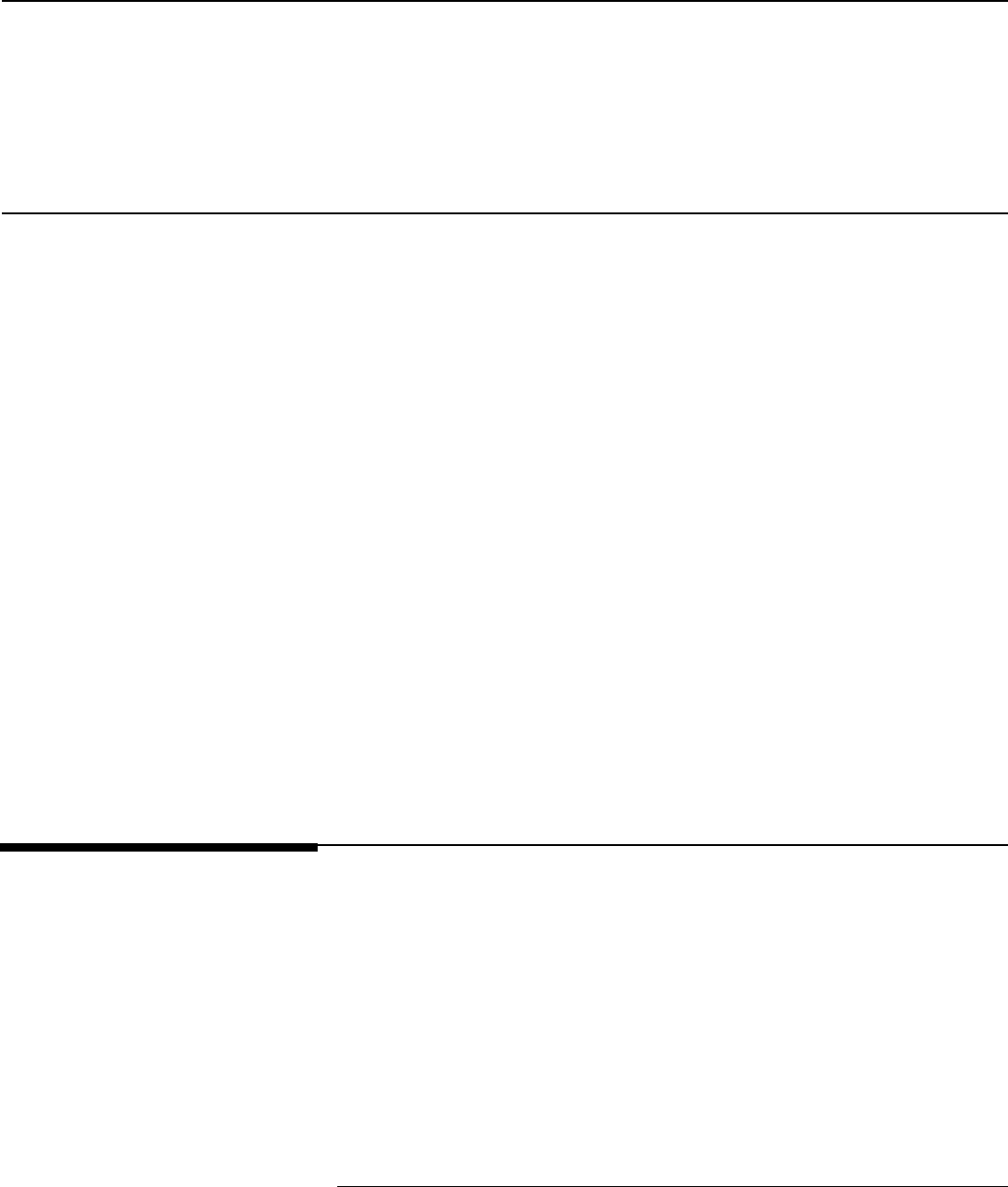
Representatives of the 3 remaining entities did express some concerns.
For example, staff at one payment services provider told us that some
banks have been told by Federal Reserve staff that if they did not process
sufficient volumes on both of the competing ACH networks—those
operated by The Clearing House and by the Reserve Banks—it could be
seen as a supervisory issue. Representatives of another institution told us
that when they moved their check-clearing business from the Federal
Reserve to a competing provider more than 3 years ago, Federal Reserve
payment services employees allegedly made comments suggesting
negative implications for the institution. But since then, the Federal
Reserve has been this entity’s primary supervisor and the representatives
said that the Federal Reserve has not taken any inappropriate actions.
The third entity that expressed concerns was a large bank that is
supervised by the Federal Reserve and offers payment services to
others. Representatives of this bank noted their Federal Reserve
examiners had not exercised any pressure on their institution to use the
Federal Reserve’s payment services but questioned the appropriateness
of the Federal Reserve offering comments on pricing on the ACH
payment association’s proposal to implement same-day ACH
transactions.
Page 57 GAO-16-614 Payment System Competition
48
Federal Reserve staff noted that these concerns related to
the establishment, calculation, and future management of an interbank
fee (in the nature of an interchange fee) for the ACH system’s same-day
settlement transactions that would be processed by the Reserve Banks
as an ACH operator under the proposed rules of NACHA for this service.
Market participants we interviewed generally support the Reserve Banks’
role as providers of payment services. Many of the 34 market participants
we interviewed—bank and credit union users of payment services and
private-sector providers of payment services (both direct competitors and
others involved in payment services activities)—said that the Federal
Reserve has an important role in the payment system. Several market
participants, including those that compete with the Reserve Banks in
providing payment services, said that the Federal Reserve successfully
promotes ubiquitous access to payment services and should continue to
do so.
48
While ACH transactions are normally processed and settled the next day, in December
2014, NACHA sought public comments on implementing same-day processing of ACH.
MarketParticipants
GenerallySupporta
ContinuedRolefor
theFederalReserve
inthePayments
System

Representatives of all 12 financial institutions that we interviewed that
used the Reserve Banks’ payment services generally expressed positive
views about the Federal Reserve’s roles in the payment system, including
comments about the Federal Reserve providing stability, promoting
competition, ensuring access to all institutions, and promoting innovation
in the payments industry. Representatives of one large bank said that the
Reserve Banks have strengthened competition in the market and put
pressure on private-sector providers, which has benefitted all parties.
Representatives of a community bank said that they think the Reserve
Banks provide a valuable service, especially to community banks.
Representatives from 2 of the 12 financial institutions had concerns about
the Federal Reserve’s roles in payment services. Representatives from
one large federal credit union said that the Reserve Banks’ prices were
low and their service very good, but worried that the Reserve Banks’
actions to lower prices might weaken competition in this market. In
contrast, representatives of several smaller financial institutions with
whom we met said that they appreciated the Reserve Banks’ services in
the payments system and preferred to use their services over a private-
sector competitor. One bank official from a smaller institution said that
although the Reserve Banks’ prices were not necessarily lower than the
prices of private-sector providers, the official preferred the quality of
service in the provision of services.
Similarly, in our interviews all three payment service providers that do not
compete directly with the Reserve Banks said that they generally thought
the Reserve Banks’ provision of payment services has helped the
payment services industry. One provider said that the Federal Reserve
actively promoted innovation in the payments industry, citing the Federal
Reserve’s involvement in transitioning the check industry to digital
imaging, despite the resulting decrease in its own market share in that
payment service. Representatives from another provider said that they
believed that the Federal Reserve has always played the role of an
“industry helper” and cited the Federal Reserve’s roles in guiding the
industry toward adopting innovations in the coming years.
However, representatives from some competing payment service
providers said that they would prefer the Reserve Banks to compete less
actively in the payment services market. At least 6 of 12 competing
payment service providers and one trade association with members that
are competing providers said that they thought the Reserve Banks should
compete less actively in the payment services market, and several
suggested that the Federal Reserve instead become more of a payment
service “provider of last resort,” as illustrated in the following examples.
Page 58 GAO-16-614 Payment System Competition

· Representatives from one large bank said that for years they
considered the Reserve Banks as providing a critical function through
their connections to many institutions. But they noted that the Reserve
Banks recently made price and product changes to attract more
business and that undermined market competition. The staff said that
they would prefer the Reserve Banks to become providers of last
resort.
· Some private-sector providers suggested that the Federal Reserve
stop providing payment services and instead focus more on ensuring
ubiquitous access to all financial institutions or simply act as a
regulator by creating and overseeing rules for the private-sector
providers. Staff from one medium-sized bank said that they thought
the Reserve Banks should instead focus on setting the rules as a
regulator of the payments system, while staff from a corporate credit
union said the Reserve Banks should instead focus on settlement,
and not clearing of payments. However, Federal Reserve staff told us
that cost recovery requirements dictate that the Reserve Banks
remain an active service provider, because being a “provider of last
resort” would require them to make transactions too expensive. They
said that larger-volume customers likely would use other providers,
leaving revenue from the lower-volume customers that remained to
recover costs. Moreover, they indicated that, if the Reserve Banks
were providers of last resort, the Federal Reserve would likely not be
able to meet its statutory cost-recovery requirement and would not
further its mission to foster the efficiency of the payments system or
ensure ubiquitous access.
· Representatives of two payment service providers said that the
Federal Reserve could be more transparent in its payment service
pricing and compliance with the Monetary Control Act’s cost recovery
requirements. The pricing principles the Board developed in response
to the Monetary Control Act require the Reserve Banks to publish their
prices and to solicit public comments when proposing pricing or
product changes that are expected to have significant longer-term
effects on the payments system.
Representatives of TCH said that, while TCH welcomes competition from
the Federal Reserve, they believe that such competition should be strictly
in compliance with the Monetary Control Act, and that the Federal
Reserve should be transparent about such compliance.
Page 59 GAO-16-614 Payment System Competition

In acknowledgment of the need to ensure that the United States keeps
pace with advancements in the payments system, the Federal Reserve
has been convening groups of stakeholders to explore ways to improve
the payments system, including bringing about faster and more secure
payments. The Federal Reserve cited the rapid changes to the payments
process brought on by high-speed data networks and other technology,
as well as the escalating security threats towards existing payment
systems, as evidence of the need for all stakeholders to join to improve
the payment system. (Payment system stakeholders include large and
small businesses, emerging payments firms, card networks, payment
processors, consumers, financial institutions, and government agencies.)
Furthermore, consumers and businesses have begun to desire fast,
convenient, ubiquitous, safe, and inexpensive payment options, according
to an international payments network. While other countries have
developed real-time or near real-time retail payments systems, the U.S.
payments system does not have a ubiquitous, convenient, and cost-
effective way for consumers and businesses to make real-time or near
real-time payments. According to a 2015 white paper from the same
international payments network, 18 countries have real-time retail
payments systems, an additional 12 countries have been either exploring
or developing them, and another 17 have been considering developing a
system that would span multiple countries.
Page 60 GAO-16-614 Payment System Competition
49
In one example, Australia
has been making the transition to its New Payments Platform, which is
designed to enable future payments to be processed and settled in real
time with finality, even outside of normal banking hours.
To help begin the process and explore and solicit input on concepts and
criteria for a new system for the United States, the Federal Reserve
published a public consultation paper on improving the payments system
in September 2013.
50
This paper provided perspectives on the key gaps
in the current U.S. payment system and identified desired outcomes to
address the gaps. Specifically, the Federal Reserve identified eight gaps
and opportunities for improvement in the current payment environment,
49
SWIFT, The Global Adoption of Real-Time Retail Payments Systems (RT-RPS) (La
Hulpe, Belgium: 2015), accessed June 6, 2016.
https://www.swift.com/your-needs/real-time-payments.
50
The Federal Reserve Banks, Payment System Improvement – Public Consultation
Paper, September 10, 2013, accessed June 6, 2016.
https://fedpaymentsimprovement.org/wp-content/uploads/2013/09/Payment_System_Impr
ovement-Public_Consultation_Paper.pdf.
TheFederalReserveHas
BeenEngaging
StakeholderstoImprove
thePaymentsSystem

which included end users’ increased demand for real-time transactions
and timely notifications; the lack of ubiquity in currently operating
electronic payment services (as compared with legacy systems such as
checks); and the challenges associated with cross-border payments. The
paper also identified five desired outcomes to be achieved within 10 years
to address these gaps and opportunities. These desired outcomes
included having payment participants collectively identify and embrace
key improvements, implementing process improvements that reduce
costs and increase innovations over the long run, and having a system
that offers consumers and businesses greater choice and security.
The Federal Reserve obtained nearly 200 written responses from industry
stakeholders on the consultation paper, and published these responses
and the Federal Reserve staff summary of the responses on its website.
Page 61 GAO-16-614 Payment System Competition
51
According to the summary document, about 75 percent of the written
responses agreed with the gaps, opportunities, and desired outcomes the
paper had identified. Commenters also suggested additional areas for
focus, particularly related to ensuring comparable regulation for payment
providers and addressing the needs of the unbanked or underbanked.
52
For example, according to the Federal Reserve’s summary document,
depository institutions broadly argued that they are held to higher
regulatory and risk-management standards than nonbank payment
providers, and merchants expressed desire for a payment system
governance structure that allows them to have more influence. According
to the summary document, many respondents opined that a 10-year plan
to improve the payments system was not aggressive enough, and that
more action should be taken in the near term.
To advance this effort, in January of 2015 the Federal Reserve issued
Strategies for Improving the U.S. Payment System, a document that sets
forth its strategies for bringing together all stakeholders to improve the
51
Stakeholder comments and comment summary documents available at:
http://www.fedpaymentsimprovement.org.
52
The Federal Deposit Insurance Corporation has defined “unbanked” households as
those without checking or savings accounts and “underbanked” households as those that
have such accounts but also rely on alternative financial services. See Federal Deposit
Insurance Corporation, 2013 FDIC National Survey of Unbanked and Underbanked
Households, October 2014, accessed July 5th, 2016.
http://www.fdic.gov/householdsurvey.

payment system.
Page 62 GAO-16-614 Payment System Competition
53
In this document, the Federal Reserve refined and
finalized the five desired outcomes into the following categories: speed,
security, efficiency, international, and collaboration. In addition, the
Federal Reserve identified five strategies to improve the payment system
in the United States:
· actively engage with stakeholders on initiatives designed to improve
the U.S. payment system;
· identify effective approaches for implementing a safe, ubiquitous,
faster payments capability in the United States;
· work to reduce fraud risk and advance the safety, security, and
resiliency of the payment system;
· achieve greater end-to-end efficiency for domestic and cross-border
payments; and
· enhance Reserve Bank payments, settlement, and risk-management
services.
Since then, the Federal Reserve has been forming task forces of industry
stakeholders, with one task force focused on evaluating effective
approaches of a faster payments system, and the other focused on
promoting payment security. These task forces have developed
effectiveness criteria for assessing alternative solutions for faster
payments and the Federal Reserve has also appointed key staff to
support and guide these efforts.
Although some market participants expressed concerns to us about the
Federal Reserve’s process for moving toward a faster payments solution,
Federal Reserve staff told us that these concerns appeared to reflect
misunderstandings of the process. For example, representatives from a
payment service trade association with whom we spoke said that the
Federal Reserve was making edits and inserting criteria in documents
containing stakeholder perspectives to emphasize its own service
offerings. Specifically, they said that the Federal Reserve inserted a
criterion that suggested that all faster payments positions should settle
53
Federal Reserve System, Strategies for Improving the U.S. Payment System, January
26, 2015.
https://fedpaymentsimprovement.org/wp-content/uploads/strategies-improving-us-paymen
t-system.pdf

with the Reserve Banks. However, Federal Reserve staff noted that the
criterion in question states “The solution should either enable settlement
in central bank money, or minimize and strictly control the credit and
liquidity risk arising from the use of commercial bank money for the inter-
provider settlement process.” They added that settlement in central bank
money does not mean that the Reserve Banks would operate the faster
payments solution, as evident in TCH’s ACH service that settles using
central bank money. Federal Reserve staff also told us that the drafting of
the criteria documents for the Faster Payments Initiative took place during
meetings of the Faster Payments Task Force and Steering Committee,
and that this was a transparent and rigorous process.
Representatives from a large bank also said that they were concerned
about an intellectual property requirement contained in the participation
agreement for stakeholders involved in the faster payments planning
process. They said that the Federal Reserve required participants to sign
an agreement that included language noting anything coming out of the
discussion would be the intellectual property of the Federal Reserve.
Because of these terms, the bank decided not to participate, and they
said that they knew of other financial institutions that felt similarly.
However, Federal Reserve staff said that the characterization of the
participation agreement language is not correct and that the agreement
does not limit a participant’s use of its own intellectual property. Instead,
they said that the agreement includes terms for fair, reasonable, and
nondiscriminatory licensing of intellectual property. In addition, there is an
opt-out provision in the agreement that allows participants to identify any
intellectual property present in a final report before it is published and
decline to grant the license for it. Furthermore, based on feedback from
the industry related to the intellectual property provisions, the Federal
Reserve revised the participation agreement in March 2016 to reduce the
scope and legal burdens for the participant in licensing its intellectual
property. Federal Reserve staff said that the vast majority of current
members have signed this agreement and additional industry participants
have also joined their effort after these revisions were made.
Page 63 GAO-16-614 Payment System Competition
54
54
Federal Reserve staff stated that 29 new members and approximately 81 percent of the
existing members executed the new agreement, with total membership of 292 as of July 1,
2016. According to Federal Reserve staff, feedback provided to them suggested that slight
attrition in membership was due to interest and capacity and not a result of concerns with
the amended agreement.

The presence and activities of the Federal Reserve in the payments
system generally have been beneficial, including by helping to lower the
cost of processing payments for many end-users. Market participants also
generally supported having the Federal Reserve continue to play multiple
roles in the payment system. The Federal Reserve also continues to
support innovation and process improvements for the payments in the
United States.
To help ensure that it competes fairly with the private sector, the Federal
Reserve uses a cost accounting system for capturing its payment system
costs that is detailed and generally in alignment with comparable federal
standards. It also uses a reasonable approach to impute the costs that it
would bear if it was a private entity and includes these in the costs that it
recovers with its payment services revenues. However, the Federal
Reserve has not included in its imputed costs some costs that its
competitors incur. These include those related to developing plans for
recovery and orderly wind down, which are costs that its primary
competitor in wire transfers has had to incur to comply with new
requirements for resolution planning for systemically important payment
system entities. Also, the Federal Reserve has not included costs borne
by private-sector providers related to complying with antimoney-
laundering requirements. By including these costs, the Federal Reserve
would more completely impute and recover costs that it would have
incurred as a private firm.
In addition, although it also conducts internal reviews to help ensure that
it captures the required costs accurately, the cost accounting system has
not been specifically reviewed by an external auditor in more than 30
years. Internal control standards state that compliance with applicable
laws and regulations is a key internal control objective, and a key means
of providing such assurance can be the performance of monitoring
activities, which can include external reviews, to ensure that such
compliance is occurring. Having its cost accounting practices periodically
subject to independent testing would provide greater assurance that the
Federal Reserve is complying with the Monetary Control Act.
To provide greater assurance that the Federal Reserve is complying with
the Monetary Control Act’s requirement to establish fees on the basis of
costs actually incurred and an allocation of imputed private-sector costs,
the Chair of the Federal Reserve Board of Governors of the Federal
Reserve System should:
Page 64 GAO-16-614 Payment System Competition
Conclusions
Recommendationsfor
ExecutiveAction

· Consider ways to incorporate the costs related to integrated planning
for recovery and wind down and compliance with antimoney-
laundering requirements, to the extent practicable, in its imputed
private-sector cost methodology.
· Periodically obtain independent testing of the methods the Federal
Reserve uses to capture its actual costs and simulate those of the
private sector.
We provided a draft of this report to the Federal Reserve and to The
Clearing House for review and comment. The Federal Reserve provided
written comments that we reprinted in appendix V. The Federal Reserve
and The Clearing House also provided technical comments that we
incorporated, as appropriate.
In written comments, the Federal Reserve stated that it is planning to take
steps in response to both recommendations. In response to our
recommendation that it consider ways to incorporate costs related to
integrated planning for recovery and wind down and compliance with
antimoney-laundering requirements in its imputed private-sector cost
methodology, the Federal Reserve’s letter stated that it will consider ways
to incorporate these costs. The Federal Reserve noted that, in some
cases, these costs are difficult to measure, given the challenges in
obtaining financial information from private-sector payment service
providers. In other cases, the Federal Reserve noted that it already bears
costs that its competitors do not. In response to our recommendation that
the methods the Federal Reserve uses to capture its actual costs and
simulate those of the private sector be independently tested periodically,
the Federal Reserve stated that it will procure an independent review of
the methods used for capturing actual and imputed costs related to its
payment services. We acknowledge this step and note that having such
reviews performed periodically will provide greater assurance to all
payment services market participants of the Federal Reserve’s
compliance with the Monetary Control Act.
Along with its technical comments, The Clearing House noted an
appreciation of our recommendations that the Federal Reserve consider
ways to incorporate certain costs borne by the private sector in providing
payment services and obtain periodic independent cost-capturing system
testing. However, The Clearing House also stated that it was
disappointed in our other findings, which did not appear to reflect the data
provided to us on a variety of issues. We believe we incorporated the
Page 65 GAO-16-614 Payment System Competition
AgencyComments,
Third-PartyViews,
andOurEvaluation
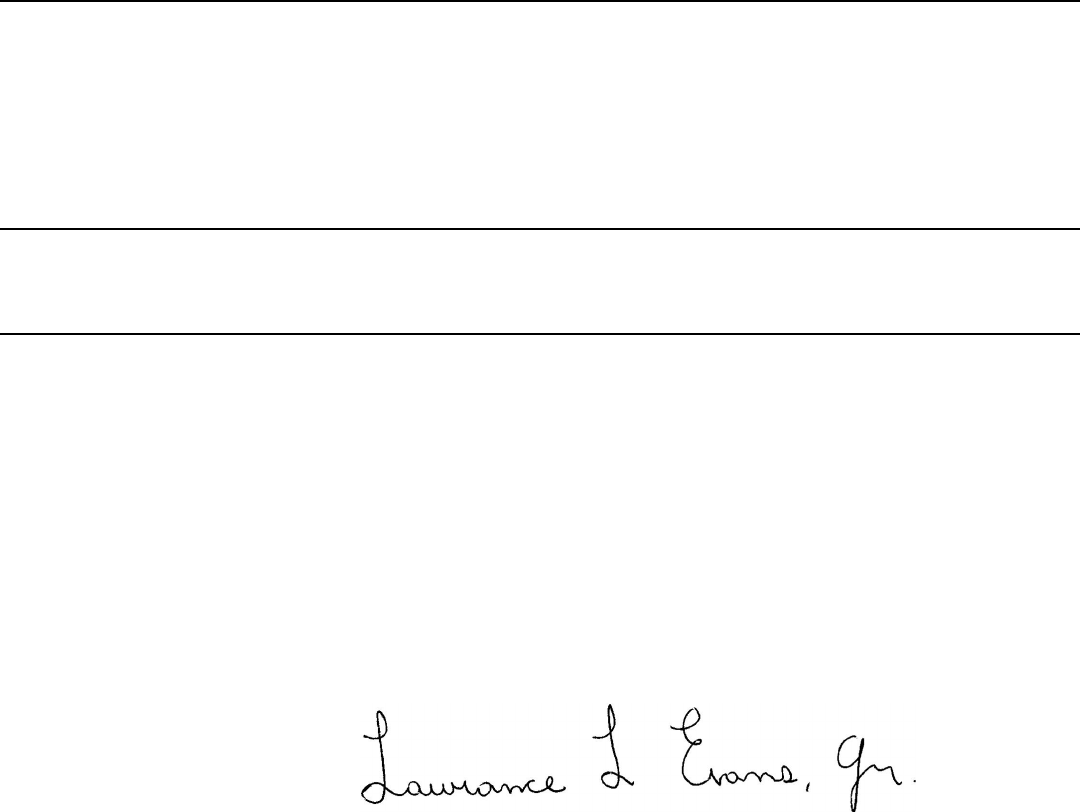
information provided by The Clearing House to the extent possible as
appropriate.
As agreed with your office, unless you publicly announce the contents of
this report earlier, we plan no further distribution until 30 days from the
report date. At that time, we will send copies to the Federal Reserve and
other interested parties as appropriate. In addition, the report will be
available at no charge on the GAO website at http://www.gao.gov.
If you or your staff have any questions about this report, please contact
me at (202) 512-8678 or [email protected]. Contact points for our Offices
of Congressional Relations and Public Affairs may be found on the last
page of this report. GAO staff who made key contributions to this report
are listed in appendix v.
Sincerely yours,
Lawrance L. Evans, Jr.
Director, Financial Markets
and Community Investment
Page 66 GAO-16-614 Payment System Competition

Appendix I: Objectives, Scope, and
Methodology
This report focuses on three payment system services offered by the
Federal Reserve—check clearing, electronic payments known as
Automated Clearing House (ACH) payments, and wire transfer
payments—because these are the services in which the Federal Reserve
competes with private-sector entities. This report examined (1) how
effectively the Federal Reserve captures and recovers its payment
services costs; (2) the effect of the Federal Reserve’s practices on
competition in the payment services market; (3) how the Federal Reserve
mitigates the inherent conflicts posed by its various roles in the payments
system; and (4) market participant viewpoints on the future role of the
Federal Reserve in the payments system.
To examine how effectively the Federal Reserve has recovered the costs
of providing these payment services, we analyzed data on overall
reported revenues and expenses associated with the three payment
services from 1996 through 2015. We also analyzed data on the specific
expenses associated with the payment services from 2001 through 2014
to identify relevant trends and cost structures. We assessed the reliability
of these data by interviewing relevant Federal Reserve officials about the
controls and quality assurance practices they used to compile these data,
and determined the data were reliable for these purposes. We
interviewed Federal Reserve staff about the processes used for capturing
these costs and reviewed the Federal Reserve’s Planning and Control
System (PACS) Manual for Federal Reserve Banks, which establishes
cost accounting policies for the payment services at all Federal Reserve
Banks, whose staff conduct the payment services activities. We obtained
expert opinions on the soundness of the policies and practices detailed in
the PACS manual, including consulting internally with a cost accounting
expert within GAO, as well as with representatives from the auditing firm
that had conducted the 2014 audit of the Federal Reserve’s financial
statements. We analyzed 12 reviews conducted by an internal Board staff
between 2012 and 2015 and a judgmental selection of 9 audits conducted
by the internal audit staff of the Reserve Banks to determine the extent of
their findings related to cost accounting practices.
Page 67 GAO-16-614 Payment System Competition
1
We also reviewed the
only external audit that had examined the cost accounting practices at the
Federal Reserve Banks that had been conducted in 1984. No private-
sector cost accounting standards existed to compare to the cost
1
The internal Reserve Bank audits were selected from a list of payment service audits
conducted at the Reserve Banks between 2011 and December 2015.
AppendixI:Objectives,Scope,and
Methodology

Appendix I: Objectives, Scope, and
Methodology
accounting practices followed by the Reserve Banks, which are federally
chartered but organized as private corporations. As a result, we
compared the design of PACS to the elements that federal managerial
cost accounting standards—Statement of Federal Financial Accounting
Standards 4—recommend be included in federal agency cost accounting
systems to determine how the Federal Reserve’s practices aligned with a
comparable standard.
To determine how the Federal Reserve was imputing and recovering
costs that would have been incurred had its payment services been
provided by a private firm, in accordance with the Monetary Control Act,
we examined data and documentation relating to the Federal Reserve’s
methodology for computing this “private sector adjustment factor” (PSAF).
Based on our assessment of the controls and quality assurance practices
the Federal Reserve used to compile these data, we determined the data
were reliable for this purpose. We consulted with an internal GAO
financial markets expert, a financial analyst who monitors payment
service market participants, and three academic financial experts on the
reasonableness of the methodology’s assumptions. We reviewed notices
in the Federal Register from 2005 through 2014 that detailed proposed
and final changes to the methodology over this period. For further
explanation of these issues we spoke with Federal Reserve staff who
oversee payment services activities. We also interviewed a financial trade
association that issues rules governing payment system activities and
whose members participate in the payments industry, as well as
representatives of a major payment services provider to get their opinions
on the Federal Reserve’s PSAF methodology. We also reviewed industry
documentation on criticisms of the Federal Reserve’s PSAF methodology.
To examine how the Federal Reserve prices its payment services and
assesses the impact of its competition in this market, we analyzed volume
and pricing data for the Federal Reserve’s check, wire, and ACH payment
services from 2004 to 2014, including publicly available fee schedules.
We also analyzed Federal Reserve pricing and revenue data for each of
these services, including examining trends in service prices over time. To
ensure that these data were sufficiently reliable for our purposes, we
verified that we had obtained complete data on the revenue by type of
customer by comparing them to the annual revenue totals reported
publicly by the Federal Reserve. Based on this comparison and our
assessment of the controls and quality assurance practices the Federal
Reserve used to compile these data, we determined the data were
reliable for this purpose. We also reviewed Federal Reserve
documentation on pricing its services and on competitive impact
Page 68 GAO-16-614 Payment System Competition

Appendix I: Objectives, Scope, and
Methodology
analyses, including policies, guidance, and Federal Register notices. We
interviewed Federal Reserve staff for information on how they price their
services and compete in the payments market. We also interviewed staff
from the Department of Justice to better understand what practices can
be considered anticompetitive.
For the perspectives of market participants on the Federal Reserve’s
pricing and competitive impact in the payments industry, we interviewed
34 market participants, including:
· 7 financial trade associations whose members participate in payment
systems and/or issue rules governing payment system activities
(NACHA and the Electronic Check Clearing House Organization).
· 12 entities that provide payment services that compete with the
Federal Reserve, including
· 3 nonfinancial institution service providers,
· 6 correspondent banks that provide payment services to other
institutions but also offer banking services to individual corporate
and retail customers,
· 2 corporate credit unions and 1 bankers’ bank that conduct
payment services and other activities for other institutions.
· 3 nonfinancial institution payment services providers that did not
compete with the Federal Reserve.
· 12 financial institutions that were end users of payment services from
other private-sector providers and/or the Federal Reserve, including
· 8 banks (including 6 that were regulated by the Federal Reserve),
and
· 4 credit unions.
We selected the financial institutions that used the Federal Reserve or
private-sector providers in two ways. First, we interviewed the 5 largest
bank holding companies by total assets in the United States. Some of
these institutions are both providers of payment services and users of the
Page 69 GAO-16-614 Payment System Competition

Appendix I: Objectives, Scope, and
Methodology
Federal Reserve’s services. Second, we interviewed an additional 11
banks and credit unions that were chosen by random selection within the
following tiers based on total assets:
· Banks (7)
· >$50 billion (3 large)
· $10-$50 billion (2 midsized)
· <$10 billion (2 small)
· Credit Unions (4)
· >$5 billion (3 large)
· <$5 billion (1 small)
The entities we interviewed that provide payment services were those
selected randomly from a larger sample of institutions identified by a
payments industry association and those identified in other interviews as
service providers with valuable knowledge of the industry.
We also analyzed data from the Federal Reserve that included the
revenues it earned from various customer categories that it tracked
internally. These categories included various ones for customer
institutions of various asset sizes and for other entities, such as bankers’
banks or foreign banks. We used these data to identify the extent to
which the Federal Reserve’s revenues had changed over time and how
the amounts paid by different customer groups had changed. Because of
circumstances in the check market—including the industry’s transition to
images—we determined that the data for check were only sufficiently
comparable from the period between 2007 and 2014, which was the last
year that we obtained complete transaction volume data from the Federal
Reserve. Data for ACH and wire transfers appeared to be sufficiently
comparable from 2005 to 2014. Based on our assessment of the controls
and quality assurance practices the Federal Reserve used to compile
these data, we determined the data were reliable for this purpose.
To examine how the Federal Reserve mitigates the inherent conflicts
posed by its various roles in the payments system, we reviewed the
Federal Reserve’s policies related to its payment services organizational
structure and the requirements related to the conduct of its staff in the
Monetary Control Act and relevant Federal Reserve policies. We also
reviewed additional guidance the Federal Reserve provided to its staff on
the conduct of its payment services activities. We also reviewed training
Page 70 GAO-16-614 Payment System Competition

Appendix I: Objectives, Scope, and
Methodology
materials the Federal Reserve used to inform its staff about requirements
relating to its payment services activities. In addition, we reviewed audits
or other reviews done by the Board’s Inspector General or other bodies
related to the conduct of its payment services activities. We interviewed
the Federal Reserve Board staff who oversee payment services activities,
including about the extent to which they received complaints from market
participants and about the conduct of the Federal Reserve’s payment
services activities. In addition, we interviewed representatives of the 34
market participants to obtain their perspectives on the conflicts in the
Federal Reserve’s roles in the U.S. payments system.
To examine market participant viewpoints on the future role of the Federal
Reserve in the payments system, we interviewed representatives of the
34 market participants, including bank and credit union users of payment
services and private-sector providers of payment services (both direct
competitors and others involved in payment system activities). We also
reviewed the Federal Reserve’s policies that outline the criteria it would
consider before offering a new payment service, including comment
letters publicly posted by industry stakeholders in response to the Federal
Reserve’s public consultation paper. We also obtained views of Federal
Reserve staff about their payments improvement initiative.
We conducted this performance audit from November 2014 to August
2016 in accordance with generally accepted government auditing
standards. Those standards require that we plan and perform the audit to
obtain sufficient, appropriate evidence to provide a reasonable basis for
our findings and conclusions based on our audit objectives. We believe
that the evidence obtained provides a reasonable basis for our findings
and conclusions based on our audit objectives.
Page 71 GAO-16-614 Payment System Competition

Appendix II: Federal Reserve Payment
Services Cost Accounting
The Monetary Control Act requires that over the long run the Federal
Reserve’s fees be established on the basis of all direct and indirect costs
actually incurred in providing payment services, and an allocation of
imputed costs that would have been incurred by a private-sector provider.
The Federal Reserve Banks use a detailed cost accounting system that
helps them meet their requirements relating to how to set fees and
account for and recover costs incurred as part of providing payment
services.
According to data provided to us by the Federal Reserve, The Federal
Reserve Banks incurred more than $410 million in costs as part of
providing payment services in 2014 (see table 2). Of these, personnel
costs represented about 7 percent of total payment services costs.
Support costs represented the large majority of the costs of payment
services activities. Nearly 78 percent of the overall costs of providing
payment services arose from almost $320 million of expenses allocated
to those services by the Federal Reserve’s National Support Services.
These costs included the expenses arising from developing software
applications, implementing information security, providing help-desk
services, business development activities, accounting, and other support
functions. The Federal Reserve Banks’ payment services were also
allocated more than $28 million in local support services costs that
include Reserve Bank information, technology services, audit expenses,
and general administrative services. More than $22 million in various
overhead costs—representing about 5 percent of overall payment
services costs—were also allocated to payment services activities, and
these included, Federal Reserve staff told us, expenses associated with
overall corporate-wide functions such as bank administration, accounting,
and contingency planning.
Page 72 GAO-16-614 Payment System Competition
AppendixII:FederalReservePayment
ServicesCostAccounting
FederalReservePayment
ServicesCosts

Appendix II: Federal Reserve Payment
Services Cost Accounting
Table 2: 2014 Federal Reserve Payment Services Direct and Indirect Costs (in Dollars)
Page 73 GAO-16-614 Payment System Competition
Actual cost ($)
Percentage of total cost
Total cost
410,305,215
100.0
Personnel
28,961,178
7.06
Materials and supplies
146,077
0.04
Equipment
356,925
0.09
Software costs
8,124,382
1.98
Shipping
316,514
0.08
Travel
566,509
0.14
Communications
148,557
0.04
Building
160,946
0.04
Other
1,154,666
0.28
Recoveries
a
(95,851)
-0.02
Support
348,120,529
84.84
Local support
28,156,949
6.86
National support
319,963,580
77.98
Development/maintenance of software applications
138,817,178
33.83
Use of the Fedline application and associated utilities
75,146,371
18.31
National information technology support
31,173,454
7.60
Management, including planning, oversight and
management of production environment
32,353,097
7.89
Sales and business development services
19,308,006
4.71
Accounting and other support functions
23,165,475
5.65
Overhead
22,344,784
5.45
Source: Federal Reserve. | GAO-16-614
Notes: This table excludes the additional imputed costs that the Federal Reserve adds to its payment
services costs to simulate the costs that would also be incurred if these services were provided by a
private-sector entity.
a
Recoveries are defined as receipts of funds for an incidental service or product produced by the
Reserve Banks in the course of accomplishing the basic responsibilities of the Federal Reserve
System. Recoveries include, but are not limited to, receipts for such items as tenant rent, cafeteria
services, and manual fees, periodicals, publications, and regulations.
According to the Planning and Control System (PACS) Manual for the
Federal Reserve Banks, every dollar expended (or received) by the
Reserve Banks is recorded into three cost categories: account,
department, and activity. Federal Reserve staff described how a Reserve
Bank’s expense related to a $10,000 contribution to the employees’
retirement thrift plan account would be recorded in the following way.
ReserveBanks’Cost
AccountingSystem

Appendix II: Federal Reserve Payment
Services Cost Accounting
· Initially, costs are recorded at the account level. In this example, these
contributions are recorded in a “Retirement and other benefits – Thrift
Plan” expense account.
· Because the contributions were made for employees who work in
different departments, the Federal Reserve would allocate these
expenses to departments using various allocation methods. For
example, the Retail Electronic Payments Department at a given
Reserve Bank would be allocated some of the retirement expenses.
The allocation would be calculated based on a “salary dollar ratio
distribution,” equal to the salary expense of the department divided by
the total salary expense of the Reserve Bank. Therefore, if the
salaries in the department represented 1 percent of the salaries of the
Reserve Bank, 1 percent of the retirement plan contribution ($100)
would be allocated to the Retail Electronic Payments Department.
· Subsequently, the Federal Reserve would further allocate this
departmental expense among the various activities that the
department tracks. For example, if 70 percent of the department’s
operations were devoted to automated clearing house (ACH) activities
and 30 percent were associated with check processing, $70 of the
department’s allocated retirement expense would be recorded under
ACH activity and $30 under check activity.
Similarly, the Federal Reserve Banks’ payment services would be
allocated support and overhead expenses using the methods and
procedures prescribed in the PACS manual, such as using a fixed
percentage of some other factor or on a dollar-ratio basis. For example,
maintenance expenses incurred at one Reserve Bank may be allocated
to payment services activities on the basis of the amount of space their
operations occupy in the bank’s buildings.
Page 74 GAO-16-614 Payment System Competition

Appendix III: Private Sector Adjustment Factor
(PSAF) Methodology
As it is required under the Monetary Control Act to calculate imputed
private-sector costs and return on capital, the Board of Governors of the
Federal Reserve System (Board) has developed a PSAF methodology
that allows it to calculate four costs that they do not incur, but that a
typical private-sector payment services provider would incur: debt
financing costs, equity financing costs (or return on equity), taxes, and
payment services’ share of Federal Reserve Board expenses. A private
firm providing payment services would need to raise capital to obtain the
funds to invest in the necessary facilities, equipment, and other assets
needed to conduct these activities. To determine the financing costs
associated with this debt and equity capital, the Federal Reserve
compiles the values of the actual assets it uses to conduct payment
services activities. In addition to its premises, furniture, and equipment,
these values may include an asset corresponding to the Federal
Reserve’s net pension plan obligations. The PSAF methodology assumes
that any short-term assets—such as supplies—are to be financed with
short-term debt and that long-term assets—such as facilities and
equipment—would be financed with long-term liabilities and a
combination of imputed long-term debt and equity. The methodology also
assumes that the Federal Reserve would use the same percentage mix of
long-term debt and equity that it derives from the U.S. publicly traded firm
index to finance its long-term assets not offset by long-term liabilities.
Page 75 GAO-16-614 Payment System Competition
1
Once it has identified the imputed amount of debt and equity it would
need to fund its capital structure, the Federal Reserve calculates the rates
for debt and equity financing. Using publicly available, market-based
interest rates, it calculates a total amount of interest that it would have to
pay for the year on the mix of short- and long-term debt amounts that
were identified based on its asset structure.
2
In 2016, the Federal
Reserve’s PSAF methodology determined that it would have paid a rate
1
Data for U.S. publicly traded firms are from the Standard and Poor’s Compustat®
database. This database contains information on more than 6,000 U.S. publicly traded
firms, which approximates the entirety of the U.S. market.
2
The imputed short- and long-term debt financing rates are derived from the nonfinancial
commercial paper rates from the Federal Reserve Board’s H.15 Selected Interest Rates
release (AA and A2/P2) and the annual Merrill Lynch Corporate & High Yield Index rate,
respectively.
AppendixIII:PrivateSectorAdjustment
Factor(PSAF)Methodology

Appendix III: Private Sector Adjustment Factor
(PSAF) Methodology
of 0.3 percent on $19 million of short-term debt.
Page 76 GAO-16-614 Payment System Competition
3
The long-term debt
financing rate was 4.2 percent.
4
To determine the cost of the equity it would have to use to finance its
payment services activities’ assets, the Federal Reserve uses a generally
accepted financial formula for calculating the expected rate of return on
equity that investors would demand based on its risk relative to the
market as a whole.
5
In 2016, the PSAF model calculated a pre-tax return
on equity of about 9.8 percent, which represented additional imputed
financing costs of $5.3 million.
After these total imputed financing costs of debt and return on equity are
calculated, the Federal Reserve’s PSAF methodology imputes two
additional costs that a private-sector firm likely would incur. The first of
these additional costs is an amount equivalent to the sales taxes that the
Federal Reserve Banks would have incurred based on budgeted outlays
for materials, supplies, and capital. These costs must be included as part
of the allocation of imputed costs under the criteria listed in the Monetary
Control Act. Furthermore, these costs are imputed rather than actual
because the Federal Reserve Banks are exempt from paying sales taxes
under the Federal Reserve Act. Then payment services’ share of Federal
Reserve Board expenses, which Federal Reserve staff said are costs
associated with the Board’s supervision of the payment services
operations conducted by the Reserve Banks, are included in the PSAF,
because, Federal Reserve staff told us, these costs are not captured by
the PACS (which captures the actual costs Reserve Banks incur). In
2016, the expenses related to Board supervision and to imputed sales
taxes were calculated to be $5.0 million and $2.8 million, respectively.
3
80 Fed. Reg. 70,783, 70,789 (Nov. 16, 2015).
4
In 2016, the Federal Reserve’s net long-term assets (long-term assets minus long-term
liabilities) on its pro forma balance sheet were not great enough to require any additional
financing using imputed long-term debt in the PSAF, so the 2016 PSAF did not include
any long-term debt financing costs.
5
The equity financing rate is calculated using the Capital Asset Pricing Model. In this
model, the required rate of return on a firm’s equity is equal to the return on a risk-free
asset plus a market risk premium. In the Federal Reserve’s methodology, the risk-free rate
is based on the 3-month Treasury bill, the equity risk measure (its beta) is assumed to be
equal to 1.0 or the average of the risk of the market as a whole, and the market risk
premium is based on the equity market returns in excess of the risk-free rate over the
most recent 40 years.

Appendix III: Private Sector Adjustment Factor
(PSAF) Methodology
Using its PSAF methodology, in 2016 the Federal Reserve calculated a
total PSAF cost of $13.1 million that would have been incurred if the
Reserve Banks were a private-sector provider, down from $18.0 million in
2015, as shown in table 3. This amount was allocated to each payment
service based on the percentage of the projected operating expenses of
the Federal Reserve Banks’ payment services that each service
represented.
Table 3: Component Expenses Calculated by the Federal Reserve’s Private-Sector Adjustment Factor (PSAF) in 2015 and
Page 77 GAO-16-614 Payment System Competition
2016, dollars in millions
A. Cost of capital
2016
2015
Elements of capital costs
N/A
N/A
N/A
N/A
N/A
N/A
Short-term debt
$19.0 x
0.3%=
$0.1
$18.5 x
0.2%=
$0.0
Long-term debt
— x
4.2%=
$0.0
$81.9 x
5.0% =
$4.1
Equity
$53.8 x
9.8% =
$5.3
$71.9 x
10.1% =
$7.3
N/A
N/A
N/A
$5.4
N/A
N/A
$11.4
B. Other required PSAF costs
N/A
N/A
N/A
N/A
N/A
N/A
Sales tax
N/A
$2.8
N/A
N/A
$3.3
N/A
Board of Governors expenses
N/A
$5.0
N/A
N/A
$3.3
N/A
N/A
N/A
N/A
$7.8
N/A
N/A
$6.6
C. Total PSAF
N/A
N/A
$13.1
N/A
N/A
$18.0
Legend: N/A = Not applicable
Source: Federal Reserve | GAO 16 614
As part of the Federal Reserve’s attempts to improve the PSAF’s
accuracy and conform it to changes in the payment system market,
Federal Reserve staff noted that the Board has made numerous changes
to the methodology over the years.
These changes included a change made in 2000 to begin allocating a
portion of the Federal Reserve’s prepaid pension asset and
postretirement and postemployment benefit liabilities into the asset and
equity amounts the PSAF used for calculating imputed financing costs
and returns on equity. This change was made because the value of the
prepaid pension assets began to increase significantly due to large
returns generated from its investments and because the effects of prepaid
pension assets were being included in the balance sheets of the bank
holding companies the Federal Reserve was using as its peer group to
compute the PSAF’s financing rates and return on equity. This change
resulted in an additional $60.5 million of pretax imputed costs being
included in the 2000 PSAF amount. In 2005, the Federal Reserve
PSAFMethodology
ChangesOverTime

Appendix III: Private Sector Adjustment Factor
(PSAF) Methodology
simplified its methodology for calculating the PSAF’s equity financing rate
by shifting from an average of three separate financing models to a single
calculation based on the return on equity investors would demand based
on the risk in the market.
In the past, the Federal Reserve used financial information from large
U.S. bank holding companies to calculate elements of the PSAF. For
example, from 1981 to 2001, the Federal Reserve had been using the
average debt and equity proportions used by the top bank holding
companies in the United States, before setting the equity imputed into the
PSAF to meet the FDIC definition of a well-capitalized institution.
Additionally, the financial information from large bank holding companies
was used to calculate the PSAF’s return on equity until 2006 and imputed
taxes until 2013. In 2012, the Board adopted a policy of basing the
imputed capital structure, debt and ROE rates, and tax rates on data for
the U.S. publicly traded firm market. Federal Reserve staff noted that over
time bank holding companies were engaged in different businesses and
had risk profiles that were beyond those represented by the payment
services of the Reserve Banks, many of which are now provided by
nonbank entities. In 2012, the Federal Reserve amended Regulation D,
governing reserve requirements, to eliminate the clearing balance
program, which was largely modeled after similar programs offered by
correspondent banks, wherein banks maintain balances with their
correspondents. The level of clearing balances held at the Reserve Banks
had declined after the Federal Reserve began paying interest on deposit
balances held at Reserve Banks. Federal Reserve staff noted that the
elimination of the clearing balance program significantly changed the size
and nature of the assets and liabilities associated with the payment
services to such an extent that the Federal Reserve determined that the
use of bank holding companies as the peer group was no longer
appropriate for the PSAF methodology.
Page 78 GAO-16-614 Payment System Competition

Appendix IV: Competitive Impact Assessment
Process
To ensure that it is not unfairly leveraging a possible legal advantage to
benefit its payment service activities, the Board of Governors of the
Federal Reserve System (Board) formally analyzes the potential
competitive impact of any significant changes in the Reserve Banks’
payment services pricing or product offerings. The process it uses for
conducting competitive impact analyses involves determining if a
proposed change would harm other providers due to legal differences,
and then weighing the potential harm of the change to competitors
against the potential benefits to the overall payments system. For each
price or service change proposal, the Board first considers whether the
change would have a direct and material adverse effect on the ability of
other service providers to compete with the Reserve Banks. According to
its policy, if the Board identifies such an effect, staff then determine
whether the effect was due to differing legal powers or the Reserve
Banks’ dominant market position deriving from such legal differences.
According to the Federal Reserve, existing legal disparities between the
Reserve Banks and the private sector include differences in the rules for
same-day settlement of paper checks, check presentment deadlines and
locations, the ability of the paying bank to impose reasonable delivery
requirements, and the control and timing of settlement. For example,
according to the Federal Reserve Act and Federal Reserve regulations,
every paying bank must accept paper checks from the Reserve Banks,
and the Reserve Banks can obtain a same-day payment from a paying
bank by debiting the paying bank’s account at a Reserve Bank without
being charged a presentment fee. While the Board addressed this
advantage through the adoption of Regulation CC in 1992 (effective in
1994), some market participants we interviewed noted that Regulation CC
applied to paper check clearing only, and does not address the Reserve
Banks’ advantage in the exchange of check images. In 1998 the Board
proposed limiting or eliminating this and all remaining legal disparities
between it and the private-sector competitors, but based on the public
comments they received, the Board concluded that the significant costs
associated with reducing the remaining legal disparities would outweigh
any efficiency gains to the payment services industry, and could result in
a reduction in efficiency to the payments system. For example, they said
that providing for a later settlement of Reserve Bank presentments would
delay the ability of the Reserve Banks to post credits for check deposits,
making intraday account management more difficult for many banks and
potentially increasing their daylight overdraft charges.
Federal Reserve staff told us that a competitive impact analysis could
indicate that a proposed change might have an adverse effect on private-
sector competitors, but still not be considered unfair as long as it was
Page 79 GAO-16-614 Payment System Competition
AppendixIV:CompetitiveImpact
AssessmentProcess

Appendix IV: Competitive Impact Assessment
Process
determined that the Reserve Banks would not be leveraging their legal
advantages. For example, the use of volume-based pricing and the
bundling of services that has concerned some private-sector competitors
did not raise objections in the Board’s competitive impact analysis
process because these changes were not deemed to rely on a legal
advantage.
If the analysis of a proposed new product or pricing change determines
that the Reserve Banks would obtain a competitive advantage stemming
from their legal advantages, Federal Reserve staff then must continue to
evaluate the proposed change to determine if the change furthers any
overarching Board objectives, such as increasing the efficiency of the
payments system or ensuring ubiquitous access. Staff must also consider
whether the objective of the proposed change could be met in another
way that would less adversely affect competing private-sector service
providers. Finally, the Board may decide to modify the proposed change
to lessen any adverse effects, or decide that the benefits to customers
are significant enough to adopt the proposed change despite the potential
for adverse effects on other competing market participants.
To help ensure that it is complying with its pricing policies and effectively
assessing its competitive impact, the Federal Reserve conducts various
internal reviews. Federal Reserve staff said that all product and pricing
changes must first be documented in a proposal by the relevant Reserve
Bank product office. These proposals are to include customer and market
competitive impact analyses. During proposal development, product office
staff sometimes also consult with industry work groups to solicit their
feedback. Once senior leadership in the product office achieve consensus
on the proposals, staff may then send the proposals to the Reserve
Banks’ Financial Services Policy Committee for its review and approval.
Page 80 GAO-16-614 Payment System Competition
1
The proposals—including the associated competitive impact analyses—
then are sent to the Board, although Federal Reserve staff said that they
often have ongoing and iterative discussions with Board staff prior to its
receipt of the proposals. Board staff then conduct their own independent
analysis of the proposals, and the Board will occasionally solicit additional
1
The Financial Service Policy Committee is responsible for the overall direction of financial
services and related support functions for the Federal Reserve Banks, as well as for
providing Federal Reserve Bank leadership in dealing with the evolving U.S. payments
system. The Committee is composed of three Reserve Bank Presidents and two Reserve
Bank first vice presidents.

Appendix IV: Competitive Impact Assessment
Process
public comments if it anticipates any significant long-term effects
associated with the proposal. Nonroutine changes to pricing and product
offerings are subject to approval by the Board or the director of its
Division of Reserve Bank Operations and Payment Systems.
The Federal Reserve estimated that staff have completed 32 competitive
impact analyses for nonroutine proposals since 2000, in addition to the
analyses conducted for routine proposals and for the Board’s public
rulemaking process, as necessary. Nonroutine proposals are those that
create a new service, create a new product line within an existing service,
introduce new pricing structures, or are expected to generate significant
comment from market participants. The Board’s annual repricing exercise
is considered as a single, nonroutine analysis. A routine proposal,
alternatively, is a new product or proposed change that only moderately
affects existing products or is expected to result in minimal action from
market participants. Federal Reserve staff estimated that they performed
an average of 2–3 nonroutine analyses and 8–9 total analyses each year.
After a new product introduction created controversy in 2013, the Federal
Reserve added additional controls to better ensure that any subsequent
changes would not result in unfair competition with the private sector. For
their 2013 fee schedule, the Reserve Banks introduced a new check-
clearing product known as “Choice Receiver,” which offered preferential
prices to customers for using a Reserve Bank as the presentment bank.
The Choice Receiver product was initially approved by the Board but later
challenged by private-sector competitors as unfair. After reviewing more
complete information about the product, Board staff said that they
concluded that its approval had been inappropriate because the product
office had not provided sufficient information to allow the Board to
evaluate whether the product relied on the Federal Reserve’s legal
advantages. Once all the relevant information had been considered, the
Board rescinded the product later that year because it was deemed to
have a direct and material adverse effect on the ability of other service
providers to compete effectively with the Federal Reserve due to legal
differences.
As a result of this experience, Federal Reserve staff told us they modified
their internal processes for analysis and review of proposed price and
service changes. For example, they created a competitive impact analysis
template that serves as a training tool for staff (staff respond to a series of
questions evaluating the potential adverse effect of proposed changes).
Reserve Banks also implemented a concept evaluation process, which
provides a high-level overview of planned changes to products or prices
Page 81 GAO-16-614 Payment System Competition

Appendix IV: Competitive Impact Assessment
Process
in advance of formal proposals, and an enhanced postimplementation
review process, which compares the actual performance of a product or
service to the estimated changes in the original proposal. Federal
Reserve staff said that these processes together have helped provide
clarity to internal stakeholders on products in development; improved the
transparency and collaboration between product offices and Board staff;
and provided validation for prices and products after they have been
implemented.
Page 82 GAO-16-614 Payment System Competition
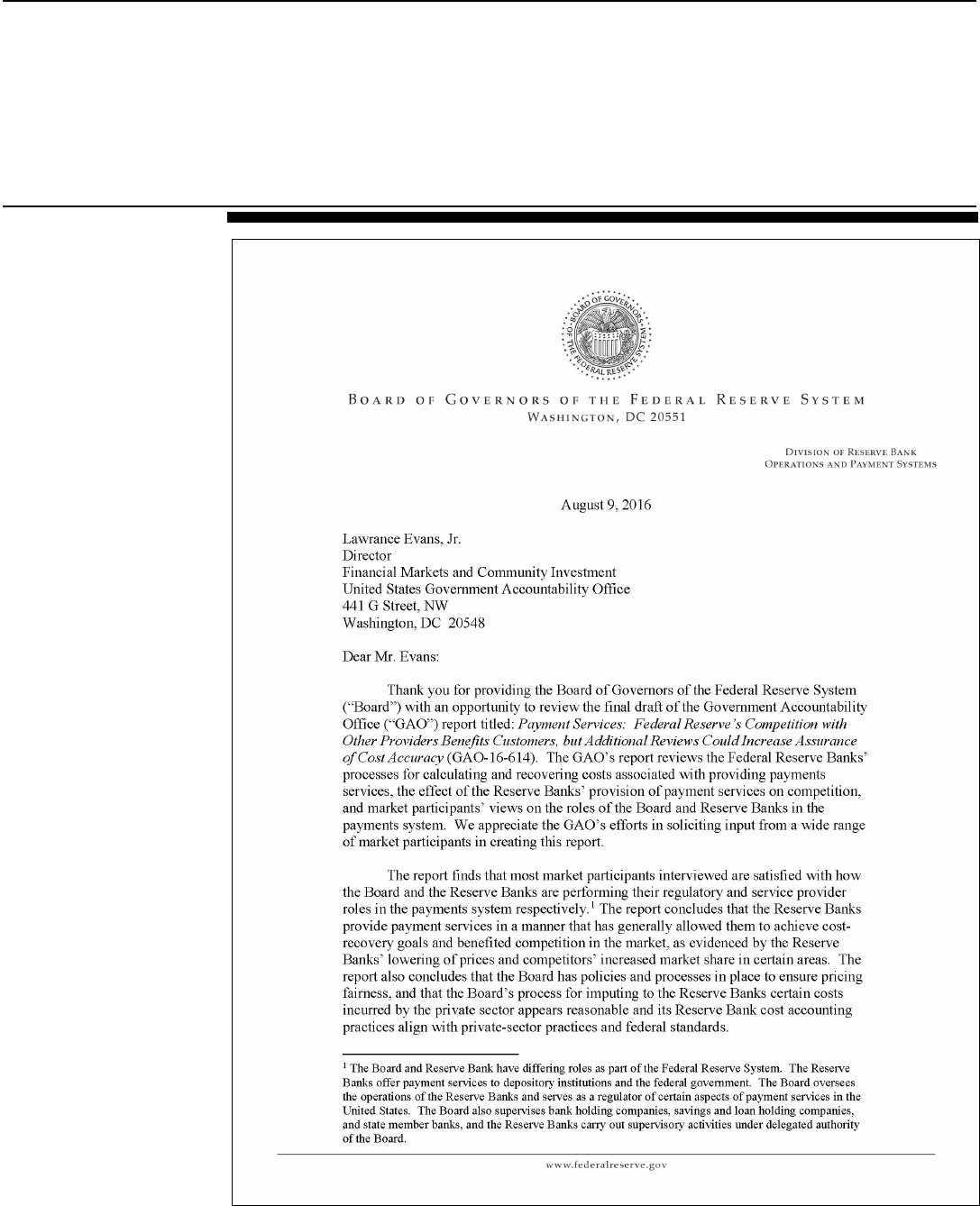
Appendix V: Comments from the Federal
Reserve
Page 83 GAO-16-614 Payment System Competition
AppendixV:CommentsfromtheFederal
Reserve
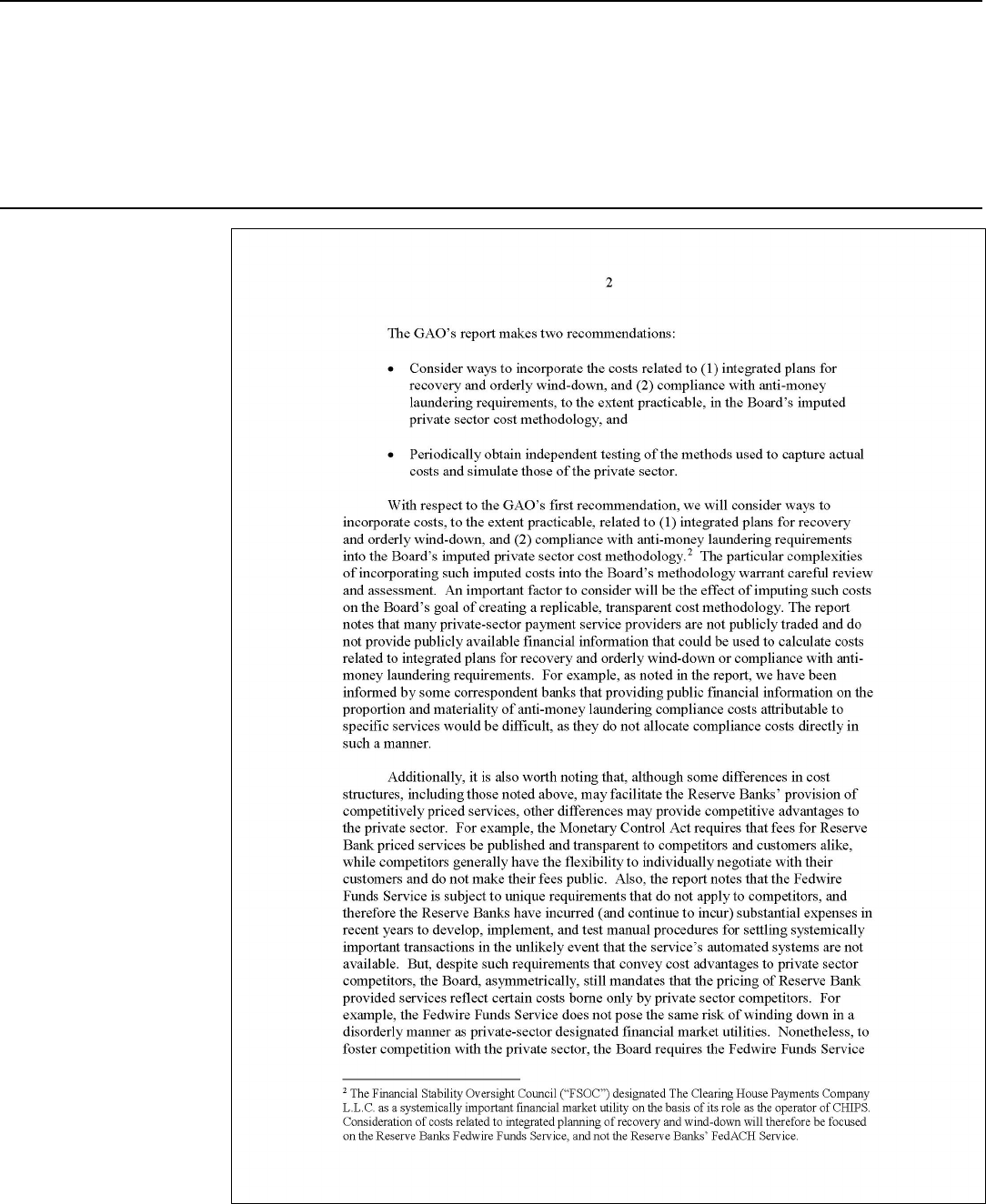
Appendix V: Comments from the Federal
Reserve
Page 84 GAO-16-614 Payment System Competition
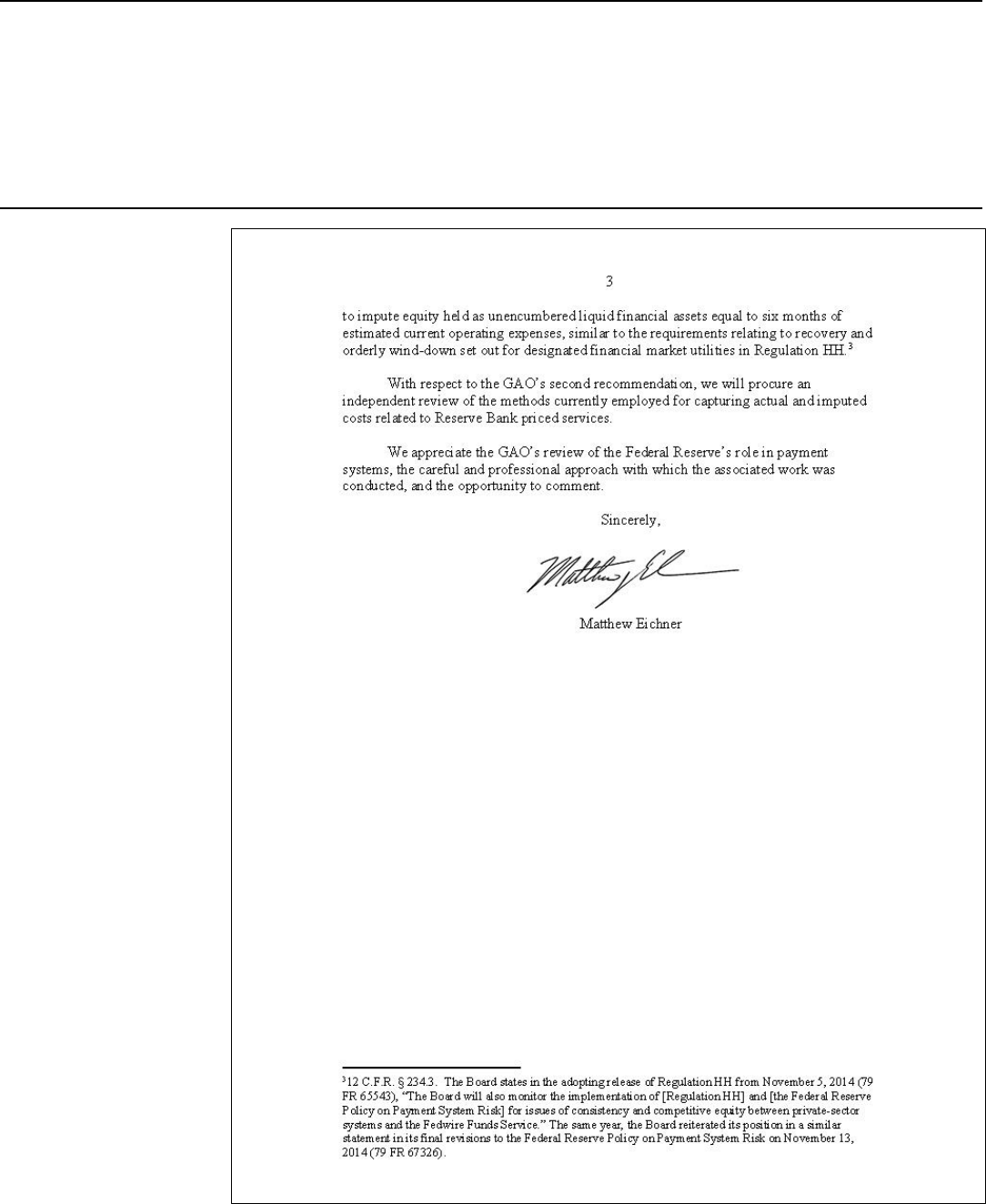
Appendix V: Comments from the Federal
Reserve
Page 85 GAO-16-614 Payment System Competition

Appendix VI: GAO Contact and Staff
Acknowledgments
Lawrance Evans, (202) 512-8678, or
In addition to the individual named above, Cody Goebel (Assistant
Director), Nathan Gottfried (Analyst-in-Charge), William R. Chatlos, A.
Nicole Clowers, Giselle Cubillos-Moraga, Robert Dacey, Simin Ho, John
Karikari, Paul Kinney, Risto Laboski, Marc Molino, Patricia Moye, Barbara
Roesmann, and Jason Wildhagen made major contributions to this report.
Page 86 GAO-16-614 Payment System Competition
AppendixVI:GAOContactandStaff
Acknowledgments
GAOContact
Staff
Acknowledgements
(250804)

Appendix VII: Accessible Data
Page 87 GAO-16-614 Payment System Competition
BOARD OF GOVERNORS OF THE FEDERAL RESERVE SYSTEM
WASHINGTON, DC 20551
DIVISION OF RESERVE BANK
OPERATIONS AND PAYMENT SYSTEM
August 9, 2016
Lawrance Evans, Jr.
Director
Financial Markets and Community Investment
United States Government Accountability Office
441 G Street, NW
Washington, DC 20548
Dear Mr. Evans:
Thank you for providing the Board of Governors of the Federal Reserve
System (“Board”) with an opportunity to review the final draft of the
Government Accountability Office (“GAO”) report titled: Payment
Services: Federal Reserve’s Competition with Other Providers Benefits
Customers, but Additional Reviews Could Increase Assurance of Cost
Accuracy (GAO-16-614). The GAO’s report reviews the Federal Reserve
Banks’ processes for calculating and recovering costs associated with
providing payments services, the effect of the Reserve Banks’ provision
of payment services on competition, and market participants’ views on the
AppendixVII:AccessibleData
AgencyComment
Letter
TextofAppendixV:
Commentsfromthe
FederalReserve
Page1

Appendix VII: Accessible Data
roles of the Board and Reserve Banks in the payments system. We
appreciate the GAO’s efforts in soliciting input from a wide range of
market participants in creating this report.
The report finds that most market participants interviewed are satisfied
with how the Board and the Reserve Banks are performing their
regulatory and service provider roles in the payments system
respectively.
Page 88 GAO-16-614 Payment System Competition
1
The report concludes that the Reserve Banks provide
payment services in a manner that has generally allowed them to achieve
cost- recovery goals and benefited competition in the market, as
evidenced by the Reserve Banks’ lowering of prices and competitors’
increased market share in certain areas. The report also concludes that
the Board has policies and processes in place to ensure pricing fairness,
and that the Board’s process for imputing to the Reserve Banks certain
costs incurred by the private sector appears reasonable and its Reserve
Bank cost accounting practices align with private-sector practices and
federal standards.
The GAO’s report makes two recommendations:
· Consider ways to incorporate the costs related to (1) integrated plans
for recovery and orderly wind-down, and (2) compliance with anti-
money laundering requirements, to the extent practicable, in the
Board’s imputed private sector cost methodology, and
· Periodically obtain independent testing of the methods used to
capture actual costs and simulate those of the private sector.
With respect to the GAO’s first recommendation, we will consider ways to
incorporate costs, to the extent practicable, related to (1) integrated plans
for recovery and orderly wind-down, and (2) compliance with anti-money
laundering requirements into the Board’s imputed private sector cost
1
The Board and Reserve Bank have differing roles as part of the Federal Reserve
System. The Reserve Banks offer payment services to depository institutions and the
federal government. The Board oversees the operations of the Reserve Banks and serves
as a regulator of certain aspects of payment services in the United States. The Board also
supervises bank holding companies, savings and loan holding companies, and state
member banks, and the Reserve Banks carry out supervisory activities under delegated
authority of the Board.
Page2

Appendix VII: Accessible Data
methodology.
Page 89 GAO-16-614 Payment System Competition
2
The particular complexities of incorporating such imputed
costs into the Board’s methodology warrant careful review and
assessment. An important factor to consider will be the effect of imputing
such costs on the Board’s goal of creating a replicable, transparent cost
methodology. The report notes that many private-sector payment service
providers are not publicly traded and do not provide publicly available
financial information that could be used to calculate costs related to
integrated plans for recovery and orderly wind-down or compliance with
anti- money laundering requirements. For example, as noted in the report,
we have been informed by some correspondent banks that providing
public financial information on the proportion and materiality of anti-
money laundering compliance costs attributable to specific services would
be difficult, as they do not allocate compliance costs directly in such a
manner.
Additionally, it is also worth noting that, although some differences in cost
structures, including those noted above, may facilitate the Reserve
Banks’ provision of competitively priced services, other differences may
provide competitive advantages to the private sector. For example, the
Monetary Control Act requires that fees for Reserve Bank priced services
be published and transparent to competitors and customers alike, while
competitors generally have the flexibility to individually negotiate with their
customers and do not make their fees public. Also, the report notes that
the Fedwire Funds Service is subject to unique requirements that do not
apply to competitors, and therefore the Reserve Banks have incurred
(and continue to incur) substantial expenses in recent years to develop,
implement, and test manual procedures for settling systemically important
transactions in the unlikely event that the service’s automated systems
are not available. But, despite such requirements that convey cost
advantages to private sector competitors, the Board, asymmetrically, still
mandates that the pricing of Reserve Bank provided services reflect
certain costs borne only by private sector competitors. For example, the
Fedwire Funds Service does not pose the same risk of winding down in a
disorderly manner as private-sector designated financial market utilities.
2
The Financial Stability Oversight Council (“FSOC”) designated The Clearing House
Payments Company L.L.C. as a systemically important financial market utility on the basis
of its role as the operator of CHIPS. Consideration of costs related to integrated planning
of recovery and wind-down will therefore be focused on the Reserve Banks Fedwire
Funds Service, and not the Reserve Banks’ FedACH Service.

Appendix VII: Accessible Data
Nonetheless, to foster competition with the private sector, the Board
requires the Fedwire Funds Service
to impute equity held as unencumbered liquid financial assets equal to six
months of estimated current operating expenses, similar to the
requirements relating to recovery and orderly wind-down set out for
designated financial market utilities in Regulation HH.
Page 90 GAO-16-614 Payment System Competition
3
With respect to the GAO’s second recommendation, we will procure an
independent review of the methods currently employed for capturing
actual and imputed costs related to Reserve Bank priced services.
We appreciate the GAO’s review of the Federal Reserve’s role in
payment systems, the careful and professional approach with which the
associated work was conducted, and the opportunity to comment.
Sincerely,
Matthew Eichner
Data Table for Figure 4: U.S. Noncash Payments by Transaction Type, 2000–2012
(billions)
2000
2003
2006
2009
2012
Debit
8.3
15.6
25
37.5
47
ACH
6.1
8.8
14.6
19.1
21.7
Checks
41.9
37.3
30.5
24.5
18.3
Credit cards total
15.6
19
21.7
21
26.2
Prepaid total
0
0
2.2
4
6.7
3
12 C.F.R. § 234.3. The Board states in the adopting release of Regulation HH from
November 5, 2014 (79 FR 65543), “The Board will also monitor the implementation of
[Regulation HH] and [the Federal Reserve Policy on Payment System Risk] for issues of
consistency and competitive equity between private-sector systems and the Fedwire
Funds Service.” The same year, the Board reiterated its position in a similar statement in
its final revisions to the Federal Reserve Policy on Payment System Risk on November
13, 2014 (79 FR 67326).
Page3
DataTables

Appendix VII: Accessible Data
Data Table for Figure 5: Rolling 10-year Average Cost Recovery Rates for Federal Reserve Payment Services, 1996-2015
Page 91 GAO-16-614 Payment System Competition
(percentage)
1996-2005
1997-2006
1998-2007
1999-2008
2000-2009
2001-2010
2002-2011
2003-2012
2004-2013
2005-2014
2006-
2015
98.4
99
99.1
98.7
97.8
97.9
98.6
99.5
102
102.9
102.6
Data Table for Figure 6: Federal Reserve Revenues by Payment Service, 2005–2014 (2015 Dollars in Millions)
2015 Inflation-Adjusted Dollars in Millions
2005
2006
2007
2008
2009
2010
2011
2012
2013
2014
Check
888.4
866.0
797.8
671.0
527.9
384.1
276.0
230.0
204.3
176.6
ACH
95.2
93.6
99.9
96.0
101.8
119.4
118.9
120.0
122.1
125.7
Fedwire
73.2
73.9
72.9
66.4
70.6
85.9
89.4
94.6
99.4
111.3
Data Table for Figure 7: Market Shares (Based on Dollar Volume) of Federal Reserve and Private-Sector Providers in Check,
Automated Clearing House (ACH), and Wire Transfer Payments, 2001–2013
Share
Mar/Apr 2001
Mar/Apr 2004
Mar/Apr 2007
Mar/Apr 2010
Mar 2013
Check
Reserve bank share
57%
53%
43%
48%
48%
Private sector share
43%
47%
57%
52%
52%
Share
2000
2003
2006
2009
2012
ACH Origination
FedACH share
86%
73%
58%
50%
49%
Private sector share
14%
27%
42%
50%
51%
Share
2000
2003
2006
2009
2012
ACH Receipt
FedACH share
87%
78%
65%
65%
63%
Private sector share
13%
22%
35%
35%
37%
Share
2000
2003
2006
2009
2012
Wire*
Fedwire share
64%
66%
63%
60%
58%
CHIPS share
36%
34%
37%
40%
42%
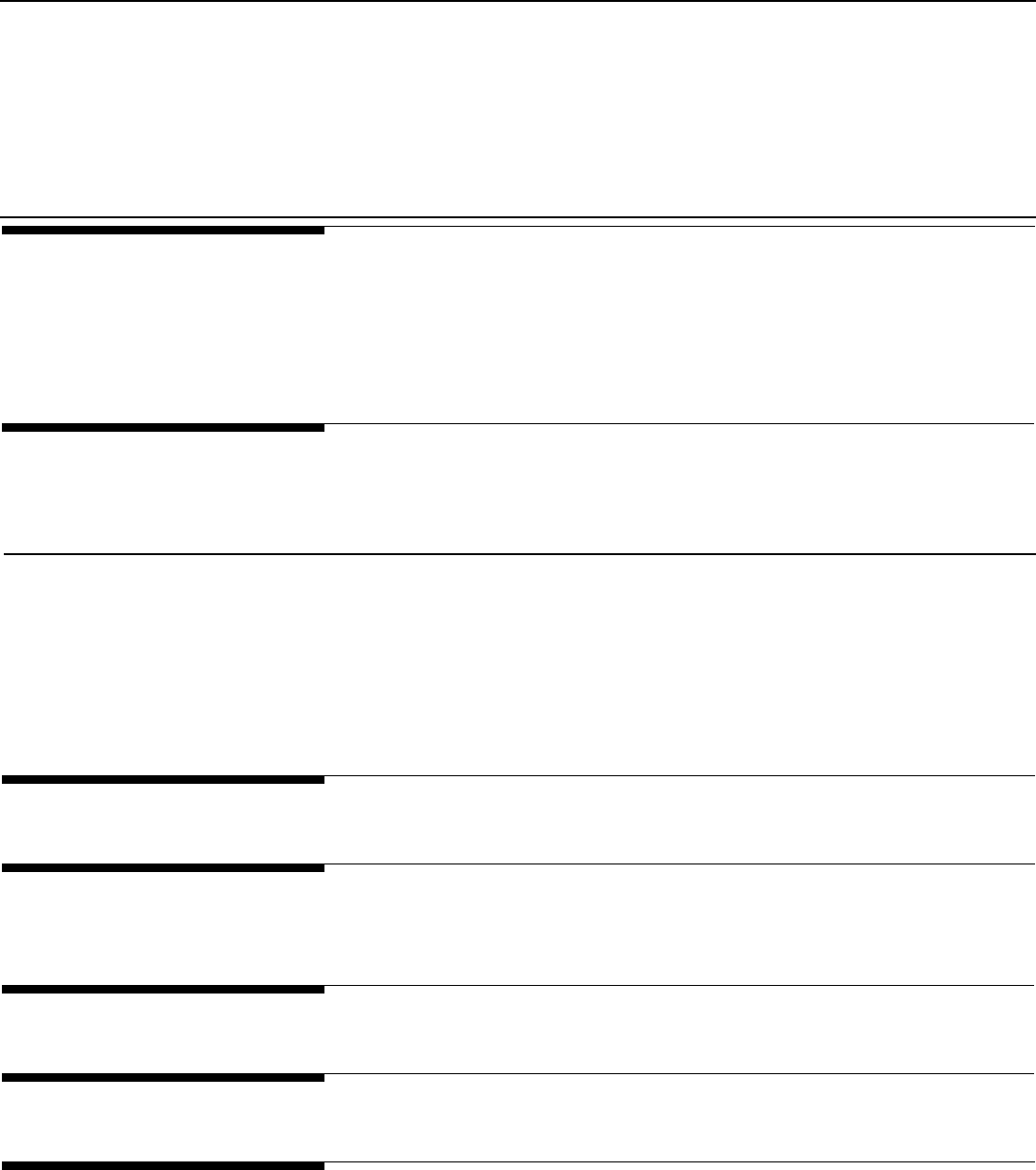
The Government Accountability Office, the audit, evaluation, and investigative
arm of Congress, exists to support Congress in meeting its constitutional
responsibilities and to help improve the performance and accountability of the
federal government for the American people. GAO examines the use of public
funds; evaluates federal programs and policies; and provides analyses,
recommendations, and other assistance to help Congress make informed
oversight, policy, and funding decisions. GAO’s commitment to good government
is reflected in its core values of accountability, integrity, and reliability.
The fastest and easiest way to obtain copies of GAO documents at no cost is
through GAO’s website (http://www.gao.gov). Each weekday afternoon, GAO
posts on its website newly released reports, testimony, and correspondence. To
have GAO e-mail you a list of newly posted products, go to http://www.gao.gov
and select “E-mail Updates.”
The price of each GAO publication reflects GAO’s actual cost of production and
distribution and depends on the number of pages in the publication and whether
the publication is printed in color or black and white. Pricing and ordering
information is posted on GAO’s website, http://www.gao.gov/ordering.htm.
Place orders by calling (202) 512-6000, toll free (866) 801-7077, or
TDD (202) 512-2537.
Orders may be paid for using American Express, Discover Card, MasterCard,
Visa, check, or money order. Call for additional information.
Connect with GAO on Facebook, Flickr, Twitter, and YouTube.
Subscribe to our RSS Feeds or E-mail Updates. Listen to our Podcasts.
Visit GAO on the web at www.gao.gov.
Contact:
Website: http://www.gao.gov/fraudnet/fraudnet.htm
E-mail: [email protected]
Automated answering system: (800) 424-5454 or (202) 512-7470
U.S. Government Accountability Office, 441 G Street NW, Room 7125,
Washington, DC 20548
Chuck Young, Managing Director, [email protected], (202) 512-4800
U.S. Government Accountability Office, 441 G Street NW, Room 7149
Washington, DC 20548
James-Christian Blockwood, Managing Director, [email protected], (202) 512-4707
U.S. Government Accountability Office, 441 G Street NW, Room 7814,
Washington, DC 20548
GAO’sMission
ObtainingCopiesof
GAOReportsand
Testimony
OrderbyPhone
ConnectwithGAO
ToReportFraud,
Waste,andAbusein
FederalPrograms
Congressional
Relations
PublicAffairs
StrategicPlanningand
ExternalLiaison
PleasePrintonRecycledPaper.
